|
Meinem Lehrer und Freund Prof. Dr. Heinrich von Stietencron ist die gesamte Amarakośa-Übersetzung in Dankbarkeit gewidmet. |
Zitierweise | cite as: Amarasiṃha <6./8. Jhdt. n. Chr.>: Nāmaliṅgānuśāsana (Amarakośa) / übersetzt von Alois Payer <1944 - >. -- 2. Dvitīyaṃ kāṇḍam. -- 15. vaiśyavargaḥ (Über Vaiśyas). -- 14. Vers 106c - 112b: Handel V: Handelsgüter III. -- Fassung vom 2011-10-06. -- URL: http://www.payer.de/amarakosa7/amara215n.htm
Erstmals hier publiziert: 2011-10-06
Überarbeitungen:
©opyright: Creative Commons Lizenz (Namensnennung, keine kommerzielle Nutzung, share alike)
Dieser Text ist Teil der Abteilung Sanskrit von Tüpfli's Global Village Library
|
Meinem Lehrer und Freund Prof. Dr. Heinrich von Stietencron ist die gesamte Amarakośa-Übersetzung in Dankbarkeit gewidmet. |
Falls Sie die diakritischen Zeichen nicht dargestellt bekommen, installieren Sie eine Schrift mit Diakritika wie z.B. Tahoma.
Die Devanāgarī-Zeichen sind in Unicode kodiert. Sie benötigen also eine Unicode-Devanāgarī-Schrift.
 WARNUNG: dies
ist der Versuch einer Übersetzung und Interpretation eines altindischen
Textes. Es ist keine medizinische Anleitung. Vor dem Gebrauch aller hier
genannten Heilmittel wird darum ausdrücklich gewarnt. Nur ein erfahrener,
gut ausgebildeter ayurvedischer Arzt kann Verschreibungen und Behandlungen
machen! Die Bestimmung der Pflanzennamen beruht weitgehend auf Vermutungen
kompetenter Āyurvedaspezialisten.
WARNUNG: dies
ist der Versuch einer Übersetzung und Interpretation eines altindischen
Textes. Es ist keine medizinische Anleitung. Vor dem Gebrauch aller hier
genannten Heilmittel wird darum ausdrücklich gewarnt. Nur ein erfahrener,
gut ausgebildeter ayurvedischer Arzt kann Verschreibungen und Behandlungen
machen! Die Bestimmung der Pflanzennamen beruht weitgehend auf Vermutungen
kompetenter Āyurvedaspezialisten.
| 106c./d. raṅga-vaṅge
atha picus tūlo 'tha kamalottaram रङ्ग-वङ्गे अथ पिचुस् तूलो ऽथ कमलोत्तरम् ।१०६ ख। [Bezeichnungen für Baumwolle:]
|
Colebrooke (1807): "Cotton."
पिचु - picu m.: Baumwolle (von Gossypium herbaceum L. 1753 oder Gossypium arboreum L. 1753)
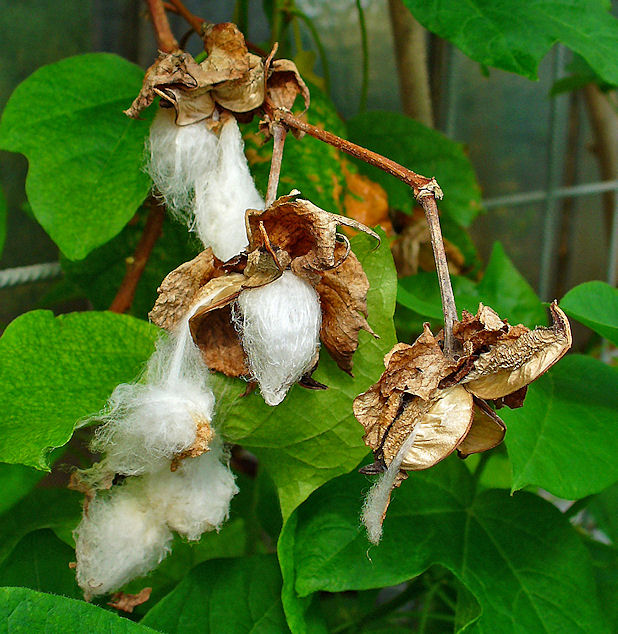
Abb.: पिचुः । Gossypium herbaceum L. 1753 - Gewöhnliche
Baumwolle
[Bildquelle: H. Zell / Wikimedia. -- GNU FDLicense]
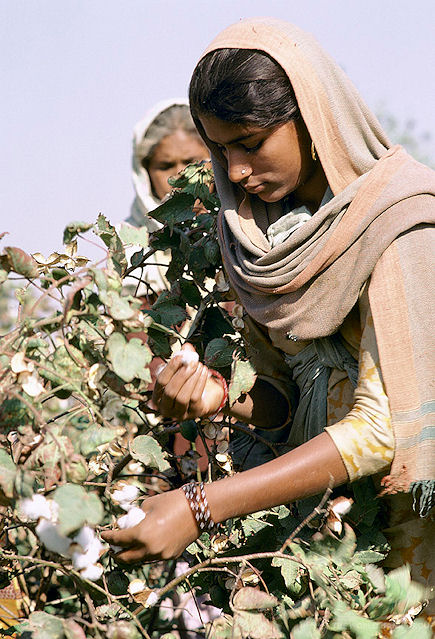
Abb.: पिचुः । Baumwollpflückerin, Indien
[Bildquelle: Ray Witlin / World Bank. --
http://www.flickr.com/photos/worldbank/2183935466/. -- Zugriff am
2011-10-03. --
Creative Commons Lizenz (Namensnennung, keine kommerzielle Nutzung,
keine Bearbeitung)]
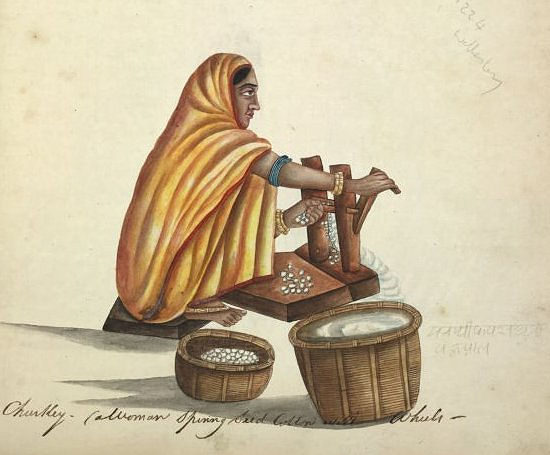
Abb.: पिचुः । Trennung der Baumwollfaser vom Samen, 1815/20
[Bildquelle: Wikimedia. -- Public domain]

Abb.: पिचुः । Gandhi beim Baumwoll-Spinnen, 192x
[Bildquelle: Wikimedia. -- Public domain]
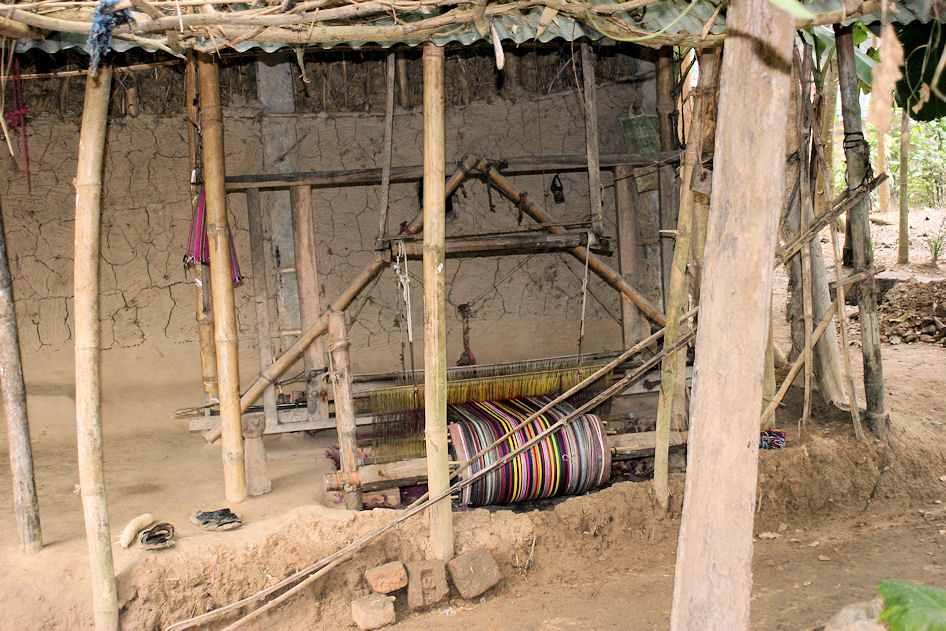
Abb.: पिचुः । Webstuhl, Gopalpur, Rajshahi - রাজশাহী, Bangladesh
[Bildquelle: Anduze traveller. --
http://www.flickr.com/photos/anduze-traveller/2317487305/. -- Zugriff am
2011-10-03. --
Creative
Commons Lizenz (Namensnennung, keine kommerzielle Nutzung, share alike)]
तूल - tūla m.: Flaum, Baumwolle (von Gossypium herbaceum L. 1753 oder Gossypium arboreum L. 1753)
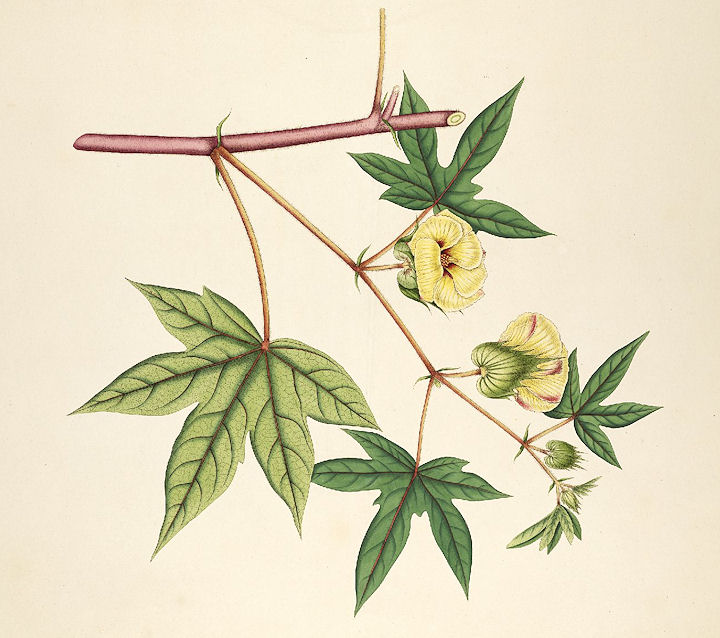
Abb.: तूलः । Gossypium herbaceum L. 1753 - Gewöhnliche
Baumwolle
[Bildquelle: Roxburgh. -- Vol III. -- 1819. -- Tab. 269. -- Image courtesy
Missouri Botanical Garden.
http://www.botanicus.org. --
Creative Commons Lizenz
(Namensnennung, keine kommerzielle Nutzung)]
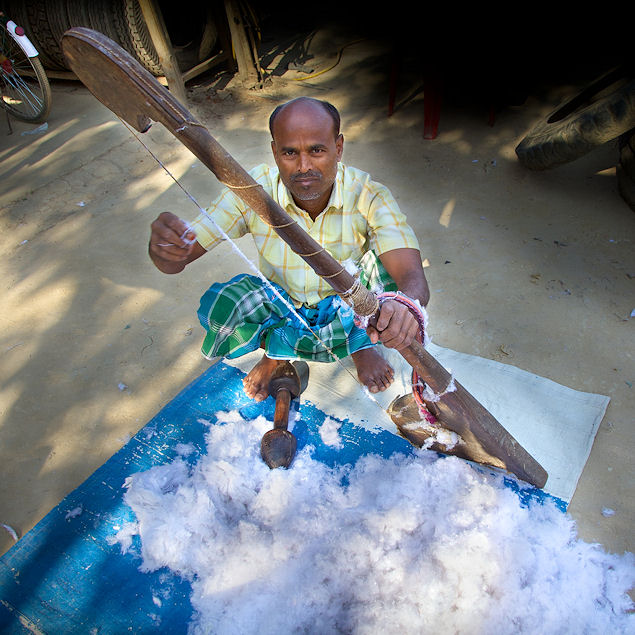
Abb.: तूलः । Zubereitung von Baumwolle für Matratzen, Nagaon -
নগাঁও, Assam
[Bildquelle: Michael Foley. --
http://www.flickr.com/photos/michaelfoleyphotography/5554982936/. --
Zugriff am 2011-10-03. --
Creative Commons
Lizenz (Namensnennung, keine kommerzielle Nutzung, keien Bearbeitung)]
"Cotton consists of the delicate, tubular, hair-like cells which clothe the seeds of species of gossypium. Its commercial value depends on the length and tenacity of these tubular hairs, which, in drying, become flattened, and are transparent, without joints, and twisted like a corkscrew. Under water, they appear like distinct, flat, narrow ribbons, with occasionally a transverse line, which indicates the end of cells.
In America, two distinct varieties are indigenous,— Gossypium Barbadense, yielding the cotton from the United States, and Gossypium Peruvianum or acuminatum, that which is produced in South America.
India also has two distinct species, —Gossypium herbaceum, or the common cotton of India, which has spread to the south of Europe, and Gossypium arboreum, or tree cotton, which yields none of the cotton of commerce.
Cotton plants have been characteristic of India from the earliest times ; and at the present day the majority of its people are clothed with fabrics made from cotton, which is woven to a large extent in India, but more largely in Europe and America.
[...]
The plant has always been grown in almost every district of India, for local use or export, in soils suitable and unsuitable to its growth ; and at the London Exhibition of 1862, the values of 138 samples exhibited ranged from sixpence to three shillings the pound.
Mr. Shaw says (p. 186, Cotton Export) cotton cultivation in India would not be a profitable speculation for Europeans ; the natives can grow it much cheaper. Our function is simply that of buyer. We have no local market for the American cotton. It does not answer for native spinning so well as their own.
The use of cotton dates from a very early period. Sanskrit records carry it back at least 2600 years, while in Peruvian sepulchres cotton cloth and seeds have been found. It is noticed in the book of Esther, i. 6, where its Sanskrit name Karpas is translated 'greens' in the English Bible. Herodotus and Ctesias notice it ; but it was not till the invasion of India by Alexander that the
Greeks were acquainted with the plant, as may be seen in Theophrastus, and also in Pliny. Pliny, writing about 500 years subsequent to the time of Herodotus, mentions (lib. 19, c. 1) that the upper part of Egypt, verging towards Arabia, produces a small shrub which some call gossypion, others xylon, and from the latter the cloth made from it, xylina, bearing a fruit like a nut, from the interior of which a kind of wool is produced, from which cloths are manufactured inferior to none for whiteness and softness, and therefore much prized by the Egyptian priesthood.
[...]
The Gossypium arboreum, or tree-cotton of India, and peculiar to India alone, is unfitted for manufacturing purposes, and is unknown to commerce, though yielding a beautifully soft and silky fibre, admirably adapted for padding cushions, pillows, etc.
In commerce, Indian cotton has usually been known under the names of the locality of its growth or place of shipment. The staple of these sorts appears to range from 0.85 to 1.1 of an inch in length ; the staple of the celebrated Sea Island cotton being usually 1.5 in length.
The three qualities by which the value of cottons are determined are, length of staple, strength of fibre, and cleanness of sample. Colour, which at one time was thought much of, is no longer looked upon as a matter of moment.
[...]
The cotton of India is allowed to be inferior as regards its staple and purity, but in durability it at least equals the produce of any part of America, and of this fact the Hindus are themselves perfectly aware. Dr. Royle gives 3 distinct varieties of cotton, all indigenous to Hindustan.
The common description is found scattered more or less throughout India, reared as a triennial or annual. It reaches the height of 5 or 6 feet in warm, moist climates. The seeds are five in number, clothed with a short greyish down. In the Peninsula there are two distinct varieties of this sort, known amongst the natives as Oopum and Nadum, The first thrives only on the richest black soil, and is an annual, producing a fine staple ; the latter is a triennial plant, and grows on the poorer rod soil, yielding small crops of inferior quality.
Second.—Dacca cotton is a distinct variety of the Gossypium Indicum. It differs from the previous variety in the plant being more erect, with fewer branches, and tinged with a reddish hue, whilst the cotton is finer, softer, and longer. This variety is reared more or less extensively throughout Bengal, especially in the Dacca district, where it is employed in the manufacture of the exquisitely fine muslin cloths known over a great part of the world as Dacca muslins, and whose delicacy of texture so long defied the imitation of the art-manufacturers of the West.
A third variety is the cotton grown in Berar, in the northern provinces of the Madras Presidency, and in Surat and Broach. This plant attains a greater size than the preceding, bears for a longer period, and produces a fibre of a finer quality than the former. It appears to thrive best on a light black soil.
Soil.—The soil in which all these Indian varieties thrive may be classed under two distinct heads, the black cotton soil and the red soil. The former of these, as its name indicates, is of a black or deep brown colour, absorbs and retains much rain, forming in the rains a heavy tenacious mass, and drying into solid lumps in the hot months. An analysis of this gives 74 per cent, of silex, 12 of carbonate of lime, 7¼ protoxide of iron, 3 of alumina, 2 of vegetable matter, and 1/3 salts, with a trace of magnesia. The red soil of India has been found in some localities better suited to the growth of cotton than the black earth. It is a rather coarse yellowish red soil, commingled with particles of the granitic rocks,—silex, felspar, and aluminous earth. It mainly differs in composition from the preceding in the iron existing in the state of peroxide or red oxide, whilst the carbonate of lime is found present in greater abundance.
[...]
Cotton-wool bears value according to its colour, length, strength, and fineness of fibre. Pure whiteness is generally held to denote a secondary quality ; whilst a yellowish tinge, provided it be not the result of casual exposure to damp, or the natural effect of an unfavourable season, is indicative of superior fineness. Many varieties of raw cotton are seen in commerce, each sort being distinguished by the name of the locality where it is produced. American, Bourbon, Egyptian, Amraoti, Dacca, Oopum, Nadura, Orleans, Sea Island, etc. etc. ; but the main distinction recognised is that between the long and short stapled qualities ; though of these, again, there are different degrees of excellence. The 'Sea Island' cotton of Georgia (so named from being raised on certain narrow sandy islets lying along the coast of that province) is esteemed the best of the long-stapled kind ; and the upland produce of the same state excels amongst the short-stapled classes. The indigenous Asiatic cotton is exclusively of the latter class.
The indigenous plant of India is an annual, and succeeds best in the rich black soil that characterizes various districts. The American plant, though in reality perennial, is practically an annual in India ; for in India neither native nor foreign cotton is cultivated on the same ground more than one year in three, it« properties being found to exhaust the productive powers of the soil. American cotton grows well on the black soil of India, but thrives still better on the light red lands.
Each of these species possesses advantages peculiar to itself. The Indian variety is capable of being manufactured into fabrics of extraordinary durability and wonderful fineness ; its colour, too, is superior, but the staple short.
[...]
The ordinary native cotton-cleaning machine, for freeing the cotton fibre from the seeds, has not yet been equalled by all the mechanical skill of Europe.
[...]
Indian cotton is somewhat difficult to spin, from its often breaking, and requiring more turns of the spindle, and from its shortness of fibre, than that of America. But the yarn made from a pound of East Indian cotton, which costs 3½d. sterling, will sell for 7d., while from the American, which costs 4½d. the pound, the yarn sells for 7¾d.
[...]
The largest consumption of cotton-wool is in the tropical countries. Americans consume 11½ pounds per head ; and it has been calculated that the British Indian people consume 10 pounds per head, but Great Britain only 4½ pounds per head.
[...]
In S. India the land should be well ploughed two or three times, and the deeper the better. All the weeds should be collected into heaps on the ploughed land and burnt, as the ashes make the best manure for cotton, and burning the soil improves its quality. Salt and lime are also good additions to a soil, as cotton requires chiefly alkalies and silicates for its nourishment. Animal and vegetable manures are injurious, as they breed insects, which destroy the roots, leaves, and young pods of the cotton. After the land has been well and deeply ploughed, it should be left for three or four days to get well aired ; it may again be ploughed into long ridges four to five feet apart. The seed is to be planted on the tops of these ridges carefully, at the depth of an inch or two and at the distance of five feet between each seed, for Oopuni, Naduni, or religious cotton ; [...] Cotton seed may be sown in any month of the year, but if there is no rain, it requires to be watered about three times; it germinates about the fifth day. If sown during the monsoon, the ridges must be eight inches high, and the water must be led away from the young plants, or they rot ; the seed must be sown on the top of the ridges. If the leaves begin to get pale or to shrivel up, the remedy is to dig trenches between the plants so as to let air in about the roots, but must not injure them. The uncultivated cotton plant lives for three or four years ; but it becomes dwarfed, and produces smaller leaves and smaller pods each year till it dies. In clay or cotton soils the plants do not attain nearly the size, nor do they produce such fine leaves or pods, as on sandy or loose soils. The cotton plants require sun, air, and moisture, but not so much of the last as of sun, light, and air at the roots ; the lighter and looser the soil, the more healthy is the plant. The best soil for cotton is a sandy soil with iron and salt ; or, if far from the sea, ashes of plants or of firewood may be used as a substitute for salt. When the cotton plants have attained the height of a foot, they do not require to be much watered ; once in ten days will be sufficient. Oopura or common country cotton varies from one to six feet in height, and covers from two to five feet of ground ; on cotton soils it seldom grows to more than two feet in height. [...]
Irrigation, in Assam, is generally unnecessary, though it may be found partially beneficial in dry and sandy soils, if judiciously applied.
Irrigation is not resorted to in the Benares, Allahabad, and Jubbulpur divisions, and the feeling is against its employment. In the N.W. Provinces the cotton crop is invariably irrigated, where a want of rain is likely to prove detrimental to the plant, and the process is not supposed to be in any way injurious to the fibre.
In most parts of the Madras Presidency artificial irrigation is not carried on ; this remark applies more particularly to Coimbatore, Madura, South Arcot, Bellary, Western Mysore, and Nellore. In Vizagapatam, on the other hand, the opinion is that irrigation would prove beneficial rather than injurious in seasons when rains fail or vary in their supply.
Artificial irrigation is almost unknown in the Bombay Presidency, Bcrar, and British Burma.
In some parts of the Panjab, cotton is irrigated from wells, and well water is considered better for the purpose than river or canal water. In other parts, more especially in the Jullundhur Doab, the best cotton is produced upon unirrigated lands, irrigation being very sparingly resorted to in tracts where water is abundant.
Artificial irrigation to cotton is rather the exception than the rule in most parts of India; [...]
In the Panjab, the localities best suited for the growth of cotton arc the submontane districts of Ambala, Hoshiarpur, Gujerat, and Peshawur. The time of sowing varies from February in the south, to the middle of June in some of the northern districts. The flowering commences according to locality, between August and December; the picking following about a month after the flowering, and continues at intervals for two months. There the average produce per acre, after the cotton is cleaned from its seed, is a little over one maund (or 80 lbs.), the rate varying from three maunds (240 lbs.) of raw cotton in the Hoshiarpur, to 16 seers (32 lbs.) of cleaned cotton in the Kangra district.
The Nurma-bun cotton is cultivated in small quantities all over Hindustan, and its produce is in great request for the manufacture of the best kind of Brahmanical thread. It is a bushy plant, grows to the height of about seven feet, and lasts about six years. It is cultivated all over Oudh, usually as a mixed crop, in light soils, with arhar (Cajanus Indica), or with kodo (Paspalum scrobiculatum), and often with maize. It is sown in the month of June, It is sown broadcast with the above, and nothing is done to until it begins to ripen the pods. The cotton is picked out of the shell, which is left on the tree. The proportion of staple produced is very small. It is generally on high lands, on which the rain water does not lie.
Agra, Rohilkhand, Meerut, and Allahabad are the great cotton-producing districts of the N.W. Provinces, and their average yield per acre is moderate. In Aligurh the sowing is in June and July, and gathering from October to end of December.
In Gorakhpur and the neighbouring districts, the indigenous sorts are called Kukti, Murwa, and Desi. The Kukti kind is sown in February, in calcareous soils, when the ground has been but slightly prepared ; it is picked in September and October. It is an annual, and the same ground is never used in two consecutive seasons Murwa cotton, if carefully tended, is triennial, or even quinquennial ; it is generally grown both in silicious (bangar) or calcareous (bhat) soils, as a border round sugar-cane or vegetable plots. The Desi or indigenous variety is common to all Gorakhpur and its neighbouring districts. It is sown in June, in ground but little prepared for its reception, and does not yield till the following April, It is an annual ; bears pods for six weeks only, and is then cut down.
In Bundelkhand cotton grows to great perfection, and its produce is of a softer texture and of a whiter colour than that of the Doab. The mar or maura black soil of the first quality is the most productive, yielding on the average 286 lbs. per acre. The punca soil of Bundelkhand is reddish, a mixture of sand and clay, and yields 191 lbs. per acre, 2-7ths being the proportion of cleaned cotton. Bankar is a light-coloured, sandy, gravelly soil, which yields 143 lbs. per acre, 1-5th of the produce being cleaned cotton. In Bundelkhand cotton is sown as a mixed crop in the beginning of the rains, and if the season is favourable, picking begins in the middle of September in the poorer soils, but not till the middle or end of October in the rich ones. Two ploughings and three weedings are necessary. The seed is rubbed in moist cow-dung, to serve as manure, and is sown broadcast. The cost of cultivation per acre is Rs. 9. After the removal of the fibre, the seed (binoula) finds a ready sale in E. Oudh at 50 or 60 seers the rupee.
Jaloun, Jhansi, and Bundelkhand lie to the westward of the Jumna, and have always been famed among the natives for their cotton.
Central India cotton has always been esteemed. The soil in many places is the black cotton soil. In some parts of Nagpur the field is tilled and manured with ashes and cow-dung before sowing. In pargana Booudoo, besides the common Kapas, there are two other sorts of cotton, called Tureea and Guteh. The former is sown in October, and picked in April and May, the field being tilled ten or twelve times before sowing. The latter is sown in July ; cotton is picked two or three times in April ; the trees last from three to four years, producing cotton every year, and they are 2½ yards high. This is grown by the poorest class in their own premises. The time of picking, speaking generally, is the whole of November and December, excepting in pargana Boondoo, where, as already stated above, the Tureea and Guteh or Gujar are picked in the months of April and May.
In Berar, the Chundelee, a very fine cotton fabric of India, so costly as to be used only in native courts, was made from Amraoti cotton. The chief care bestowed was on the preparation of the thread, which, when of very fine quality, sold for its weight in silver. The weavers work in a dark under-ground room, the walls of which are kept purposely damp, to prevent dust from flying about.
[..]
Hinginghat cotton is admittedly one of the best staples indigenous to India. It is, properly speaking, the produce of the rich Wardha valley, brought for sale to the Hinginghat market ; but in good deal of the cotton known in Bombay as Hinginghat is not really produced in the neighbourhood of the town, but is grown elsewhere, attracted to Hinginghat by the ready market there found ; thus some of inferior quality goes into the market at Hinginghat. [...]
The Bombai Presidency's best cotton districts are the Southern Mahratta country, about 16° N. lat., where experimental farms were established.
In Gujerat and Kattyawar districts, superior cottons have long been grown by the natives ; in consequence of which, these were selected as the sites of the northern experimental farms, much favourable land for the purpose being found between the latitudes of 21° and 24° N. The causes which favour the growth of cotton, esteemed both in India and England, in the tract of country extending from Surat and Ahmadabad, or from about lat. 21° and 23°, in a broad band across Malwa to Banda and Rajakhaira, in about 25° and 27°, near the banks of the Jumna, are no doubt physical. The black cotton soil which is spread over a great portion of this tract, has undoubtedly a considerable share in producing the result ; but good crops of cotton are produced in some parts where there is no black soil, as immediately on the banks of the Jumna and in the Doab.
[...]
Cotton, wheat, and bajra (Penicillaria spicata) all ripen in Gujerat at the same period of the year, about the end of February, and the cotton-picking continues to the middle of April. The first picking of cotton affords the best kind, the second is the most abundant, and the third is greatly inferior to the other two, both in quantity and in quality.
In Cuttack and Orissa there are two highland or upland varieties, the one called the Daloona, because the plants throw out numerous branches. The second kind of upland is called yellow, from the colour of the flowers; the flower of the Daloona being white. A third variety may be called the lowland, and is known locally as the Keda. The upland varieties are grown more or less all over the Gurjuto or Hill States, wherever a virgin forest soil exists. They are grown generally in the Sumbulpore district and its dependencies, throughout the Tributary States, and in Dhenkanal and Khoordah. A virgin forest soil is the only requisite for the successful cultivation of these varieties. The jungle is cut down, all the brushwood cleared, heaped and burnt on the spot, the stems and roots of the larger trees being left in the ground, which then receives a superficial ploughing. These clearings are called taela, and the cotton grown in them Taela cotton. These preparatory processes are attended to in Sumbulpore, Khoordah, and Dhenkanal, just before and during the first falls of rain, in the latter half of May and the first half of June, so that the plants shoot and grow and arrive at maturity through the rainy months. Dwarf paddy, sooa, Panicum Italicum, Eleusine coracana, bajra, or castor-oil, are sown with the cotton seed broadcast. The edible seed-crops in the third or fourth month are gathered as they ripen, then the ground is weeded and turned about. In January and February the cotton plants yield the first picking, and a month after the castor-oil seed ripens, and its plants are plucked and removed. Daloona cotton plants last for two or three years, and yield three pickings annually, and reach a height of 9 to 12 feet. With the yellow upland, it is not so generally the practice of sowing other crops.
The cultivation of the Keda or lowland variety of cotton is confined almost to the settled and open districts of Cuttack, Puri, and Balasore ; a little is raised in Dhenkanal and Khoordah. The best soil selected for this variety is dofuslee, or double crop. It is generally a light sandy soil, handy for irrigation purposes. The seed used throughout the district for lowland cotton is procured from Khoordah and Dhenkanal, it being alleged that none other will germinate in the lowland districts. It is placed in a pot, and soaked in dung and water for a night, and then dried by exposure to the sun on the following day. It is afterwards laid on straw, contained in an earthen vessel covered over with castor-oil leaves and placed near a fire. So soon as the seed splits and shoots it is planted, and watered at intervals of two, three, and four days. November and December are the usual months for the planting. The plants are annual, and attain a height of 4 to 6 feet. The cold weather showers falling occasionally in December, January, and February, favour the plants, and when plentiful, constitute a good season. The pickings are obtained continuously in April, May, and June. In the latter month all the bolls are picked off the plants, and after exposure to the sun, open. After the month of June, the lowland cotton plants are plucked up, and the land cleared for a pulse crop.
[...]
In Bellary cotton is grown in drills along with cholum or millet ; with the former, the drills are about six feet apart, and have from four to six rows of sorghum between each one of cotton; with the latter, the drills of cotton are only three feet apart, and have two rows of millet between them. When the crop of the millet is cut down, a very singular and sudden change occurs ; one day nothing is seen but yellow grain, which on the next disappears, and a thick crop of green cotton plants, about half a yard high, remains. [...]
In Vizagapatam, about lat. 17° N., very liberal pruning is practised, and the return is much greater than in any other of the Madras districts. In sandy soils near the sea, the Oopum cotton yields the more largely.
In Mysore, large belts of land in the northern and central taluks are deemed excellent for cotton culture.
[...]
In Ceylon, cotton is grown very generally both by the Singhalese and Tamil races, but upon no regular plan nor to any extent.
Bengal Presidency. — The indigenous cotton of Dacca has long been celebrated for its superior quality. It is cultivated along the banks of the Megna from Feringybazar to Edilpore in Bakarganj, a distance of about forty miles, on the banks of the Brahmaputra creek (the ancient channel of the river of the same name), and along the Luckia and Banar. It presents different shades of quality, the finest of which is named Photee, and is the material of which the delicate muslins are made. It was described by Roxburgh as differing from the common herbaceous cotton plant of Bengal in several particulars, chiefly in having a longer, finer, and softer fibre. It has, however, often been doubted whether the superiority of the Dacca manufacture was dependent on the skill of the workmen or he goodness of the cotton ; but, from Mr. Lamb's account, it appears to have been carefully cultivated. Probably both both had some influence; and it is certain that the workmen prefer the Dacca cotton, because, as Mr. Webb long ago explained, its thread does not swell in bleaching, as is the case with the cotton grown in Northwestern and Central India.
In Burdwan the Wesbee or native cotton plant is sown in the month Ashar. The soil is ploughed four or five times, the seed is kept in water for three or four days, is taken out on the day before it has to be sown, and is then mixed with ashes and cow-dung, and in this state is scattered over the ground, which is then again ploughed. Some cultivators, however, put four or five seeds small holes at the interval of about 1½ cubits. In the month of Magh (January—February), when the plants become ½ cubit high, they are watered. The picking of the Wesbee cotton is commenced in the month of Cheyt, corresponding with April, and finished in June and July (Joyte). Nurma cotton is cultivated in the month of Ashar, corresponding with June. The roots of the plants are well covered with earth. No irrigation is required, as nurma cotton is a rainy season plant. Its cotton is picked in November and December.
The Garo, Tiperah, and Chittagong hills produce a large quantity of inferior cotton, called Bhoga. It is used in the manufacture of the inferior kinds of hummum, bafta, boonee, saree, jore, etc., also for making ropes and tapes, and the coarsest of all fabrics, viz. garlia and guzeeh, which are commonly used for packing other cloths, and for covering dead bodies, for which purpose a large quantity of them is consumed annually both by Hindus and Mahomedans. A piece of guzeeh cloth, measuring 10 yards, could be purchased for 12 annas (eighteen pence), which is the one hundred and twenty-fifth part of the price paid for a piece of mulmul-i-khas of the same dimensions.
In Tirhut the cottons produced are of the kinds called Bhojra, Bhogla, and Kooktee; the two former ripen in April and May, the Kooktee ripens in September. The fabric manufactured from Kooktee cotton is not white, but of a stained white colour, white cotton being produced only from the Bhojra and Bhogla kinds.
The soil upon which the cotton plant in Cachar is grown, consists of a rich red clay, considerably mixed with sand, which forms the soil of the principal hills in the district, and also of the small ranges of hillocks that run through it. The cotton cultivation lies on the slopes of these hills and mountains, such lands being never inundated, although they are wonderfully retentive of moisture. The same hills and slopes became in great request for the cultivation of the tea plant, the soil being peculiarly adapted for its growth. The cotton seeds, together with others, are put in in March and April ; they are planted irregularly, but never closer than from 3 or 4 feet apart. The whole cultivation is weeded three or four times during the rains. The cotton flowers in July and August ; the picking commences in September, and is continued till December."
[Quelle: Balfour, Edward <1813-1889>: Cyclopædia of India and of eastern and southern Asia, commercial, industrial and scientific: products of the mineral, vegetable and animal kingdoms, useful arts and manufactures / ed. by Edward Balfour. -- 3rd ed. -- London: Quaritch. -- Vol. 1. -- 1885. -- S. 822 - 828.]
"COTTON MANUFACTURES. Amongst the goods which appear to have been brought to Europe from the Indian seas, in the days when Arab traders were the only medium of intercourse between the eastern and western worlds, we find mentioned cloths of silk and cotton of various colours and devices. It docs not appear, however, that there existed in Europe any great demand for cotton,—the consumption of the Roman people, who were then the customers for all luxuries, being chiefly confined to cloths of silk and wool. During the trade of Europeans with India by the long sea route, the calicoes and fine muslins of that country came into general notice; and until the production of machine-made fabrics in Britain, they continued to rise in public estimation. It was deemed a great thing with the Lancashire manufacturers, when, by the aid of mechanical and artistic skill, combined with the potent agency of steam, they found themselves able to produce an article which was considered equal to that which the unlettered Hindu had manipulated in his little mud hut on the remote banks of the Ganges, and which had been produced of like excellence by their ancestors, when the 'father of history ' penned his observations upon their countries. That the Hindus paid considerable attention to the details of this manufacture in the most remote ages, there remains sufficient proof on record. In the Indian work of highest antiquity the Rg Veda, believed to have been written fifteen centuries previous to the Christian era, occurs the following passage : 'Cares consume me, Satakralu ! although thy worshipper, as a rat gnaws a weaver's threads,'—the temptation to the rat being evidently the starch employed by the spinner to impart tenacity to the thread ; nor can there be any doubt that cotton was the thread alluded to. Again, in the Institutes of Menu, we find it directed as follows : 'Let the weaver who has received ten palas of cotton thread, give them back increased to eleven by the rice-water (starch) and the like used in weaving ; he who does otherwise shall pay a fine of twelve panas.' In recent times the cotton fabrics of India formed a considerable item in the exports from the East, during the early days of British Indian commerce ; the delicacy of their fabric, the elegance of their design, and the brilliancy of their colours, render them as attractive to the belter classes of consumers in Groat Britain, an are, in the present day, the shawls of Kashmir or the silks of Lyons. So much superrior, indeed, were the productions of the Indian spinning-wheel and handloom, to those turned out by the manufacturers of Lancashire in the middle of the 18th century, that not only were Indian calicoes and Indian prints preferred to the British-made articles, but the Manchester and Blackburn weavers actually imported Indian yarns in large quantities for employment in their factories. It was about the year 1771-72 that the Blackburn weavers, taking advantage of the discoveries and improvements of Arkwright, Hargreaves, and others, found themselves in a position to produce plain cotton goods, which, if they did not quite equal the fabrics of the East, at any rate found their way very rapidly into general consumption in Europe. The invention of the mule jenny in 1779 was the commencement of a new era in the history of the cotton manufacture of Great Britain ; and when, six years later, Arkwright's machines were thrown open to the public, a revolution was effected in the production of all kinds of yams. Great Britain found herself able not only to supply all her own wants with cotton goods of every variety of quality, but also to carry the produce of her looms 10,000 miles across the sea, and, placing them at the doors of the Indian consumer, undersell some kinds of the goods made by their own hands from cotton grown in his own garden. Nor is it only in the heavier goods that the West are able to beat out of their own markets the weaver of the East. There have been masters in their craft who produced fabrics more exquisitely delicate and light in texture than those beautiful muslins of Dacca, so long and justly celebrated with a world-wide fame. Although in some particulars these latter fabrics claim a certain degree of superiority, many of the Hindus prefer much of their own woven goods to those of Manchester and Glasgow ; and the cotton manufactures of British India have been steadily advancing in the out-turn of twist and yarn and piece-goods. It is generally believed that Manchester will fail to contend with the Indian mills in respect to the precise class of goods they are in the habit of turning out. The cotton mills of Bombay have made, since the date of their first starting in 1854, very rapid progress.
In the 25 years between 1857-58 and 1881-82, the value of all the cotton goods imported into British India from foreign countries rose from £5,726,018 to £20,772,098. Since 1868-69 the values of the twist and yarn and of the piece-goods have but little increased. In 1881-82 the twist and yarn was of value £32,220,648. British India has been latterly holding its own. The exports have consisted of cotton goods, including twist and yarn, and have risen from £637,651 in 1850-51, to £1,906,868 in 1881-82.
The yearly increasing exports from Europe misled exporters, for Europe had seldom been able to compete either with the delicate hand-made fibres which the Hindus and Mahomedans have been producing, or with the strong, coarse fabrics which the village weavers produce during the slack time of their agricultural pursuits. In the middle of the 19th century, British India also began to use machinery. In 1880 there were 58 cotton mills at work in British India, with 1,471,730 spindles, mules, and throstles, and 13,283 looms, turning out twist and yarn and cotton cloths, with a nominal capital of four millions sterling.
"With their rude implements the Hindus of Dacca formerly manufactured muslins, to which," as Dr. Ure observed, "European ingenuity can afford no parallel,—such, indeed, as has led a competent judge to say it is beyond his conception how this yarn, greatly finer than the highest number made m England, can be spun by the distaff and spindle, or woven by any machinery" (Ure"s Cotton Manufacture of Great Britain, i. p. 54).
The jawbone of the boalee fish (Silurus boalis), the teeth of which being fine, re-curved, and closely set, serves as a fine comb in removing minute particles of earthy and vegetable matter from the cotton. The Hindu spinner, with that inexhaustible patience which characterizes the race, sits down to the laborious task of cleaning with this instrument the fibres of each seed of cotton. Having accomplished this, she then separates the wool from the seeds by means of a small iron roller (dullun kathee), which is worked with the hands backward and forward, on a small quantity of the cotton seeds placed upon a flat board. The cotton is next bowed or teased with a small bow of bamboo, strung with a double row of catgut, muga silk, or the fibres of the plantain tree twisted together; and, having been reduced by this instrument to a state of light downy fleece, it is made up into a small cylindrical roll (puni), which is held in the hand during the process of spinning. The spinning apparatus is contained in a small basket or tray, not unlike the catheterae of the ancient Greeks. It consists of a delicate iron spindle (tukooa), having a small ball of clay attached to it, in order to give it sufficient weight in turning ; and of a piece of hard shell imbedded in a little clay, on which the point of the spindle revolves during the process of spinning. With this instrument the Hindu women almost rival Arachne's fabled skill in spinning. The thread which they make with it is exquisitely fine ; and -doubtless it is to their delicate organization and the sensibllity with which they are endowed by nature, that their inimitable skill in their art is to be ascribed. The finest thread is spun early in the morning, before the rising sun dissipates the dew on the grass, for such is the tenuity of its fibre, that it would break if an attempt were made to manufacture it during a drier and warmer portion of the day. The cohesive property of the filaments of cotton is impaired by high temperature accompanied with dryness of the air, and hence, when there is no dew on the ground in the morning to indicate the presence of moisture in the atmosphere, the spinners impart the requisite degree of humidity to the cotton, by making the thread over a shallow vessel of water.
A specimen which Dr. Taylor examined at Dacca in 1846 measured 1349 yards, and weighed only 22 grains, which is in the proportion of upwards of 250 miles to a pound weight of staple. During the process of preparing the thread, and before it is warped, it is steeped for a couple of days in fine charcoal powder, soot, or lampblack, mixed with water, and, after being well rinsed in clear water, wrung out, and dried in the shade, it is rubbed with a sizing made of parched rice (the husk of which has been removed by heated sand), fine lime, and water. The loom is light and portable ; its cloth and yarn beans, batten, templet, and shuttle are the appurtenances requisite for weaving.
Dacca was the seat of a manufacture of muslins known by its name, and spoken of by the ancients as 'woven webs of air.' The principal varieties of plain muslins manufactured at Dacca were Mulmul-i-Khas, Ab-rawan, Shab-nam, Khasa, Jhuna, Sircar Ali, Tanzeb, Alabullee, Nyan-zook, Baddan Khas, Turandam, Sarbutee, and Sarband, —names which either denote fineness, beauty, or transparency of texture, or refer to the origin of the manufacture of the fabrics, or the uses to which they are applied as articles of dress. The finest of all was the Mulmul-i-Khas (literally, muslin made for the special use of a prince or great personage). It was woven in half-pieces, measuring 10 yards in length and 1 yard in breadth, having 1900 threads in the warp, and weighing 10 siccas (about 3¾ ounces avoirdupois). The finest half-piece seen weighed 9 siccas, priced 100 rupees. Some of the other muslins were also beautiful productions of the loom, as Ab-rawan, compared by the natives from its clear pellucid texture to running water. Shab-nam, so named from its resemblance, when it is wetted and spread upon the bleaching field, to the evening dew on the grass. Jhuna, a light transparent net-like fabric, made for natives of rank and wealth, worn by the inmates of zenanas and dancers, and apparently the cloth referred to in the classics under the figurative names of Tela arenarum, Ventus textilis. All these muslins were made in full pieces of 20 yards in length by 1 in breadth, but varying considerably in the number of threads in the warp, and consequently in their weight. Of figured fabrics, as striped Dooria, chequered Charkhanee, and flowered Jamdanee, there exists a considerable variety, both in regard to quality and pattern. The flowered muslin was formerly in great demand both in India and Europe, and was the most expensive manufacture of the Dacca Urung, There was a monopoly of the finer fabrics for the court of Dehli ; those made for the emperor Aurangzeb cost 250 rupees per piece. This muslin is now seldom manufactured of a quality of higher value than 80 rupees per piece.
For the masses of the people, the British manufacturer sends to India the plain and striped Dooria, Mulmul, Aghabani, and other figured fabrics, which have established themselves there, and which, both from their good quality and moderate prices, are acceptable to the numerous classes who make use of them. Some of the chintzes of Masulipatam and of the south of India are as beautiful in design as they are chaste and elegant in colour.
Printed cloths are worn occasionally, as in Berar and Bundelkhand, for sarees ; and the ends and borders have peculiar local patterns. There is also a class of prints on coarse cloth, used for the skirts or petticoats of women of some of the poorer classes in Upper India ; but the greatest need of printed cloths is for the kind of bedcover called palempore (palangposh), or single quilts.
In the costlier cloths woven in India, the borders aiid ends are entirely of gold thread and silk, the former predominating. Many of the saree or women's cloths, made at Benares, Pytun, and Burhanpur, in Gujerat, at Narrainpet and Dhanwarum in the Hyderabad territory, at Yeokla in Kandesh, and in other localities, have gold thread in broad and narrow stripes alternating with silk or muslin. Gold flowers, checks, or zigzag patterns are used, the colours of the grounds being green, black, violet, crimson, purple, and grey ; and in silk, black shot with crimson or yellow, crimson with green, blue, or white, yellow with deep crimson and blue, all producing rich, harmonious, and even gorgeous effects, but without the least appearance of or approach to glaring colour, or offence to the most critical taste. They are colours and effects which suit the dark or fair complexions of the people of the country ; for an Indian lady who can afford to be choice in the selection of her wardrobe, is as particular as to what will suit her especial colour—dark or comparatively fair—as any lady of England or France. Another exquisitely beautiful article of Indian costume for men and women is the do-patta or scarf, worn more frequently by Mahomedan women than Hindu, and by the latter only when they have adopted the Mahomedan lunga or petticoat ; but invariably by men in dress costume. By women this is generally passed once round the waist over the petticoat or trousers, thence across the bosom and over the left shoulder and head ; by men, across the chest only.
The do-pattas, especially those of Benares, are perhaps the most exquisitely beautiful of all the ornamental fabrics of India ; and it is quite impossible to describe the effects of gold and silver thread, of the most delicate and ductile description imaginable, woven in broad, rich borders, and profusion of gold and silver flowers, or the elegance and intricacy of most of the arabesque patterns of the ribbon borders or broad stripes.
How such articles are woven at all, and how they are woven with their exquisite finish and strength, fine as their quality is, in the rude handlooms of the country, it is hard to understand. All these fabrics are of the most delicate and delightful colour,—the creamy white, and shades of pink, yellow, green, mauve, violet, and blue, are clear yet subdued, and always accord with the thread used, and the style of ornamentation, whether in gold or silver, or both combined. Many are of more decided colours—black, scarlet, and crimson, chocolate, dark green, and madder ; but whatever the colour may be, the ornamentation is chaste and suitable. For the most part, the fabrics of Benares are not intended for ordinary washing ; but the dyers and scourers of India have a process by which the former colour can be discharged from the fabric, and it can then be re-dyed. The gold or silver work is also carefully pressed and ironed, and the piece is restored, if not to its original beauty, at least to a very wearable condition.
The do-pattas of Pytun, and indeed most others except Benares, are, of a stronger fabric. Many of them are woven in fast colours, and the gold thread—silver is rarely used in them—is more substantial than that of Benares. On this account they are preferred in Central India and the Dekhan,—not only because they are ordinarily more durable, but because they bear washing or cleaning better. In point of delicate beauty, however, if not of richness, they are not comparable with the fabrics of Benares.
Scarfs are in use by every one,—plain muslins, or muslins with figured fields and borders without colour, plain fields of muslin with narrow edging of coloured silk or cotton (avoiding gold thread), and narrow end. Such articles, called sehla in India, are in everyday use among millions of Hindus and Mahomedans, men and women. They are always open-textured muslins, and the quality ranges from very ordinary yarn to that of the finest Dacca fibres. Comparatively few native women of any class or degree wear white ; if they do wear it, the dress has broad borders and ends. But what all classes wear are coloured cloths,—black, red, blue, occasionally orange and green, violet, and grey. All through Western, Central, and Southern India, sarees are striped and checked in an infinite variety of patterns. Narrainpet, Dhanwar, and Muktul, in the Nizam's territories ; Gudduk and Bettigerry in Dharwar ; Kolhapur, Nasik, Yeokla, and many other manufacturing towns in the Dekhan ; Arnee in the south, and elsewhere, send out articles of excellent texture, with beautifully arranged colours and patterns, both in stripes and checks. The costly and superb fabrics of cloths of gold and silver (kimkhab), and the classes of washing satins (mushroo and hemroo), even if European skill could imitate them by the handloom, it would be impossible to obtain the gold and silver thread unless they were imported from India. The native mode of making this thread is known, but the result achieved by the Indian workman is simply the effect of skilful and delicate manipulation. The gold and silver cloths (kimkhab) are used for state dresses and trousers, the latter by men and women ; and ladies of rank usually possess petticoats or skirts of these gorgeous fabrics. Mushroo and hemroo are not used for tunics, but for men's and women's trousers, and women's skirts ; as also for covering bedding and pillows. They are very strong and durable fabrics, wash well, and preserve their colour, however long worn or roughly used ; but they can hardly be compared with English satins, which, however, if more delicate in colour and texture, are unfitted for the purposes to which the Indian fabrics are applied. For example, a labada or dressing-gown, made of scarlet mushroo in 1842, has been washed over and over again, and subjected to all kinds of rough usage, yet the satin is still unfrayed, and the colour and gloss as bright as ever. Many of the borders of loongees, dhotees, and sarees are like plain silk ribbons, in some instances corded or ribbed, in others flat.
In Europe, it has been usual to name particular fabrics after the place of their manufacture, and this practice was extended to eastern products, as calico from Calicut, gauze from Gaza, muslin from Mosul, chintz from the Hindi chinte, spotted. In British India, however, the people name their woven fabrics from the form of their construction, their appearance, or the use to which they are applied. The cotton goods sent from Bombay to the Paris Exhibition of 1855, comprised bafta, boonee, carpets, chandni, choli, dastarkhau, dhoti, ek-patta, dopatta, dungari, khadi, lungee, pesfgir, phatka, pagga, quilts, razai, sailcloth, saree, soosi, turband, tablecloth, table napkins, and towels.
Omitting the second-rate kinds of cloth, which constitute the great bulk of the Dacca cotton manufacture, a class worthy of attention is that of fabrics of a mixed texture of cotton and silk. They are designated by various names, as nowbuttee, kutan, roomee apjoola, and lucka ; and, when embroidered with the needle, as many of them frequently are, they are called kusheeda. The silk used in their manufacture is the indigenous muga silk of Assam and Sylhet ; but the cotton thread employed is now almost entirely English yarn, of qualities varying from Nos. 30 to 80. These cloths are made exclusively for the Jedda and Bussora market ; and a considerable stock is yearly exported in the Arab vessels that trade between Calcutta and these ports. Pilgrims, too, from the vicinity of Dacca not unfrequently take an investment of them, which they dispose of at the great annual fair held at Meena, near Mecca. They are used by the Arabs chiefly for turbands and gowns. The golden colour of the muga silk gives to some of these a rich lustrous appearance. Pieces made of native-spun cotton thread and of the best kind of muga silk, would be admired in England.
In Ganjam is fabricated a cotton cloth, each side of a different colour. This effect is produced not by dyeing the cloth after it is woven, but by a dexterous manner of throwing the woof across the warp on either side. Madapollam and Ingeram used to be famous for cotton cloths, but since the abolition of the Company's trade, the finer panjaras have not been made. Palampores, as bed coverings, of the former place deserve attention. Very fine muslins are made at Oopada, north of Cocanada, and handsome turbans, with gold thread interwoven; but all these things are far surpassed by the Bengal fabrics. The Chicacole muslins are, however, prized by European ladies. Cotton cloths from Nellore consist of manufactured articles which find a ready sale in the markets of this Presidency."
[Quelle: Balfour, Edward <1813-1889>: Cyclopædia of India and of eastern and southern Asia, commercial, industrial and scientific: products of the mineral, vegetable and animal kingdoms, useful arts and manufactures / ed. by Edward Balfour. -- 3rd ed. -- London: Quaritch. -- Vol. 1. -- 1885. -- S. 829 - 832.]
"Gossypium Indicum (Linn.) N. O. Malvaceae. Indian Cotton plant [...]
Description.--Herbaceous ; [...]
Royle.
G. herbaceum, Linn.—Roxb. Fl. Ind. iii 184.—Royle. Ill. Him. Bot. t. 23, fig. 1.
Cultivated.
Economic Uses. — As flax is characteristic of Egypt, and the hemp of Europe, so cotton may truly be designated as belonging to India. Long before history can furnish any authentic account of this invaluable product, its uses must have been known to the inhabitants of this country, and their wants supplied from time immemorial, by the growth of a fleecy-like substance, covering the seeds of a plant, raised more perhaps by the bounty of Providence than the labour of mankind.
In Sanscrit, cotton is called kurpas, from whence is derived the Latin name carbasus, mentioned occasionally in Roman authors. This word subsequently came to mean sails for ships and tents. Herodotus says, talking of the products of India,—" And certain wild trees bear wool instead of fruit, that in beauty and quality exceeds that of sheep: and the Indians make their clothing from these trees" (iii. 106). And in the book of Esther (i. 6) the word green corresponds to the Hebrew kurpas, and is in the Vulgate translated carbasinu8. The above shows from how early a period cotton was cultivated in this country. "The natives," says Royle (alluding to its manufacture in India), " of that country early attained excellence in the arts of spinning and weaving, employing only their Angers and the spinning-wheel for the former; but they seem to have exhausted their ingenuity when they invented the hand- loom for weaving, as they have for ages remained in a stationary condition."
It has sometimes been considered a subject of doubt whether the cotton was indigenous to America as well as Asia, but without sufficient reason, as it is mentioned by very early voyagers as forming the only clothing of the natives of Mexico; and, as stated by Humboldt, it is one of the plants whose cultivation among the Aztec tribes was as ancient as that of the Agave, the Maize, and the Quinoa (Chenopodium). If more evidence be required, it may be mentioned that Mr Brown has in his possession cotton not separated from the seeds, as well as cloth manufactured from it brought from the Peruvian tombs; and it may be added that the species now recognised as American differ in character from all known Indian species (Royle).
Cotton is not less valuable to the inhabitants of India than it is to European nations. It forms the clothing of the immense population of that country, besides being used by them in a thousand different ways for carpets, tents, screens, pillows, curtains, &c. The great demand for cotton in Europe has led of late years to the most important consideration of improvements in its cultivation. The labours and outlay which Government has expended in obtaining so important an object have happily been attended with the best results. The introduction of American seeds and experimental cultivation in various parts of India have been of the greatest benefit. They have been the means of producing a better article for the market, simplifying its mode of culture, and proving to the Ryots how, with a little care and attention, the article may be made to yield tenfold, and greatly increase its former value. To neither the soil nor the climate can the failure of Indian cotton be traced: the want of easy transit, however, from the interior to the coast, the ruinous effect of absurd fiscal regulations, and other influences, were at work to account for its failure. In 1834, Professor Boyle drew attention to two circumstances : " I have no doubt that by the importation of foreign, and the selection of native seed—attention to the peculiarities not only of soil but also of climate, as regards the course of the seasons, and the temperature, dryness, and moisture of the atmosphere, as well as attention to the mode of cultivation, such as preparing the soil, sowing in lines so as to facilitate the circulation of air, weeding, ascertaining whether the mixture of other crops with the cotton be injurious or otherwise, pruning, picking the cotton as it ripens, and keeping it clean—great improvement must take place in the quality of the cotton. Experiments may at first be more expensive than the ordinary culture; the natives of India, when taught by example, would adopt the improved processes as regularly and as easily as the other; and as labour is nowhere cheaper, any extra outlay would be repaid fully as profitably as in countries where the best cottons are at present produced."
The experiments urged by so distinguished an authority were put in force in many parts of the country, and notwithstanding the great prejudice which existed to the introduction of novelty and other obstacles, the results have proved eminently successful. It has been urged that Indian cotton is valuable for qualities of its own, and especially that of wearing well. It is used for the same purposes as hemp and flax, hair and wool, are in England. There are, of course, a great many varieties in the market, whose value depends on the length, strength, and fineness as well as softness of the material, the chief distinction being the long stapled and the short stapled. Cotton was first imported into England from India in 1783, when about 114,133 lb. were received. In 1846, it has been calculated that the consumption of cotton for the last 30 years has increased at the compound ratio of 6 per cent, thereby doubling itself every twelve years. The chief parts of India where the cotton plant is cultivated are in Guzerat, especially in Surat and Broach, the principal cotton districts in the country; the southern Mahratta countries, including Dharwar, which is about a hundred miles from the seaport; the Concans, Canara, and Malabar. There has never been any great quantity exported from the Madras side, though it is cultivated in the Salem, Coimbatore, and Tinnevelly districts, having the port of Tuticorin on one coast, and of late years that of Cochin on the other, both increasing in importance as places of export In the Bengal Presidency, Behar and Benares, and the Saugor and Nerbudda territories, are the districts where it is chiefly cultivated.
The present species and its varieties are by far the most generally cultivated in India. Dacca cotton is a variety chiefly found in Bengal, furnishing that exceedingly fine cotton, and employed in manufacturing the very delicate and beautiful muslins of that place, the chief difference being in the mode of spinning, not in any inherent virtue in the cotton or soil where it grows. The Berar cotton is another variety with which the N. Circar long-cloth is made. This district, since it has come under British rule, promises to be one of the most fertile and valuable cotton districts in the whole country.
Much diversity of opinion exists as to the best soil and climate adapted for the growth of the cotton plant; and considering that it grows at altitudes of 9000 feet, where Humboldt found it in the Andes, as well as at the level of the sea, in rich black soil and also on the sandy tracts of the sea-shore, it is superfluous to attempt specifying the particular amount of dryness or moisture absolutely requisite to insure perfection in the crop. It seems to be a favourite idea, however, that the neighbourhood of the sea-coast and islands are more favourable for the cultivation of the plant than places far inland, where the saline moisture of the sea-air cannot reach. But such is certainly not the case in Mexico and parts of Brazil, where the best districts for cotton-growing are far inland, removed from the influence of sea-air. Perhaps the different species of the plant may require different climates. However that may be, it is certain that they are found growing in every diversity of climate and soil, even on the Indian continent; while it is well known that the best and largest crops have invariably been obtained from island plantations, or those in the vicinity of the sea on the mainland.
A fine sort of cotton is grown in the eastern districts of Bengal for the most delicate manufactures; and a coarse kind is gathered in every part of the province from plants thinly interspersed in fields of pulse or grain. Captain Jenkins describes the cotton in Cachar as gathered from the Jaum cultivation : this consists in the jungle being burnt down after periods of from four to six years, the ground roughly hoed, and the seeds sown without further culture. Dr Buchanan Hamilton, in his statistical account of Dinagepore, gives a full account of the mode of cultivation in that district, where he says some cotton of bad quality is grown along with turmeric, and some by itself, which is sown in the beginning of May, and the produce collected from the middle of August to the middle of October, but the cultivation is miserable. A much better method, however, he adds, is practised in the south-east parts of the district, the cotton of which is finer than that imported from the west of India: The land is of the first quality, and the cotton is made to succeed rice, which is cut between August and the middle of September. The field is immediately ploughed until well broken, for which purpose it may require six double ploughings. After one-half of these has been given, it is manured with dung, or mud from ditches. Between the middle of October and the same time in November, the seed is sown broadcast; twenty measures of cotton and one of mustard. That of the cotton, before it is sown, is put into water for one-third of an hour, after which it is rubbed with a little dry earth to facilitate the sowing. About the beginning of February the mustard is ripe, when it is plucked and the field weeded. Between the 12th of April and 12th of June the cotton is collected as it ripens. The produce of a single acre is about 300 lb. of cotton, worth ten rupees; and as much mustard-seed, worth three rupees. A still greater quantity of cotton, - Dr Hamilton continues, is reared on stiff clay-land, where the ground is also high and tanks numerous. If the soil is rich it gives a summer crop of rice in the same year, or at least produces the seedling rice that is to be transplanted. In the beginning of October the field is ploughed, and in the end of the month the cotton-seed is sown, mingled with Sorisha or Lara (species of Sinapis and Eruca); and some rows of flax and safflower are generally intermixed. About the end of January, or later, the oil-seeds are plucked, the field is hoed and manured with cow-dung and ashes, mud from tanks, and oil-cake; it is then watered once in from eight to twelve days. The cotton is gathered between the middle of April and the middle of June, and its produce may be from 360 to 500 lb. an acre.
In the most northern provinces of India the greatest care is bestowed on the cultivation. The seasons for sowing are about the middle of March and April, after the winter crops have been gathered in, and again about the commencement of the rainy season. The crops are commenced being gathered about the conclusion of the rains, and during October and November, after which the cold becomes considerable, and the rains again severe. About the beginning of February the cotton plants shoot forth new leaves, produce fresh flowers, and a second crop of cotton is produced, which is gathered during March and beginning of April. The same occurs with the cottons of Central India, one crop being collected after the rains and the other in February, and what is late in the beginning of March.
I venture to insert here the following interesting particulars about cotton manufacture : " The shrub Perutti, which produces the finer kind of cotton, requires in India little cultivation or care. When the cotton has been gathered it is thrown upon a floor and threshed, in order that it may be separated from the black seeds and husks which serve it as a covering. It is then put into bags or tied up in bales containing from 300 to 320 lb. of 16 oz. each. After it has been carded it is spun out into such delicate threads that a piece of cotton cloth 20 yards in length may almost be concealed in the hollows of both hands. Most of these pieces of cloth are twice washed; others remain as they come from the loom, and are dipped in cocoa-nut oil in order that they may be longer preserved. It is customary also to draw them through conjee or rice-water, that they may acquire more smoothness and body. This conjee is sometimes applied to cotton articles in so ingenious a manner that purchasers are often deceived, and imagine the cloth to be much stronger than it really is; for as soon as washed the conjee vanishes, and the cloth appears quite slight and thin.
"There are reckoned to be no less than 22 different kinds of cotton articles manufactured in India, without including muslin or coloured stuffs. The latter are not, as in Europe, printed by means of wooden blocks, but painted with a brush made of coir, which approaches near to horse-hair, becomes very elastic, and can be formed into any shape the painter chooses. The colours employed are indigo (Indigofera tinctoria), the stem and leaves of which plant yield that beautiful dark blue with which the Indian chintzes, coverlets, and other articles are painted, and which never loses the smallest shade of its beauty. Also curcuma or Indian saffron, a plant which dyes yellow; and lastly, gum-lac, together with some flowers, roots, and fruits which are used to dye red. With these few pigments, which are applied sometimes singly, sometimes mixed, the natives produce on their cotton cloths that admirable and beautiful painting which exceeds anything of the kind exhibited in Europe.
" No person in Turkey, Persia, or Europe has yet imitated the Betilla, a certain kind of white East Indian chintz made at Masulipatam, and known under the name of Organdi. The manufacture of this cloth, which was known in the time of Job, the painting of it, and the preparation of the colours, give employment in India to male and female, young and old. A great deal of cotton is brought from Arabia and Persia and mixed with that of India."—Bart. Voy. to East Indies.
The remaining uses of this valuable plant must now claim our attention. The seeds are bruised for their oil, which is very pure, and is largely manufactured at Marseilles from seeds brought from Egypt. These seeds are given as a fattening food to cattle. Cottonseed cake is imported from the West Indies into England, being used as a valuable food for cattle. The produce of oil-cake and oil from cotton-seeds is, 2 gallons of oil to 1 cwt. of seeds, and 96 lb. of cake. A great quantity is shipped from China, chiefly from Shanghai, for the English market. It forms an invaluable manure for the farmer.—Royle on Cotton Cultivation. Simmonds. Lindley. Roxb."
[Quelle: Drury, Heber <1819 - 1872>: The useful plants of India : with notices of their chief value in commerce, medicine, and the arts. -- 2d ed. with additions and corrections. London : Allen, 1873. -- xvi, 512 p. ; 22 cm. -- s.v.]
"GOSSYPIUM STOCKSII, Mast., var.herbaceum, Linn.
Fig.—Wight Ic, t. 9,11 ; Royle Ill. t. 23.
Cotton plant
Hab.--Sindh. Cultivated in most hot coutries.
[...]
History, Uses, &c.—Cotton, the Karpasi of Sanskrit writers, was doubtless first known and made use of by the Hindus; it is the βυσσος of the later Greek writers, such as Philostratus and Pausanias, but not of the earlier Greeks, who applied this term to a fine kind of flax used for making mummy cloths. Theophrastus calls it Eriophora, Pliny Gossympinus, Gossypion, and Xylinum. In Arabic cotton is kuttun and kurfuss, the latter term being evidently derived from the Sanskrit. Eastern physicians consider all parts of the cotton plant to be hot and moist; a syrup of the flowers is prescribed in hypochondriasis on account of its stimulating and exhilarant effect; a poultice of them is applied to burns and scalds. Cotton cloth or mixed fabrics of cotton with wool or silk are recommended as the most healthy for wear. Burnt cotton is applied to sores and wounds to promote healthy granulation ; dropsical or paralysed limbs are wrapped in cotton after the application of a ginger or zedoary lep (plaster); pounded cotton seed, mixed with ginger and water, is applied in orchitis. Cotton is also used as a moxa, and the seeds as a laxative, expectorant, and aphrodisiac. -The juice of the leaves is considered a good remedy in dysentery, and the leaves with oil are applied as a plaster to gouty joints ; a hip bath of the young leaves and roots is recommended in uterine colic. In the Concan the root of the Deokapas (fairy or sacred cotton bush) rubbed to a paste with the juice of patchouli leaves, has a reputation as a promoter of granulation in wounds, and the juice of the leaves made into a Paste with the seeds of Vernonia anthelmintica is applied to eruptions of the skin following fever. In Pudukota the leaves ground and mixed with milk are given for strangury.
Cotton root bark is official in the United States Pharmacopoeia, also a fluid extract of the bark ; it appears to have first attracted attention from being used by the female negroes to produce abortion. There appears to be little doubt that it acts like ergot upon the uterus, and is useful in dysmenorrhea and suppression of the menses when produced by cold; a decoction of 4 ounces of the bark in two pints of water boiled down to one pint may be used in doses of two ounces every 20 or 30 minutes, or the fluid extract may be prescribed in doses of from 30 to 60 minims. Cotton seed tea is given in dysentery in America; the seeds are also reputed to be galactagogue. (Stillé and Maisch., Nat. Disp., p. 678.) By treating cotton first with a dilute alkali, then with a 5 per cent, solution of chloride of lime, and lastly with water acidulated with hydrochloric acid, and afterwards well washing it with water, it loses its greasiness and becomes absorbent and a valuable dressing for wounds; this absorbent cotton may be medicated by sprinkling it with solutions of carbolic acid, salicylic acid, boracic acid, &c. Pyroxylin or Gun Cotton is made by dipping cotton into a mixture of equal parts of nitric and sulphuric acids, washing freely with water, and drying."
[Quelle: Pharmacographia indica : a history of the principal drugs of vegetable origin met with in British India / by William Dymock [1834-1892], C. J. H. Warden and David Hooper [1858-1947]. -- Bd. 1. -- London, 1890. -- S. 224ff.]
| 106c./d. raṅga-vaṅge atha picus tūlo
'tha kamalottaram 107a./b. syāt kusumbhaṃ vahniśikhaṃ mahārajanam ity api
रङ्ग-वङ्गे अथ पिचुस् तूलो
ऽथ कमलोत्तरम् ।१०६ ख। [Bezeichnungen für Färberdistel - Carthamus tinctorius L. 1753:]
|
Colebrooke (1807): "Safflower ; carthamus."
कमलोत्तर - kamalottara n.: dem Lotus überlegen, Färberdistel
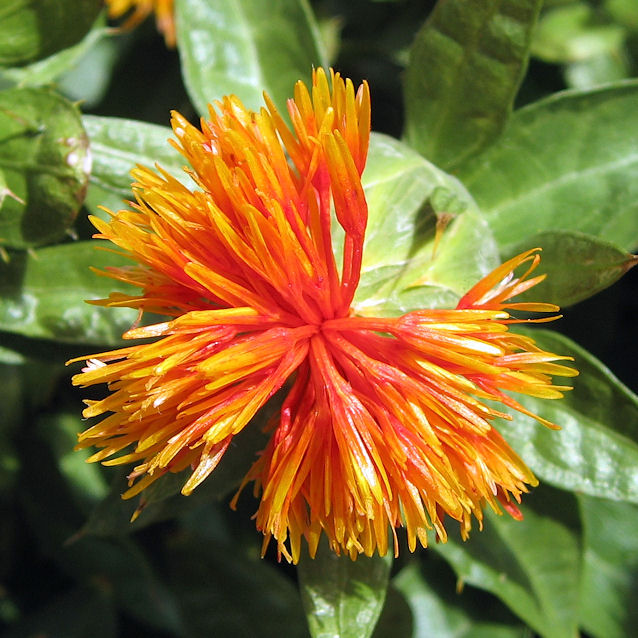
Abb.: कमलोत्तरम् । Carthamus tinctorius L. 1753 - Färberdistel -
Dyer's Saffron, USA
[Bildquelle: Shihmei Barger 舒詩玫. --
http://www.flickr.com/photos/beautifulcataya/3762455663/. -- Zugriff am
2011-10-03. --
Creative Commons Lizenz (Namensnennung, keine kommerzielle Nutzung,
keine Bearbeitung)]
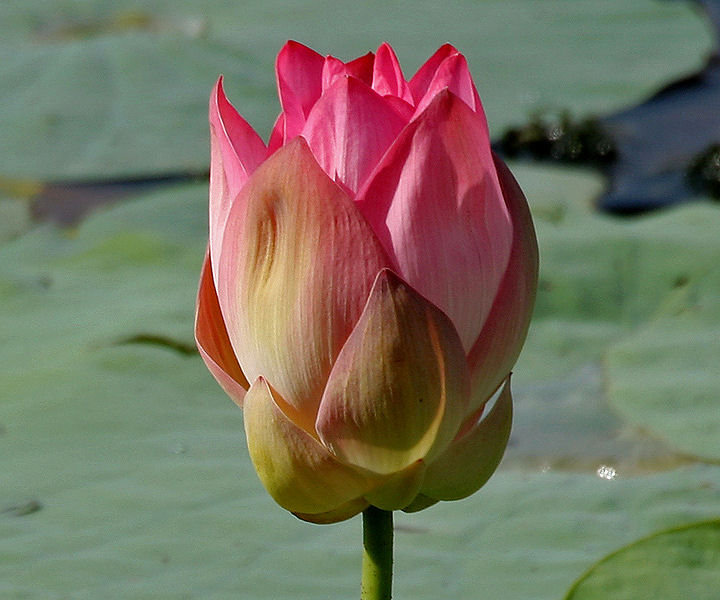
Abb.: Zum Vergleich: Lotus - Nelumbo nucifera Gaertn 1788, Hyderabad
- హైదరాబాద్,
Andhra Pradesh
[Bildquelle: J. M. Garg / Wikimedia. -- GNU FDLicense]
कुसुम्भ - kusumbha n.: Färberdistel, Krug
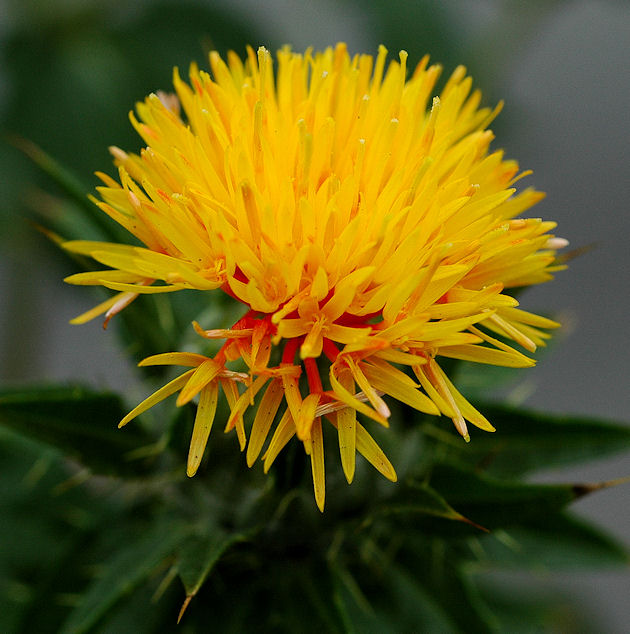
Abb.: कुसुम्भम् । Carthamus tinctorius L. 1753 - Färberdistel -
Dyer's Saffron, Japan
[Bildquelle: Wikimedia. -- Public domain]
वह्निशिख - vahniśikha n.: Feuerflamme
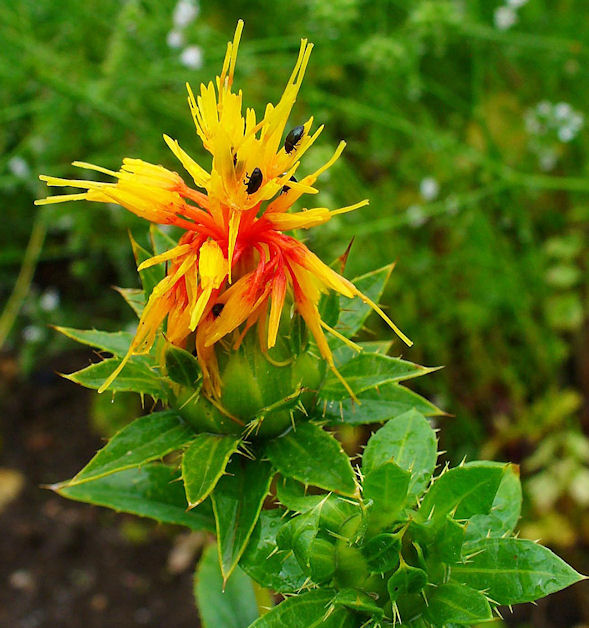
Abb.: वह्निशिखम् । Carthamus tinctorius L. 1753 - Färberdistel -
Dyer's Saffron, Deutschland
[Bildquelle: H. Zell / Wikimedia. -- GNU FDLicense]
महारजन - mahārajana n.: große Farbe
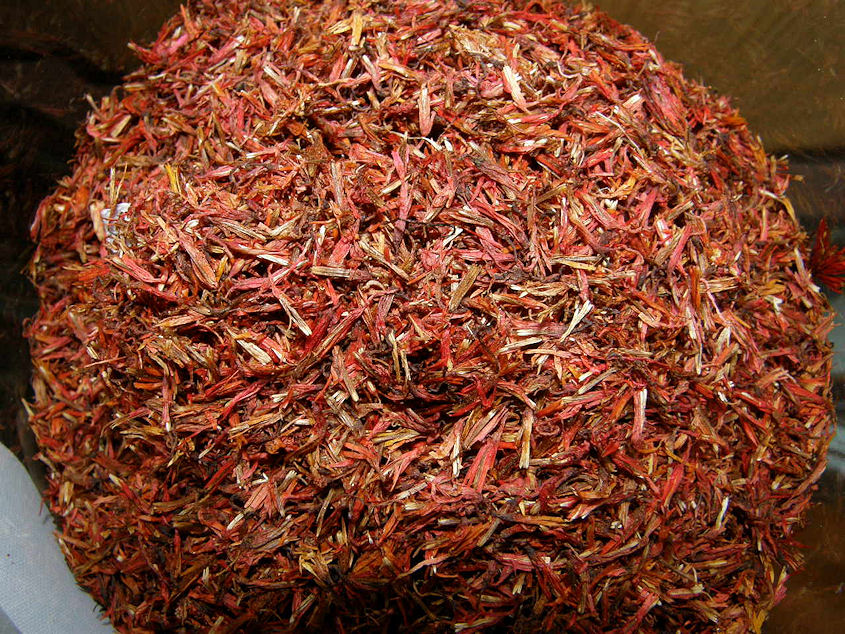
Abb.: महारजनम् । Carthamus tinctorius L. 1753 - Färberdistel - Dyer's
Saffron, Blütenblätter, Japan
[Bildquelle: 松岡明芳 / Wikimedia. -- GNU FDLicense]
"CARTHAMUS TINCTORIUS. Safflower. "The safflower is grown very abundantly all over India, Burma, and China, and is very largely used in dyeing. The plant is propagated by seed sown in drills at 1½ feet distance from each other. The young plants appear in about a month, and after the second month are hoed and thinned, each plant being left a foot from the other. The richer the land, the larger the proportion of colouring matter afforded by the flower. On the opening of the flowerets, they are rapidly gathered without being allowed to expand fully. They are then dried in the shade with great care. The produce of Paterghauta and Belispore is considered, in the London market, as the best that is exported from India. The Dacca safflower ranks next to that of China, which is reputed to be of a superior quality. Safflower is widely grown on the banks of the Irawadi and Salwin. Its flowers furnish the best yellow dye in the country, and, mixed with other ingredients, they are used to dye red, and to give a variety of tints, and in dyeing pink and scarlet. This plant yields six or seven distinct shades of red, the palest pink or piyazi gulabi (pink), gulabi surkh (rose colour), kulfi or gul-i-shaftalu (deep-red). In combination with harsinghar flowers (Nyctanthes arbor-tristis), it yields soneri or golden orange, narangi, deep orange, and sharbati, salmon-colour ; and with turmeric (haldi, zard chob), it gives a splendid scarlet, gul-i-anar, and other tints ; again, if combined with indigo, Prussian blue, etc., a series of beautiful purples, known as lajwardi, uda, nafarmani, soeani, kasni (a delicate mauve), falsai, kokai, and the deep-purple baingni. All these tints are more or less beautiful, but scarcely one of them will stand washing.
The yellow principle is worthless as a dye. It is soluble in water, is removed by washing, and thrown away as the first step in the preparation of the valuable red product. The red dye is an acid resinous substance of superb colour, insoluble in water and in acid solutions, little soluble in alcohol, and not at all in ether. It is dissolved freely by aqueous alkaline solutions, which it neutralizes. Its salts (carthamates) are crystalizable, and quite colourless ; acids precipitate the carthamic acids from solutions of these salts. To obtain it on a large scale, after the separation of the yellow matter, the dried flowers are treated by a solution of carbonate of soda, and lemon juice added ; the carthamic acid precipitate is collected by subsidence, washed, and carefully dried at a gentle heat. The most lovely tints are imparted by this dye to silk and cotton ; rouge is a mixture of the dry carthamic acid and finely powdered talc. The pink saucers used for giving a flesh tint to silk are prepared from this dye, with a small portion of soda. 8 oz. of the prepared petals and 2 oz. carbonate of soda are acted on by 2 gallons of water. 4 lbs. of prepared chalk are added, and the colour precipitated upon this by citric or tartaric acid. The Chinese card-rouge is a carthamate of soda, colourless when rubbed on, but by the salt being decomposed by the acetic acid secreted by the skin itself, the carthamic acid separates in the most perfect rosy tint which can be imagined. The seeds yield abundance of fixed oil, which is used as an external application in paralytic affections, and for bad ulcers ; and small seeds are reckoned by the Vytians amongst their laxative medicines."
[Quelle: Balfour, Edward <1813-1889>: Cyclopædia of India and of eastern and southern Asia, commercial, industrial and scientific: products of the mineral, vegetable and animal kingdoms, useful arts and manufactures / ed. by Edward Balfour. -- 3rd ed. -- London: Quaritch. -- Vol. 1. -- 1885. -- S. 591.]
"CARTHAMUS TINCTORIUS, Linn. Fig.—Reich. Ic. Fl. Germ. t. 746; Bot. Reg. t. 170; Rumph. Amb. V. 79.
Safflower, Parrot seed
Hab.—Cultivated throughout India. (C. oxycantha, Bieb., is perhaps the wild form of this plant.) The flowers and seeds.
[...]
History, Uses, &c.—This plant is the Kusumbha of Sanskrit writers, who describe the seeds as purgative, and mention a medicated oil which is prepared from the plant for external application in rheumatism and paralysis. It is the κνικος of the Greeks, who used the leaves like rennet to curdle milk in making cheese. Pliny (21, 53,) calls it Cnecos. Mahometan writers enumerate a great many diseases in which the seeds may be used as a laxative ; they consider them to have the power of removing phlegmatic and adust humours from the system.
The author of the Makhzan states that Kurtum, Hab-el-asfar, and Bazr-el-ahris are the Arabic names for the seeds, and Khasakdanah and Tukm-i-kafshah the Persian. He also says that in Ghilan they are called Tukm-i-lajrah or Tukm-i-kazirah, in Syria Kashni, and in Turkey Kantawaras, and that the Greeks call them Atraktus (ατρακτυλις), and Dioscorides Knikus (κνικος). Ainslie has the following notice of the plant :— "A fixed oil is prepared from it which the Vytians use as an external application in rheumatic pains and paralytic affections also for bad ulcers ; the small seeds are reckoned amongst their laxative medicines, for which purpose I see they are also used in Jamaica (the kernels beat into an emulsion with honeyed water). Barham tells us that a drachm of the dried flowers taken cures the jaundice." {Mat. Ind. ii., 364.)
The seeds are known in England as Parrot seed. Under the name of safflower the flowers form an important export article to Europe; they contain two colouring matters, yellow and red, the latter is the most valuable. In silk dyeing it affords various shades of pink, rose, crimson and scarlet. Rouge is also made from it. According to Calvert (Dyeing and Calico Printing, Bd. 1878,) though the safflower has lost much of its value as a dye since the discovery of the aniline colours, it is still used extensively in Lancashire for the production of peculiar shades of pink of the Eastern markets. It is also used for dyeing red tape, and there is no more striking instance of "red-tapeism," than the love which is shown for this particular colour by the users of that article. Much cheaper pinks can be produced from aniline, but notwithstanding the attempts which have many times been made to introduce them, they have failed in every instance, because the exact shade has not been obtained."
[Quelle: Pharmacographia indica : a history of the principal drugs of vegetable origin met with in British India / by William Dymock [1834-1892], C. J. H. Warden and David Hooper [1858-1947]. -- Bd. 2. -- London, 1891. -- S. 308f..]
"CARTHAMUS TINCTORIUS, Linn. Fig.—Reich. Ic. Fl. Germ. t. 746; Bot. Reg. t. 170; Rumph. Amb. V. 79.
Safflower, Parrot seed
Hab.—Cultivated throughout India. (C. oxycantha, Bieb., is perhaps the wild form of this plant.) The flowers and seeds.
[...]
History, Uses, &c.—This plant is the Kusumbha of Sanskrit writers, who describe the seeds as purgative, and mention a medicated oil which is prepared from the plant for external application in rheumatism and paralysis. It is the κνικος of the Greeks, who used the leaves like rennet to curdle milk in making cheese. Pliny (21, 53,) calls it Cnecos. Mahometan writers enumerate a great many diseases in which the seeds may be used as a laxative ; they consider them to have the power of removing phlegmatic and adust humours from the system.
The author of the Makhzan states that Kurtum, Hab-el-asfar, and Bazr-el-ahris are the Arabic names for the seeds, and Khasakdanah and Tukm-i-kafshah the Persian. He also says that in Ghilan they are called Tukm-i-lajrah or Tukm-i-kazirah, in Syria Kashni, and in Turkey Kantawaras, and that the Greeks call them Atraktus (ατρακτυλις), and Dioscorides Knikus (κνικος). Ainslie has the following notice of the plant :— "A fixed oil is prepared from it which the Vytians use as an external application in rheumatic pains and paralytic affections also for bad ulcers ; the small seeds are reckoned amongst their laxative medicines, for which purpose I see they are also used in Jamaica (the kernels beat into an emulsion with honeyed water). Barham tells us that a drachm of the dried flowers taken cures the jaundice." {Mat. Ind. ii., 364.)
The seeds are known in England as Parrot seed. Under the name of safflower the flowers form an important export article to Europe; they contain two colouring matters, yellow and red, the latter is the most valuable. In silk dyeing it affords various shades of pink, rose, crimson and scarlet. Rouge is also made from it. According to Calvert (Dyeing and Calico Printing, Bd. 1878,) though the safflower has lost much of its value as a dye since the discovery of the aniline colours, it is still used extensively in Lancashire for the production of peculiar shades of pink of the Eastern markets. It is also used for dyeing red tape, and there is no more striking instance of "red-tapeism," than the love which is shown for this particular colour by the users of that article. Much cheaper pinks can be produced from aniline, but notwithstanding the attempts which have many times been made to introduce them, they have failed in every instance, because the exact shade has not been obtained."
[Quelle: Pharmacographia indica : a history of the principal drugs of vegetable origin met with in British India / by William Dymock [1834-1892], C. J. H. Warden and David Hooper [1858-1947]. -- Bd. 2. -- London, 1891. -- S. 308f..]
| 107c./d. meṣakambala ūrṇāyuḥ śaśorṇaṃ śaśalomani मेषकम्बल ऊर्णायुः शशोर्णं शशलोमनि ।१०७ ख। [Bezeichnungen für Wolldecke:]
|
Colebrooke (1807): "A woollen blanket."
मेषकम्बल - meṣakambala m.: Widder-Wolldecke
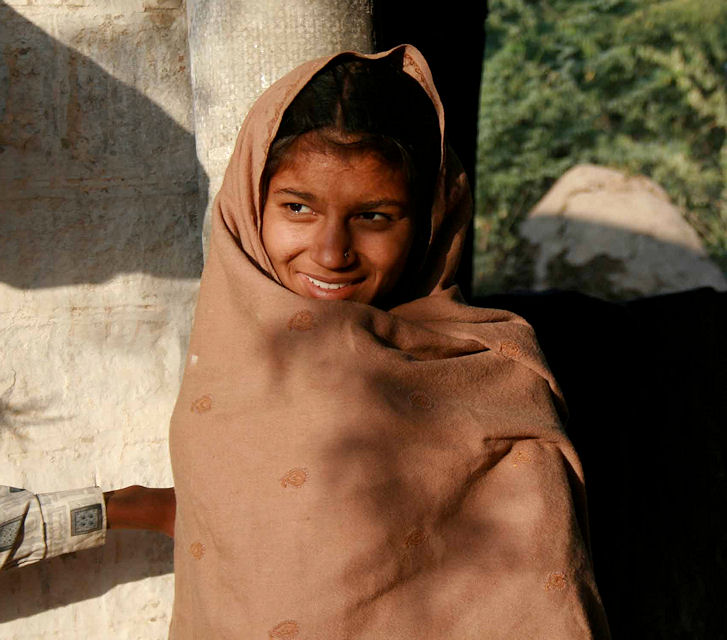
Abb.: मेषकम्बलः । Rajasthan
[Bildquelle: Tom Thai. --
http://www.flickr.com/photos/eviltomthai/2133913866/. -- Zugriff am
2011-10-04. --
Creative Commons Lizenz (Namensnennung)]
ऊर्णायु - ūrnayu m.: Wolliger, Schafwolldecke, Ziegenhaardecke
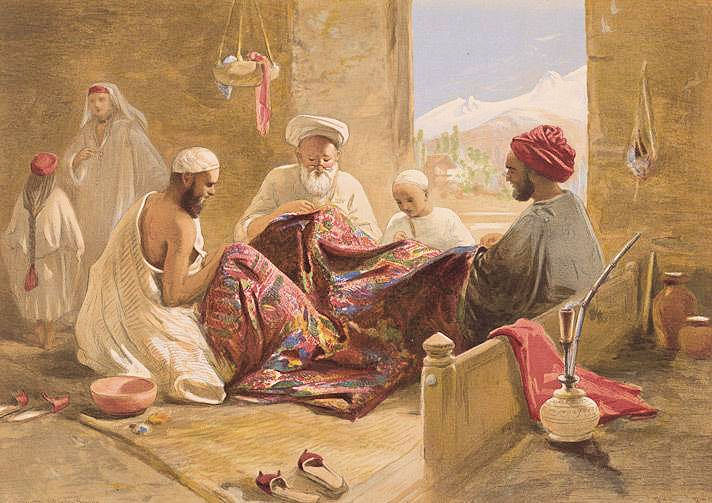
Abb.: ऊर्णयुः । Schal-Sticker, Kaschmir
[Bildquelle: William Simpson (1823 – 1899) / Wikimedia. -- Public domain]
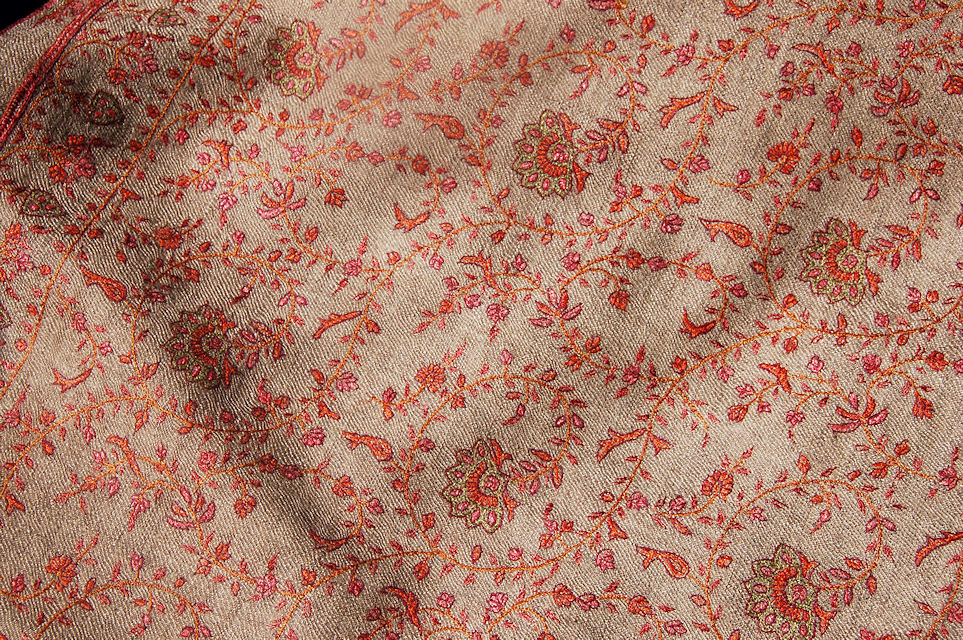
Abb.: ऊर्णयुः । Schal, Srinagar - سری نگر, Jammu & Kahmir
[Bildquelle: Een Ar. --
http://www.flickr.com/photos/anaranar/3799912547/. -- Zugriff am
2011-10-04. --
Creative Commons Lizenz (Namensnennung, keine Bearbeitung)]
"Wool. The table-land of the Peninsula, coomencing with the Neilgherries, and proceeding along
Mysore to the Dekhan, Kandesh, and Gujerat, presents large tracts of country affording favourable climate and abundant pastures for numerous flocks of sheep. If from thence we proceed in a north-east direction, passing Berar, Malwa, Rajputana, to the district of Hurriana and the province of Dehli, we shall see, supported on the natural pastures of the country, immense herds of cattle, and numerous flocks of sheep, the latter affording wool utilized by the natives for making blankets (kumlee or cumblee) of different degrees of fineness, which form a considerable article of the commerce of these provinces, and one is possessed by every labourer and artisan. Again, the Himalaya, on their southern face,
present a European-like climate, remarkable, however, for being influenced by the periodical rains. The temperature varies according to the elevation ; but they afford everywhere rich pastures, and support a fine breed of sheep, of which the wool is employed by the mountaineers to form their clothing. The northern face of these mountains is as remarkable for its dryness as the southern is for its moisture ; the cold is excessive, and the animals which are pastured there are covered with shaggy hair or with long wool, and a fine down. It is here that the shawl-wool goat finds its most congenial climate.
Sir A. Burnes says,
The wool of Turkestan is obtained chiefly in the neighbourhood of Bokhara and Samarcand, and is more celebrated than that of Kabul. This is sent to Amritsar in the Panjab, where it is used to mix with the shawl-wool of Tibet in making what are called Kashmir shawls. It is the produce of the goat of Bokhara, and not of the sheep of Turkestan, and is called 'put,' in contradistinction to 'pashm,' which is used to express the fleece of the sheep.
The wool or put of the goat of Kabul was not then exported, being entirely consumed in the native manufactures. It is procured from goats, and chiefly from the hill country of the Hazara to the west of Kabul, and between that city and Herat, which has an elevation of about 6000 or 8000 feet above the level of the sea.
The countless flocks of fat-tailed sheep in Kabul produce an abundance of wool. The fleece is of a glossy white colour, and is in Kabul called 'pashm-i-burrak,' and the fabrics prepared from it 'burrak,' in contradistinction to 'puttu.' It sold at from 2 to 2 1/2 Kabul rupees the seer, or sixteen pounds. It is brought in from all directions for sale in Kabul ; and Sir A. Burnes states that he 'can scarcely put a limit to the supply, since the extent of pasture land in those countries is not overrated at four-fifths of the whole surface of the country, and a very large portion of the population, such as the Lohani and Ghilji, are shepherds, who remove from pasture to pasture, and rear their flocks with great care and attention. Nature, however, does as much as the people ; for aromatic plants, in which sheep delight, are exceedingly abundant, and it is universally believed that they have considerable effect on the quality of the wool.'
Wool obtained from the fat-tailed variety of sheep is used in the manufacture of cloths and carpets, and is also exported to India, It is of wide distribution ; the sheep abound at Peshawur, Kabul, Kandahar, Herat, and other places. Kelat and the surrounding country produces sheep's wool in great abundance. This sheep apparently indigenous also to the Salt Range.
Kirman is a tract of country close by the Persian Gulf, to the south of Persia. Its wool finds its way into the Panjab in considerable quantities. It is a soft, delicate wool, but its principal use at present unfortunately appears to be the adulteration of genuine pashm. The Kirmani wool from the Persian Gulf finds its way to Amritsar pretty largely from both Kurachee and Bombay, and is one of the staples used in adulterating the pashm or genuine shawl-wool.
The Lena shawl- wool is the produce of the goats of the Tibetan Himalaya. It used to be a prevalent opinion that these goats were found in Kashmir, but that celebrated valley is far too warm and damp for them.
The best shawl-wool is produced in the vicinity of Garo, Manasarowara, and the elevated lands to the eastward. The shawl-wool is the fleece of the goat next the skin only ; the outer coat is coarse hair, and the two colours are white and light brown. The dogs of Tartary have also a soft down below the hair, very little inferior to that of the goats.
Goat's hair is very commonly produced in almost every district of the Panjab, and called 'jat.' It is used for making ropes, also for matting, and for the strong bags wherein grain, etc., is carried on the backs of oxen. Grain dealers use rugs made of it in the shops in which the grain is poured out when being winnowed or weighed. At Dala and Gyani, in Hundes, four or five fleeces of wool, according to size, sold for one rupee, which averages 1 1/2 to 2 annas or 3d. the. pound. Shawl-wool is produced in a variety of districts in Tibet
The wool of Eastern Turkestan is known as Turfani wool, so called from the city of Turfan. It is this exquisitely fine wool from which the finest shawls and other fabrics of Kashmir are made.
The following are the wools used in the Panjab:
Pashm, or shawl-wool properly so called, being a downy substance found next the skin and below the thick hair of the Tibetan goat It is of three colours, white, drab, and dark lavender (tusha). The best kind is produced in the semi-Chinese provinces of Turfan, Kichar, and exported via Yarkand to Kashmir. All the finest shawls are made of this wool ; but as the maharaja of Kashmir keeps a strict monopoly of the article, the Panjab shawl-weavers cannot procure it, and have to be content with an inferior kind of pashm produced at Chathan, and exported via Leh to Amritsar, Nurpur. Ludhiana, Jalalpur, and other shawl-weaving towns of the Panjab. The price of white pashm in Kashmir is, for uncleaned, Rs. 3 to 4 per lb. : ditto, cleaned, Rs. 6 to 7 per lb. ; of tusha, uncleaned, Its. 2 to 3 per lb. ; cleaned, from Rs. 5 to 7.
The fleece of the Dumba sheep of Kabul and Peshawur is sometimes called the Kabuli pashm. It is used in the manufacture of the finer sorts of choga, an outer robe or cloak with sleeves worn by Afghans and other Muhammadans of the western frontier.
Wahab Shahi, or Kirmani wool, the soft white wool of a sheep found in Kirman, a tract of country in the south of Persia, by the Persian Gulf. It is used for the manufacture of spurious kinds of shawl-cloth, and for adulterating the texture of Kashmir shawls.
The hair of a goat common in Kabul and Peshawur, called pat, from which a texture called pattu is made. (Qu. put ?)
The wooolly hair of the camel. From this a coarser kind of choga is made.
The wool of the country sheep of the plains.
A considerable and increasing quantity of wool is exported from India, mostly all of it, latterly, from Bombay, and chiefly to Great Britain, France, and America. Wool of Afghanistan from the white sheep has been increasing as an export, via Kurachee to Britain. The white and the rufous-coloured sheep are shorn twice a year. Sind is not a wool-producing country, though it is to be obtained in its western confines to a great extent, particularly in Cutchi and the Jalawan mountains of the Brahui. The Hindus of the country carry on the trade, and thus much of the article coming into the Bombay market through Sind is misnamed Sindian wool. Many districts, however, accessible through Sind and the Indus, yield this important article abundantly ; that furnished by the Kelat territories finds its way to Bombay via the mountainous road to Sonmiani.
Mr. Powell mentions that all or most of the mammalia of the Himalayan regions and other similarly situated localities, at an elevation of 11,000 to 13,000 and 14,000 feet, which are consequently subject to severe winters and a high rarity of atmosphere, whether domesticated or wild, such as the dog, yak, karghan, etc., possess a wintry inner coat of 'pam,' of different degrees of fineness. The pashm of the goat is alone the marketable commodity ; but the hair of the yak and Kirghiz camel is in parts cropped, and both in a cleaned and coarse state is made into cloth of different degrees of fineness, for Kirghiz (nomadic) tents, clothing, bedding, saddle-bags, ropes, etc. etc. The hair picked from marketable pam at Kashmir supplies material for a different branch of manufacture, viz. of ropes, saddle-bags, and haircloth of different kinds, qualities, and uses.
Antelope wool of Lahoul, called in Tibetan Tsodky-i-lena, or properly b-Rtsodky-i-lena, is very precious.
Ibex hair, or wool of the teringole or kin, the ibex, is the wool that makes the famous and rare ibex shawls.
Sheep's wool, black and white, of Lahoul, called luggi-bal, was selling in 1866 for 6 Cutchi seers per rupee ; it is exported to Kullu and Kanawar.
Yaks wool of Rupshu and Zanskar, called Kullu, is the soft under-hair of the yak, used to make bags for sheep loads, and the felt soles of shoes.
The Rampur chadr is a soft wool fabric manufactured from the wool of the sheep of Rampur and Spiti, which are there the beasts of burden.
The wool of the Dumba or large-tailed sheep of Peshawur and Kabul is called Kabuli pashm, and is manufactured into the choga or sleeved cloaks worn by the Afghans.
Pattu fabrics are made from the pat wool of Kabul.
The pashm of Changtan and Turfan are of the first class, and are monopolized by Kashmir.
The pashms of Rodakh, Ladakh, Spiti, Rampur, Bashahir are a second-class wool, and form the staple export to the shawl manufacturing cities of the Panjab.
Pasture. The nature of the soil on which the sheep and goats are fed, has most influence on the texture and quality of their wool. There can be no doubt that the valleys of the Sutlej, Ravi, Chandrabaga (or Chenab), and other tributaries of the Indus, supply grazing grounds not to be surpassed in richness and suitableness in any part of the world. The population inhabiting them are chiefly pastoral, but, owing to sloth and ignorance, the wool they produce is but small in quantity, full of dirt, and ill cared for in every way. The Government of the Panjab have made efforts to improve the breed by the importation of Merino rams, but hitherto with little success. However, a truss of Merino wool produced in the Hazara Hill district, to the north-west of the Panjab, and sent to England in 1860, was there valued at 1s. 6d. per lb. Sheep whose pasture grows on calcareous poor soil have short, harsh wool, while those on rich loamy argillaceous soils have longer and softer hair. The same animal produces different kinds of wool. On a sheep the finest wool is on the spine from the neck to near the tail, including one-third of the breadth of the back. Rampur is a great mart for the reception and forwarding of wool.
Pashm is the chief article of trade in Khotan and Ladakh. It is cut once a year ; the wool picked out is sent to Kashmir, but the hair is made into ropes, coarse sacks, and blankets. After the hair of the goat has been cut short with a knife in the direction of its growth, or from the head towards the tail, a sort of comb is passed in the reverse direction, and brings away the finer wool almost unmixed with the coarse hair. If not shorn as the summer commences, the animals themselves rub off the wool.
The goats are found domesticated all over the mountainous country of Western Tibet, particularly in the provinces of Ladakh, Rodakh, and Garo. Changthan is the name given to the elevated plateaux where innumerable flocks are pastured. Merchants bring down large quantities from Ghar-garo or Gurdokh in Changthan, where a large commercial fair is held annually in August (Bhadon). The Lahoul traders bring Changthan wool through Ladakh. In Changthan, at the Arghils cattle-sheds and Yaitaaks pasture-grounds, the usual price of the raw article or coarse pam is about 2 vuttees 14 seers pucka, or 8 lbs. (English) for Rs. 3, or about 6 annas the pound weight ; and tobacco is bartered for about double its weight of coarse Changthan pam. So also green and red dyed goat-skins of Panjab manufacture, with shoes and boots of the same article (the latter made in Turki fashion) are bartered at Yarkand, Aksu, Ilchi, Turfan, etc., for treble and quadruple their weight of raw pam. In the same manner, not many years since, the glass beads and buttons of Birmingham were wont to be bartered for, an equal weight of gold-dust or reg-i -zar throughout the entire country of Gilgit, Yarkand, Mazzhuji, Chitral, and along the south base of the Mustagh and Kara-korum,
The mountain paths between Rampur and Spiti are so precipitous, that sheep, more surefooted than larger beasts, are commonly used to carry burdens of from 16 to 20 lbs. The sheep are driven from village to village with the wool on, and as the required quantity is cut from their backs, they are laden with the grain which is received in exchange, and which, when the fleece is all disposed of, is carried into Chinese Tartary, and sold at a profitable rate. It is the custom for the shepherds of Chumurti to give an order, while the crops are yet green and on the ground, for any amount of grain they may require, which, when the crop is ripe, is stored up by the cultivator until the summer of the ensuing year. When the shepherd arrives with his flock, he gives the wool in exchange, and receives his grain, which he puts into small bags, and drives back his flock thus laden. About 2000 maunds of wool are annually brought to Rampur, and about half that quantity of pashm. The price of the wool averages about 4 lbs. for the rupee, and pashm, Rs. 2 to 4 for 2 lbs.
The beautiful pashms of Changthan and Turfan, and the soft white fleeces of Kirman, embrace three distinct kinds of wool, distinguished not only by the climate and soil where they are produced, but also by the fact that they are the produce of different animals.
These classes are
The genuine pashms of Changthan, Turfan, etc., which are monopolized by Kashmir, and those second-class pashms, the produce of Rodakh, Ladakh, and even Spiti, Rampur, and Bashahir, which form the staple export to the shawl manufacturing cities of the Panjab, Amritsar, Ludhiana, Jalalpur, Nurpur. Included by analogy of locality only, are the wools of the ibex, so rarely seen, and the yak, the thick tails of which animals are prized for chauries (fly-flaps).
The wools produced beyond the N.W. frontier, including those of Peshawur, comprise the Dumba sheep wool, the wools of Kabul, Bokhara, and that imported from Kirman ; in fact, all classes of wool produced on or beyond tin N.W. frontier. The trade in these wools is now extensive, both by the Peshawur and other routes. Second class of wools, produced at or about Peshawur, Kabul, Kandahar, and Persia or Kirman.
British Wools. Since the middle of the 18th century there have been many fluctuations in the price of wool in Great Britain, from 14s. 6d. the tod about the year 1780, to 65s. in 1864 and 22s. 2 3/8d. in 1883. Taking the wool produce of England at 5,500,000 tods per annum, the value of this produce in the year 1864 was 17,654, 166, whereas the same quantity in the year 1883 would represent a value of 6,104,427, that is, taking the mean average price of wool in 1864 at 63s. 10d. per tod, and in 1883 at 22s. 2 3/8d. per tod. The difference in value between the produce of these two years is thus no less than 11,449,739.
Thull. The wool produced in the Thull is shipped at Bukkur or Leia, and sent down to Bombay, and averages Rs. 10 a maund. In Ludhiana district pashmina is prepared from pashm, the fine hair of the Tartar goat. The hair is brought down on mules through Ladakh, Rampur, and Bashahir, and, in exchange, cotton piece-goods, brass, and iron are taken back. The price of pashm varies from Rs. 2 a seer. On receiving the pashm, the manufacturer's first business in to separate the coarser from the finer or underneath hair ; out of each seer about 6 chitaks of the are taken. It is then washed in rice water, and made into thread. This sells at from 4 to 12 rupees per seer, according to quality. The thread made of the finest hair is woven into the well-known Rampur chadr, which are extensively manufactured. From the coarser thread are made shawls of sorts, and the cloth known as pashmina.
Woollen manufactures are largely produced in High Asia, in India, and in China ; vast quantities of wool are woven into blankets of various degrees of fineness, for the use of the people, called kumlee or cumblee, also chadr. The numda or felte, both white and coloured, are used for tents, floorcloths, and quilts. The woven fabrics are made into shawls, choghas, and barani or overcoats, and the fine blankets known as Rampur chadr are prized, and Central Asia is famed for its carpets. The burruk fabric, the abra and looi blankets, are made of sheep's wool ; the pattu and pattu malida (dressed pattu) fabrics are largely worn in Afghanistan, and at Herat kuruk is manufactured from goat's hair.
The jute carpet is indigenous to Persia and Turkestan, where the best are still made. In India, the foundation for the carpet is a warp of strong cotton or hempen threads ; and the peculiarity of the process consists in dexterously twisting short lengths of coloured wool into each of the threads of the warp, so that the two ends of the twist of wool stick out in front. The projecting ends are then clipped to a uniform level, and the lines of work are compacted together by striking them with a blunt instrument (Birdwood). The historical seats of the industry arc in Kashmir, the Panjab, and Sind, and at Agra, Mirzapur, Jubbulpur, Warangal in the Dekhan, Malabar, and Masulipatam. Velvet carpets are also made at Benares and Murshidabad, and silk carpets at Tanjore and Salem. At the Exhibition of 1851, the finest Indian rugs came from Warangal, the a capital of the Andhra dynasty, about 80 miles east of Hyderabad. Their characteristic feature was the exceedingly numerous count of the stitches, about 12,000 to the square foot were also perfectly harmonious in colour, and the only examples in which silk was used with an entirely satisfactory effect (Birdwood). The price was not less than £10 per square yard. The common rugs, produced in enormous quantities from the jails at Lahore, Jubbulpur, Mirzapur, Benares, and Bangalore, sell in England at 7s. 6d. each.
The woollen fabrics produced by the Chinese are felts for the soles of shoes and winter hats, and a sort of rug or carpet. It is not woven in looms from the yarn, but is made in small pieces by a fulling process which mats the fibres together. The consumption of it by shoemakers is very great, and nearly as large for winter hats among the common people. The rags are woven with coloured threads in rude imitation of figures, and are extensively used in the northern provinces; the pieces are a few feet square, and sewn together for carpets or bedding. Hair and wool are both employed in their construction.
Great Britain in 1883 exported woollen fabrics to the value of 18,320,016, of which there was cleared for India, £370,545 value ; to China, £242,456 ; to Japan, £62,455. India in 1882-1883 imported to the value of Rs. 77,52,049. MacGregor, p. 50 ; Powell, Handbook; Econ. Prod. Panjab, 183 ; Ann. Ind. Adm. xii. 108 ; Imp. Gaz."
[Quelle: Balfour, Edward <1813-1889>: Cyclopædia of India and of eastern and southern Asia, commercial, industrial and scientific: products of the mineral, vegetable and animal kingdoms, useful arts and manufactures / ed. by Edward Balfour. -- 3rd ed. -- London: Quaritch. -- Vol. 3. -- 1885. -- S. 1088 - 1092]
| 107c./d. meṣakambala ūrṇāyuḥ
śaśorṇaṃ śaśalomani मेषकम्बल ऊर्णायुः शशोर्णं शशलोमनि ।१०७ ख। Hasen-/Kaninchenhaar (शशलोमन् - śaśaloman n.: Hasenhaar, Kaninchenhaar) heißt शशोर्ण - śaśorṇa n.: Hasenwolle, Kaninchenwolle |
Colebrooke (1807): "Hare's or rabbit's hair."
शशलोमन् - śaśaloman n.: Hasenhaar, Kaninchenhaar
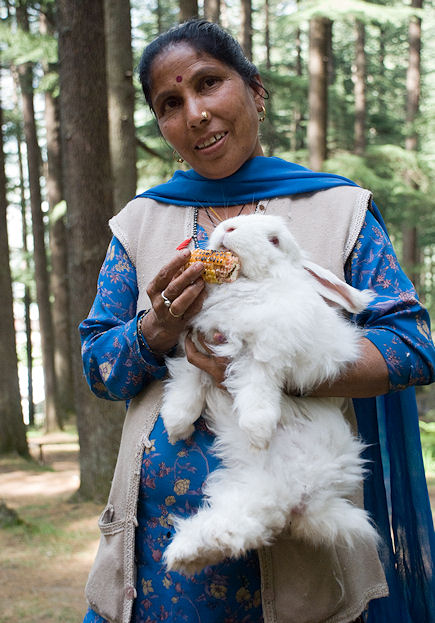
Abb.: शशलोमानि । Manali - मनाली, Himachal Pradesh
[Bildquelle: Kiran Jonnalagadda. --
http://www.flickr.com/photos/jace/3778026515/. -- Zugriff am 2011-10-04.
-- Creative
Commons Lizenz (Namensnennung, share alike)]
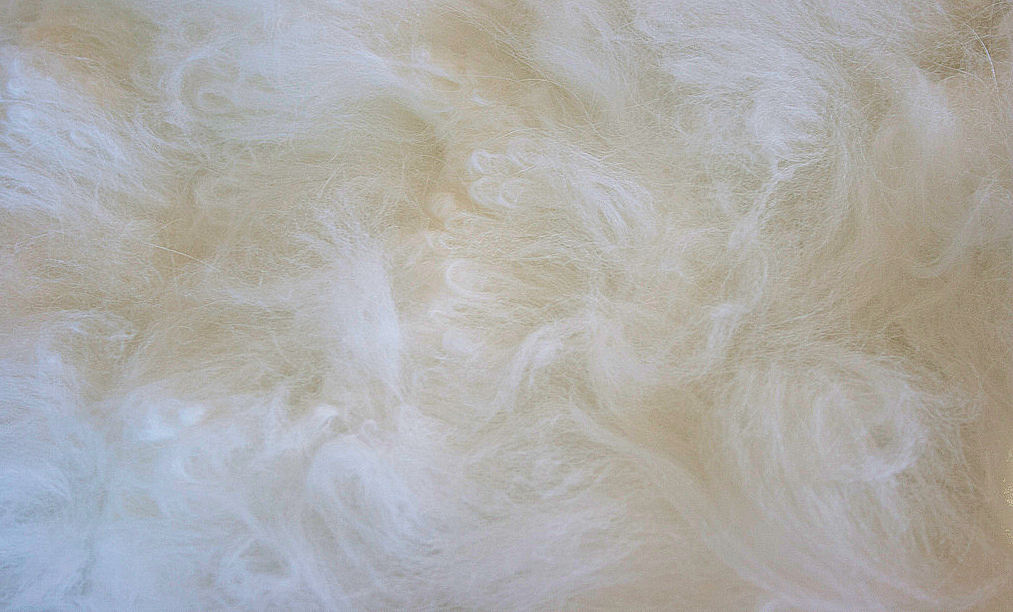
Abb.: शशलोमानि । Angorawolle (vom Angora-Kaninchen) vor dem Karden
[Bildquelle: Praises139. --
http://www.flickr.com/photos/40603134@N02/5675064067/. -- Zugriff am
2011-10-04. --
Creative
Commons Lizenz (Namensnennung, share alike)]
शशोर्ण - śaśorṇa n.: Hasenwolle, Kaninchenwolle
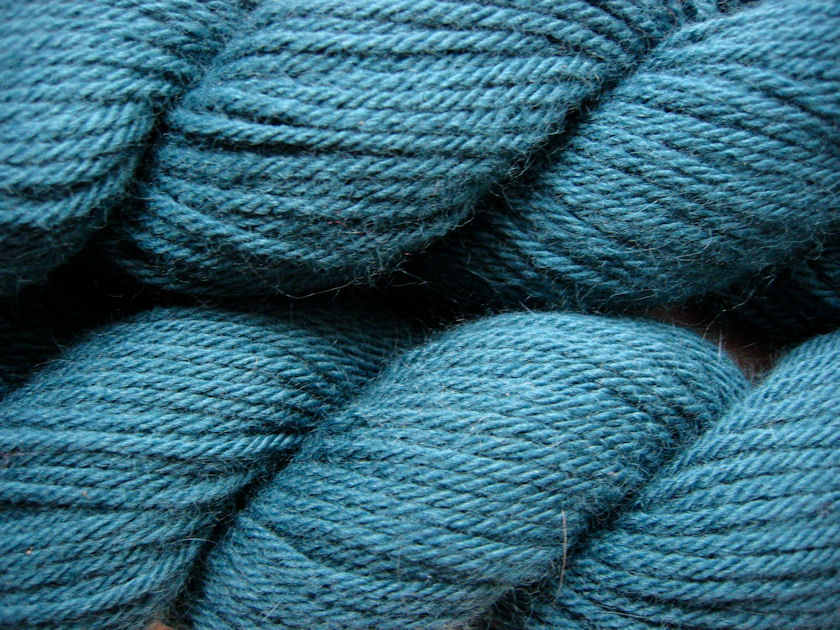
Abb.: शशोर्णम् । Angora, gefärbte Wolle vom Angora-Kaninchen
[Bildquelle: The Bees. --
http://www.flickr.com/photos/thebees/3065613801/. -- Zugriff am
2011-10-04. --
Creative Commons Lizenz (Namensnennung, keine kommerzielle Nutzung9]
Siehe auch:
Entwicklungsländerstudien / hrsg. von Margarete Payer. -- Teil I: Grundgegebenheiten. -- Kapitel 8: Tierische Produktion. -- 8. Kaninchen / zusammengestellt von Alois Payer. -- URL: http://www.payer.de/entwicklung/entw088.htm
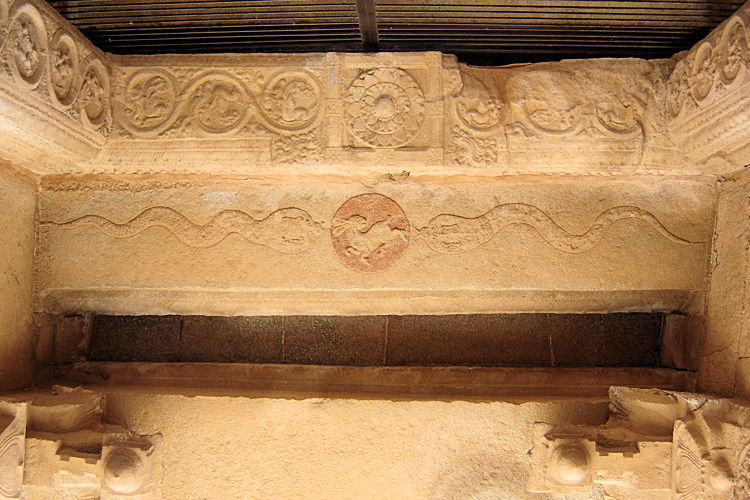
Abb.: Hase mit Kobras, Hampi - ಹಂಪೆ,
Karnataka
[Bildquelle: John Rambow. --
http://www.flickr.com/photos/rambow/124513095/. -- Zugriff am
2011-10-04. --
Creative Commons Lizenz (Namensnennung, keine kommerzielle Nutzung,
keine Bearbeitung)]
"LEPUS, the hare, is of the family Leporidae.
There are five species known to inhabit the East Indies,—
- Lepus ruficaudatus, the common Indian hare ;
- Lepus nigricollis, the black-naped hare ;
- Lepus hispidus, the hispid hare ;
- Lepus Peguensis of Burma, and
- Lepus pallipes of Tibet.
Hares are unknown in Arakan and in the Tenasserim provinces, also throughout the Malayan Peninsula and Archipelago, with the exception of Lepus nigricollis, F. Cuv., in Java, which has most probably been introduced from South India or Ceylon, as it doubtless likewise has in the Mauritius ; but several notices occur of hares in the Indo - Chinese countries, even in Cochin-China the species being as yet undetermined.
[...]
Lepus cuniculus, Linn., rabbit
[...]
Lepus hispidus, Pearson. Caprolagus hispidus, Bl. Hispid hare
The great sal forest at the base of the sub-Himalaya and of their offsets, from Gorakhpur to Tiperah, also at Siligori in the Terai, is the peculiar and exclusive habitat of the hispid hare, which never ventures into the open plains on the one hand, or into the mountains on the other; and hence it is but little known, deep cover and deadly malaria contributing alike to its obscurity. As the black-necked hare or Lepus nigricollis is the single species of the Dekhan, and the redtail, Lepus ruficaudata, of Hindustan and Bengal, so is the hispid of the vast sub-Himalayan forest ; and it is remarkable that the mountains beyond the forest, even up to the perpetual snows, have no peculiar species. The sal forest hare feeds chiefly on roots and the bark of trees, a circumstance as remarkably in harmony with the extraordinary rodent power of its structure as are its small eyes and ears, weighty body, and short, strong legs, with what has been just stated relative to the rest of its habits. The whole forms a beautiful instance of adaptation without the slightest change of organism. If anything, the male is rather the larger and darker. The male measures 19½ inches from snout to vent. The female is 19 inches long and 5¼ lbs. Both have a girth behind the shoulder of 12 inches. Compared with the common species, these animals are conspicuously of darker hue and heavier make, but not larger. They have heavier heads, much shorter ears, smaller eyes, shorter tails, limbs shorter, stronger and less unequal,—in that respect like a rabbit ; and, lastly, their mystaccal tufts are much less, and their fur much harsher. The profile of the head is less curved in the hispid than in the common species, the nails somewhat larger, and the digits slightly different in gradation, the thumb in particular being less withdrawn, and the little finger more so, from the front, in hispidus. The ears both in male and female considerably exceed one-half of the length of the head, and are broader as well as shorter than in Lepus ruficaudatus or Lepus timidus ; and it is remarkable that the tail in the male is shorter than in the female,—in both more so than in Lepus timidus. The teats are six, two pectoral and four ventral.
Lepus macrotus inhabits the Himalaya and Nepal It is larger than the black-necked hare,
Lepus nigricollis, of the Indian plains.
This is the hare of Ceylon, of the Peninsula of India, of Sind, the Panjab, and of Java.
Lepus oiostolus, Hodgs., Lepus Tibetanus, Waterh.
The blue, woolly, or alpine hare of Tibet and Nepal is considered by Major Cunningham to be the Lepus pallipes of Hodgson. There was, says Dr. Hooker (ii. p. 157), much short grass about the land, on which large antelopes, Chiru (Antilope Hodgsonii), and deer, Goa (Procapra picticaudata, Hodgson), were feeding. There were also many slate-coloured hares with white rumps (Lepus oiostolus), with marmots and tailless rats. He found the horns of the Chiru on the south side of the Donkia pass, but he never saw a live one except in Tibet. The Procapra is as described by Mr. Hodgson. Dr. Adams says of the alpine hare, Lepus oiostolus, that it was common among the fallen boulders, and along the long bottoms and sides of the valleys leading towards the Pugha lake. This species very much resembles the alpine hare of Europe.
Lepus pallipes, Hodgson; Lepus tollai, Pallas, Gray. White-foot hare, Ri-bong, Tib., occurs in Ladakh and Tibet.
Lepus Peguensis, Myth, is very similar to the Lepus ruficaudatus, Is. Geoffroy, of Bengal. It occurs in all Upper India, Assam, and Upper Burma. Tail black above, as in the generality of the genus. Upper parts same colour as Bengal hare, but the belly abruptly white.
Lepus ruficaudatus, Geoff., Blyth., Lepus Indicus, Hodgs., Lepus macrotus, Hodgs. Common Indian hare, Eng.
This hare is found from the Himalaya and the Panjab to the Godavery, Malabar, and Assam."
[Quelle: Balfour, Edward <1813-1889>: Cyclopædia of India and of eastern and southern Asia, commercial, industrial and scientific: products of the mineral, vegetable and animal kingdoms, useful arts and manufactures / ed. by Edward Balfour. -- 3rd ed. -- London: Quaritch. -- Vol. 1. -- 1885. -- S. 704f.]
| 108a./b. madhu kṣaudraṃ mākṣikādi madhūcchiṣṭaṃ tu sikthakam मधु क्षौद्रं माक्षिकादि मधूच्छिष्टं तु सिक्थकम् ।१०८ क। [Bezeichnungen für Honig:]
|
Colebrooke (1807): "Honey."
मधु - madhu n.: Honig, Süßes
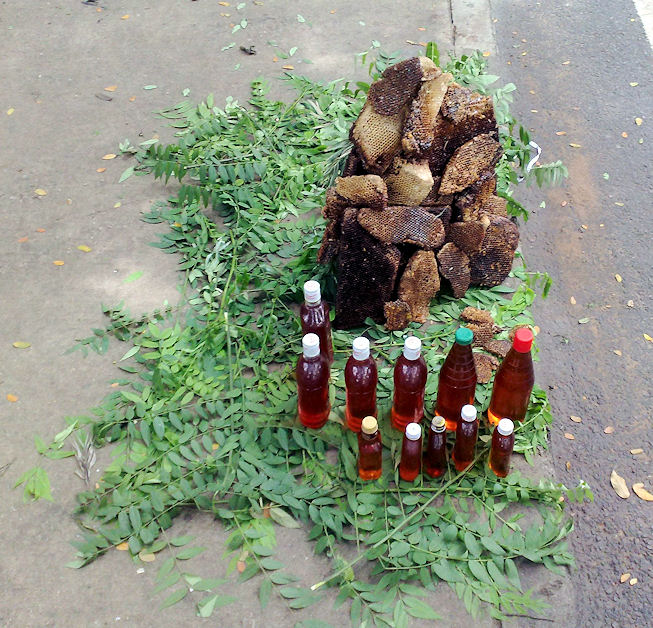
Abb.: मधु । Abgefüllter Honig zum Verkauf, samt den dazugehörigen Waben,
Bangalore, Karnataka
[Bildquelle: rexdude. --
http://www.flickr.com/photos/rexdude/3845705178/. -- Zugriff am
2011-10-04. --
Creative Commons Lizenz (Namensnennung, keine kommerzielle Nutzung,
share alike)]
क्षौद्र - kṣaudra n.: von der Kleinen (vermutlich Apis florea Fabricius 1787 - Zwerg-Honigbiene - Dwarf Honey Bee) stammend, Zwergbienen-Honig, Honig
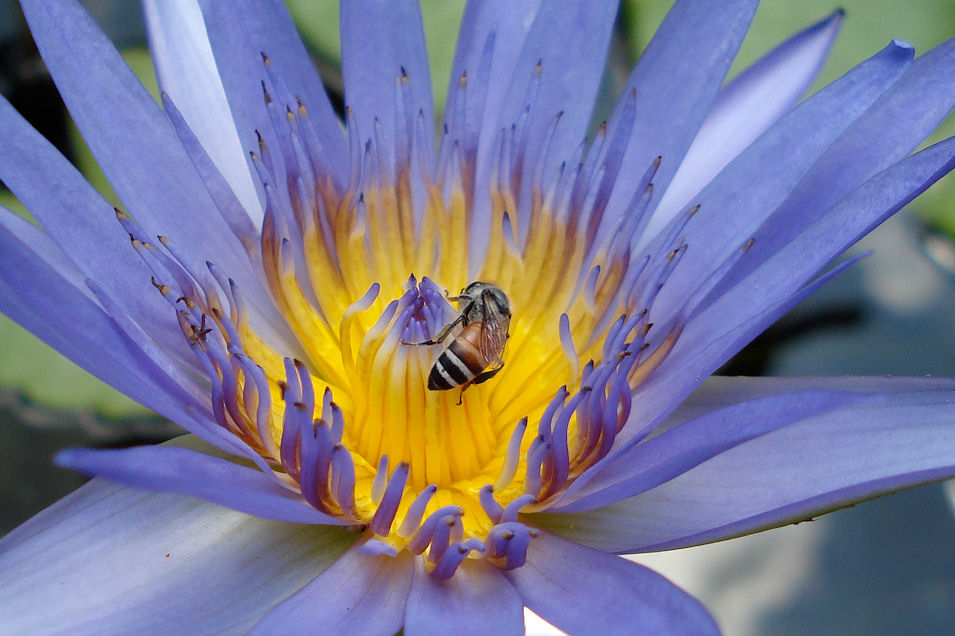
Abb.: क्षुद्रा । Apis florea Fabricius 1787 - Zwerg-Honigbiene -
Dwarf Honey Bee, Phnom Penh -
माक्षिक - mākṣika n.: von der Honigfliege (= Biene = <मधु>मक्षिका - <madhu>makṣikā) stammend, Honig
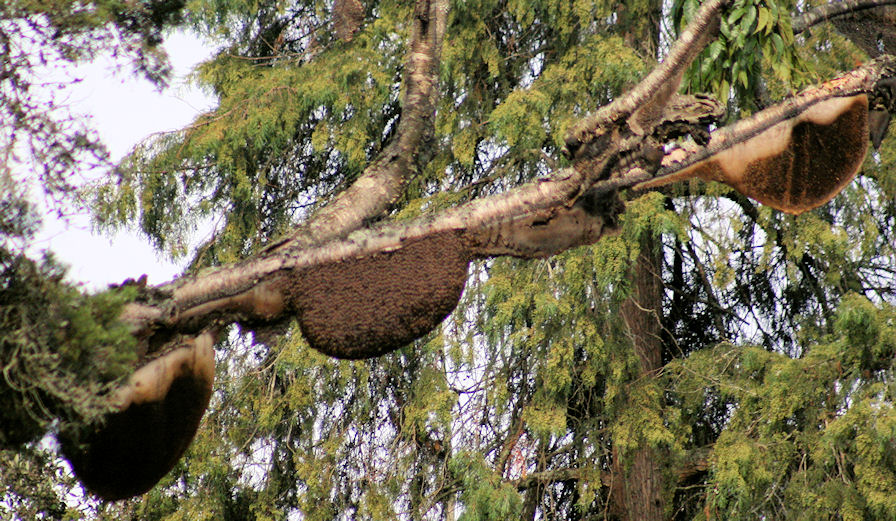
Abb.: मधु । Bienenwaben, Südindien
[Bildquelle: Federico Bierti. --
http://www.flickr.com/photos/53318225@N00/4106935393/. -- Zugriff am
2011-10-04. --
Creative Commons Lizenz (Namensnennung, keine kommerzielle Nutzung,
share alike)]
"HONEY AND WAX. Sans. मधु, Madhu, माक्षिक, Mākshika. Vern. Madhu, Beng. Shahad, Hind.Eight sorts of honey are described by Susruta, namely : Of these varieties the first four only are described by recent writers and the first alone is used in medicine. New honey is considered demulcent and laxative. Honey more than a year old is said to be astringent and demulcent. Old honey. is preferred to new. It is much used in the preparation of confections and electuaries, and as an adjunct to decoctions, pills and powders."
- 1. Mākṣika or the honey collected by the common bee called madhumakṣikā.
- 2. Bhrāmara, or the honey collected by a large back bee called bhramara.
- 3. Kṣaudra, or honey collected by a sort of small bee of tawny colour, called Kṣudra.
- 4. Pauttika, or honey collected by a small black bee resembling a gnat, and called puttika.
- 5. Chātra, or honey formed by tawny or yellow wasps which make their hives in the shape of umbrellas.
- 6. Ārghya or wild honey collected by a sort of yellow bee like the bhramara.
- 7. Auddālaka is a bitter and acrid substance like honey found in the nests of white ants.
- 8. Dāla or unprepared honey found on flowers.
[Quelle: Dutt, Uday Chand: The materia medica of the Hindus / Uday Chand Dutt. With a glossary of Indian plants by George King. -- 2. ed. with additions and alterations / by Binod Lall Sen & Ashutosh Sen. -- Calcutta, 1900. - XVIII, 356 S. -- S. 277f..]
"Honey is obtained from the honeycomb of the Apis mellifica, Linn., and other species of honeybee, of the order Hymenoptera, Linn. Honey is secreted by the nectaries of flowers, sucked by the bee into its crop, where it undergoes some slight changes, and is then stored up in the comb for the food of its community. The finest honey is that which is allowed to drain from the comb ; and if obtained from hives which have never swarmed, it is called virgin honey. In some localities it is poisonous, owing to the deleterious nature of the plants from which it is collected. Dr. Hooker has stated that in some parts of Sikkim the honey of rhododendron flowers is believed to be poisonous. Azalea pontica, the Anabasis informs us, poisoned the soldiers of Xenophon in the retreat of the ten thousand. Honey diluted with water undergoes the vinous fermentation, and hydromel or mead is produced. A wild shrub, jeneda, appears to intoxicate the bees. The aborigines take a piece in their hand, and, biting through the bark, they get the pungent white juice into their mouths ; this they spit out at the bees, which either fly away or become intoxicated. The honey of the Eastern Archipelago is a thin syrup, very inferior in flavour to that of temperate climates. The comb is chiefly sought on account of the wax, which forms a large article of exportation to Europe, India, and China. The honeys of the Aravalli and of Kashmir are praised, selling at tenpence the pound. There are wild bees in the woods of Kashmir, but the zamindars have also hives in the walls of their houses. The bees are quite domesticated. In the Shevaroy Hills honey is largely collected by the Mallaiali race, and is seemingly the product of three species of bees. Mr. Fischer had some hives of bees from Europe, but by day the bee-eater birds and king-crows largely destroyed them, and moths at night stole the honey. Once, on examining the hive, he found a moth had succeeded in forcing its way into the hive. The bees had killed it there, but as they could not cast it out, they enclosed it in a wax tomb.
The honey-yielding Apis dorsata, A. bicolor, A. Indica, A. nigripennis, and A. socialis, occur in the south of India and Ceylon. Sir Samuel Baker, in his book, Eight Years in Ceylon, refers to the Bambera (A. dorsata) as follows :—' The largest and most extensive honey-maker is the Bambera. This is nearly as large as a hornet, and it forms its nest upon the bough of a tree, from which the comb hangs like a Cheshire cheese, being about the same thickness, but five or six inches greater in diameter. The honey from this bee is not so much esteemed as that from the smaller varieties, as the flavour partakes too strongly of the particular flower which the bee has frequented ; thus in different seasons the honey varies in flavour, and is sometimes so highly aperient that it must be used with much caution. The wax of the comb is the purest and whitest of any kind produced in Ceylon.' It is supposed to range the Archipelago, Siam. A. dorsata and A. Indica have been introduced into Europe, and the Cyprian bee into Ceylon. In Europe, the gold-banded Ligurian is prized."
[Quelle: Balfour, Edward <1813-1889>: Cyclopædia of India and of eastern and southern Asia, commercial, industrial and scientific: products of the mineral, vegetable and animal kingdoms, useful arts and manufactures / ed. by Edward Balfour. -- 3rd ed. -- London: Quaritch. -- Vol. 2. -- 1885. -- S. 98.]
| 108a./b. madhu kṣaudraṃ mākṣikādi
madhūcchiṣṭaṃ tu sikthakam मधु क्षौद्रं माक्षिकादि मधूच्छिष्टं तु सिक्थकम् ।१०८ क। [Bezeichnungen für Bienenwachs:]
|
Colebrooke (1807): "Wax."
मधूच्छिष्ट - madhūcchiṣṭa n.: Was vom Honig übrigbleibt, Bienenwachs

Abb.: मधूच्छिष्टम् । Waben von Apis florea Fabricius 1787 -
Zwerg-Honigbiene - Dwarf Honey Bee
[Bildquelle: Sean Hoyland / Wikipedia. -- Public domain]
सिक्थक - sikthaka n.: Wachs
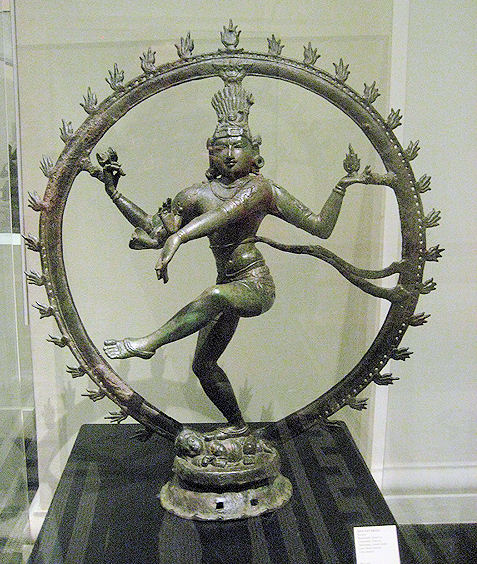
Abb.: सिक्थकम् । Śiva Naṭarāja, Bronze gegossen im Wachsausschmelzverfahren
(Cire perdue), Chola
[Bildquelle: Zorba the Greek. --
http://www.geograph.org.uk/photo/1162559. -- Zugriff am 2011-10-04. --
Creative
Commons Lizenz (Namensnennung, share alike)]
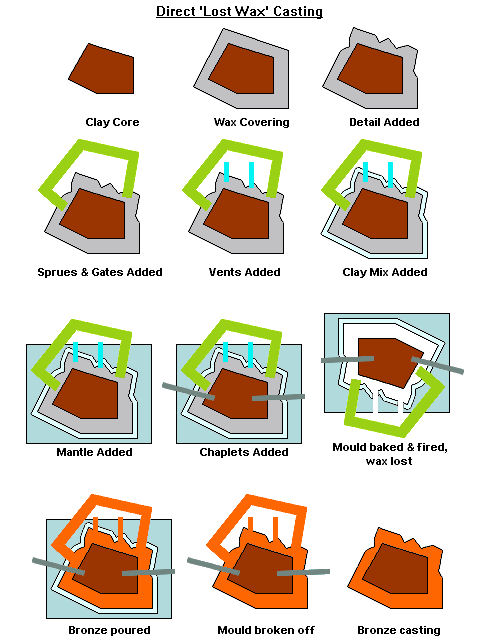
Abb.: सिक्थकम् । Methode des Wachsausschmelzverfahrens (Cire perdue)
[Bildquelle: H Padleckas / Wikimedia. -- GNU FDLicense]
"Wax, called siktha in Sanskrit, is used in the preparation of ointments and ghṛtas for external application." [Quelle: Dutt, Uday Chand: The materia medica of the Hindus / Uday Chand Dutt. With a glossary of Indian plants by George King. -- 2. ed. with additions and alterations / by Binod Lall Sen & Ashutosh Sen. -- Calcutta, 1900. - XVIII, 356 S. -- S. 278.]
| 108c./d. manaḥśilā manoguptā
manohvā nāgajihvikā 109a./b. naipālī kunaṭī golā yavakṣāro yavāgrajaḥ
मनःशिला
मनोगुप्ता मनोह्वा नागजिह्विका ।१०८ ख। [Bezeichnungen für Realgar:]
|
Colebrooke (1807): "Red arsenic. Some make the last term the name of a different species ; and the two preceding terms, its explanation."
"Realgar, Rubinschwefel, als Pigment auch als Rauschrot oder Opperment, ist ein häufig vorkommendes Arsen-Schwefel-Mineral aus der Mineralklasse der nichtmetallartigen Sulfide. Es kristallisiert im Monoklinen Kristallsystem mit der chemischen Formel As4S4 und entwickelt prismatische, längsgestreifte Kristalle oder körnige, massige Aggregate in den Farben rot bis orangegelb. Der Name Realgar stammt aus dem Arabischen rahdsch al-ghar / رهج الغار / rahǧ al-ġār und bedeutet so viel wie „Höhlenpulver“."
[Quelle: http://de.wikipedia.org/wiki/Realgar. -- Zugriff am 2011-10-04]
मनःशिला - manaḥśilā f.: "Herzensstein", Realgar
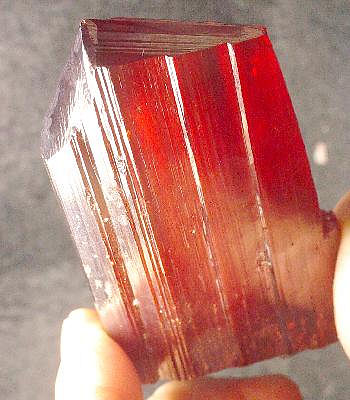
Abb.:
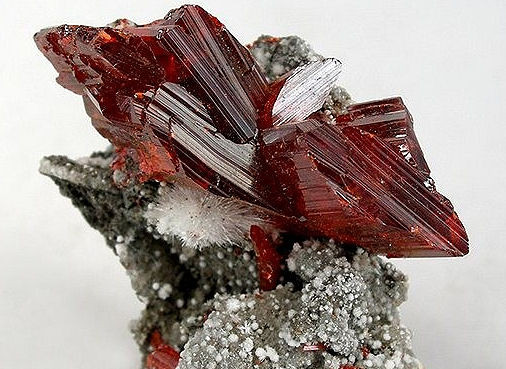
Abb.: मनःशिला । Realgar, China
[Bildquelle: Rob Lavinsky, iRocks.com / Wikimedia. --
Creative
Commons Lizenz (Namensnennung, share alike)]
मनोगुप्ता - manoguptā f.: "Im Herzen behütete, Herzensgeheimnis", Realgar
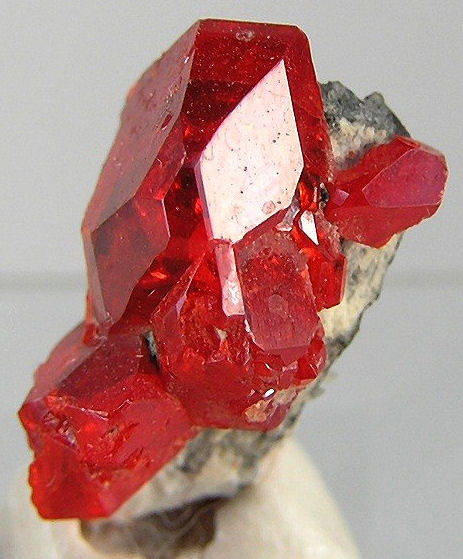
Abb.: Realgar, USA
[Bildquelle: Rob Lavinsky, iRocks.com / Wikimedia. --
Creative
Commons Lizenz (Namensnennung, share alike)]
मनोह्वा - manohvā f.: "Herzensruf, Herz genannte", Realgar
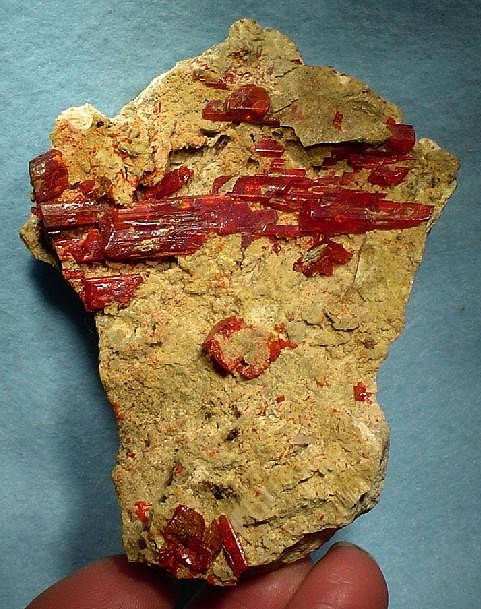
Abb.: Realgar, USA
[Bildquelle: Rob Lavinsky, iRocks.com / Wikimedia. --
Creative
Commons Lizenz (Namensnennung, share alike)]
नागजिह्विका - nāgajihvikā f.: Kobrazunge, Realgar
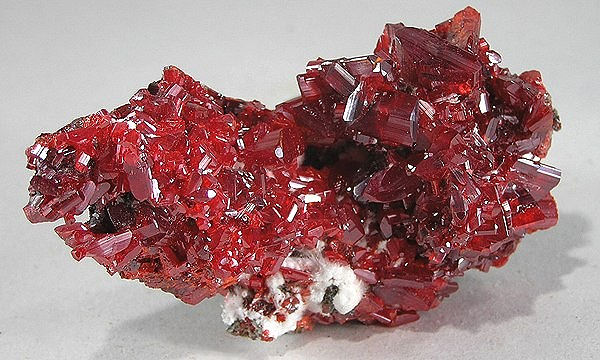
Abb.: नागजिह्विका । Realgar, China
[Bildquelle: Rob Lavinsky, iRocks.com / Wikimedia. --
Creative
Commons Lizenz (Namensnennung, share alike)]
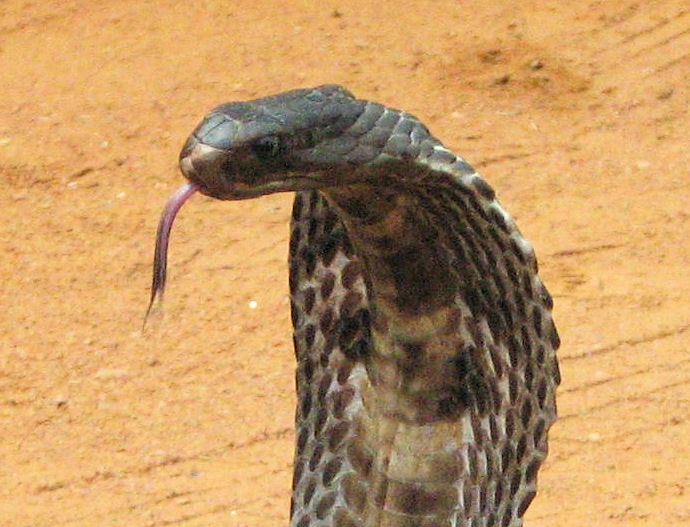
Abb.: नागजिह्विका । Kobrazunge, Delhi
[Bildquelle: Richard McMullen. --
http://www.flickr.com/photos/johnleespider/248179272/. -- Zugriff am
2011-10-04. --
Creative Commons Lizenz (Namensnennung, keine kommerzielle Nutzung,
share alike)]
नैपाली - naipālī f.: Nepalesische, Realgar
कुनटी - kunaṭī f.: Realgar
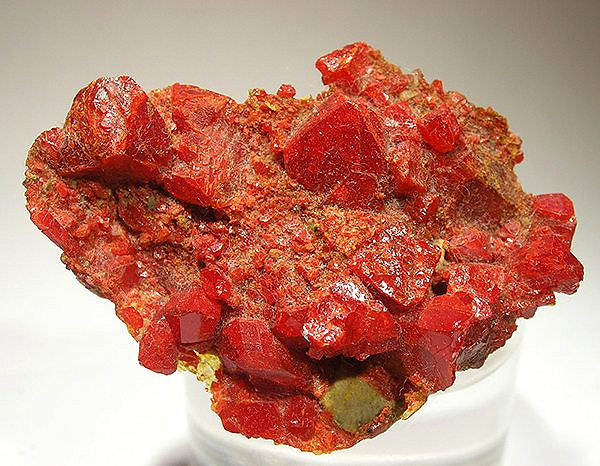
Abb.: कुनटी । Realgar, USA
[Bildquelle: Rob Lavinsky, iRocks.com / Wikimedia. --
Creative
Commons Lizenz (Namensnennung, share alike)]
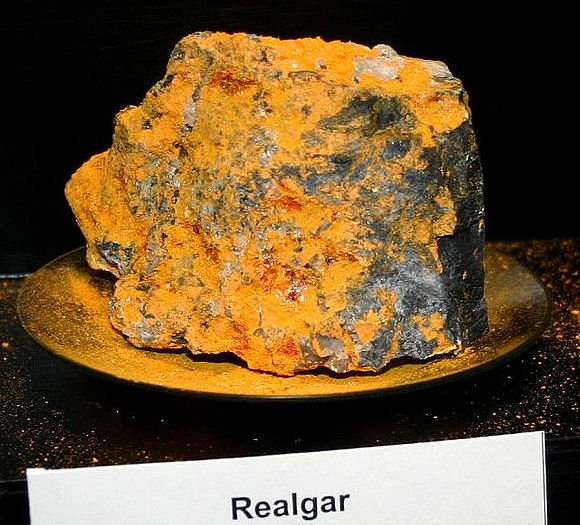
Abb.: कुनटी । Realgar, im Licht zu Auripigment zerfallend, USA
[Bildquelle: Reno Chris / Wikimedia. -- Public domain]
गोला - golā f.: Realgar (zu gola m. Kugel)
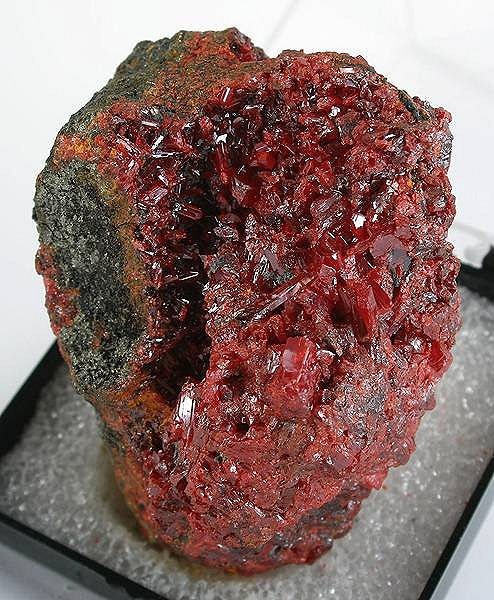
Abb.: गोला । Realgar, USA
[Bildquelle: Rob Lavinsky, iRocks.com / Wikimedia. --
Creative
Commons Lizenz (Namensnennung, share alike)]
"ARSENIC. THREE compounds of arsenic are used in Hindu medicine, namely,
- arsenious anhydride or white arsenic,
- red sulphide of arsenic or realgar, and
- the yellow sulphide or orpiment.
Of these three, orpiment and realgar have been used in medicine from a very remote period, and are indigenous to India. Native white arsenic is not met with in India. It is brought from Burmah, China and the Persian gulf. It is not mentioned in the more ancient Sanskrit works, neither in the list of metallic ores, where orpiment, realgar etc. are described, nor in any prescription for the treatment of diseases. In compilations of a later date, however, such as the Bhāvaprakāśa, and the Tantras, it is recommended as a powerful medicine for fever, and is now much used as such."
[Quelle: Dutt, Uday Chand: The materia medica of the Hindus / Uday Chand Dutt. With a glossary of Indian plants by George King. -- 2. ed. with additions and alterations / by Binod Lall Sen & Ashutosh Sen. -- Calcutta, 1900. - XVIII, 356 S. -- S. 38f..]
"REALGAR. Sans. मनःशिला, Manaḥśilā.
REALGAR is purified by being rubbed with the juice of lemons, or of ginger. It is used internally in fever, skin diseases, cough, asthma, etc, and externally in skin diseases. In fever, it is generally used in combination with mercury, orpiment etc. "
[Quelle: Dutt, Uday Chand: The materia medica of the Hindus / Uday Chand Dutt. With a glossary of Indian plants by George King. -- 2. ed. with additions and alterations / by Binod Lall Sen & Ashutosh Sen. -- Calcutta, 1900. - XVIII, 356 S. -- S. 44.]
| 109a./b. naipālī kunaṭī golā yavakṣāro yavāgrajaḥ 109c./d. pākyo 'tha sarjikākṣāraḥ kāpotaḥ sukhavarcakaḥ
नैपाली कुनटी गोला यवक्षारो
यवाग्रजः ।१०९ क। [Bezeichnungen für Kaliumkarbonat (Pottasche):]
|
Colebrooke (1807): "Nitre, salpeter."
"Pottasche, mehr oder weniger reines kohlensaures Kali K2CO3 (s. d.), wurde früher ausschließlich aus Holzasche, besonders in Russland, Siebenbürgen, Illyrien, Ungarn und Nordamerika dargestellt. Die Pflanzen nehmen aus dem Boden als Nahrungsstoffe Salze auf, deren Basen in der Pflanze zum Teil an organische Säuren gebunden werden. Diese Salze organischer Säuren werden beim Verbrennen der Pflanzensubstanz in Kohlensäuresalze umgewandelt, und so erklärt sich das Vorkommen von kohlensaurem Kali in der Asche, das in der lebenden Pflanze nicht vorhanden ist. [...]
Die Asche wird ausgelaugt, der Rückstand, wesentlich aus kohlensaurem und phosphorsaurem Kalk bestehend, dient als Dünger und zur Darstellung von grünem Bouteillenglas, die Lauge wird verdampft und die rückständige braune Salzmasse im Flammofen (früher in eisernen Töpfen, Potten, daher der Name) kalziniert, wobei die verunreinigende organische Substanz verbrennt (gebrannte, kalzinierte P., cineres clavellati). 1000 Teile Fichtenholz liefern 0,45, Buchenholz 1,45, Rüster 3,9, Weinrebe 5,5, Sonnenblume 20, Distel 35, Wermut 73 Teile Pottasche. Kalzinierte Pottasche ist weiß, grau, gelblich oder (durch Mangangehalt) bläulich, hart, leicht, porös, nicht kristallinisch, sehr hygroskopisch, bis auf 3 Proz. in Wasser löslich."
[Quelle: Meyers großes Konversations-Lexikon. -- DVD-ROM-Ausg. Faksimile und Volltext der 6. Aufl. 1905-1909. -- Berlin : Directmedia Publ. --2003. -- 1 DVD-ROM. -- (Digitale Bibliothek ; 100). -- ISBN 3-89853-200-3. -- s.v.]
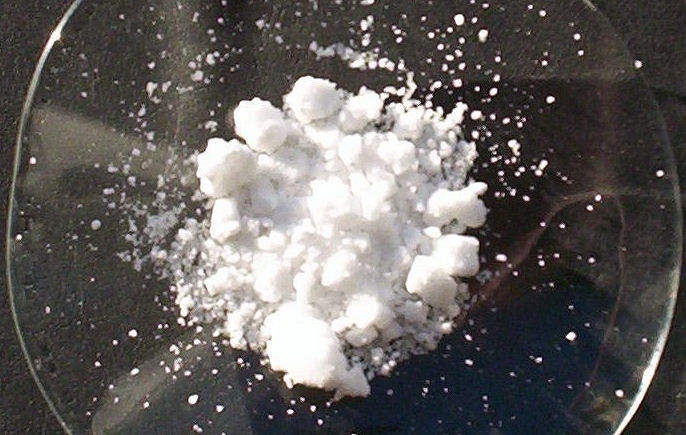
Abb.: पाक्यः । Reine Pottasche
[Bildquelle: Walkerma / Wikipedia. -- Public domain]
"CARBONATE OF POTASH. Sans. यवाक्षार, Yavākṣāra.
THIS article, as well as the next one called sarjikākṣāra, is mentioned by Susruta, and has been used in medicine from a very remote period. Yavākṣāra is prepared by reducing to ashes the green spikes of the barley (Hordeum hexastichum) , dissolving the ashes in water, straining the solution through thick cloth, and evaporating it over the fire. The resulting salt is a clear amorphous powder with a saline and partly acid taste. Chemically it is carbonate of potash with some impurities. Yavākṣāra is described as stomachic, laxative and diuretic. It is used in urinary diseases, dyspepsia, enlarged spleen and other enlargements of the abdominal viscera. A decoction of chebulic myrobalan and rohitaka bark is given with the addition of carbonate of potash and long pepper in enlarged spleen and liver, and in tumours in the abdomen called gulma. In strangury or painful micturition, carbonate of potash with sugar is considered a very efficacious remedy. It enters into the composition of numerous saline medicines."
[Quelle: Dutt, Uday Chand: The materia medica of the Hindus / Uday Chand Dutt. With a glossary of Indian plants by George King. -- 2. ed. with additions and alterations / by Binod Lall Sen & Ashutosh Sen. -- Calcutta, 1900. - XVIII, 356 S. -- S. 87f.]
| 109c./d. pākyo
'tha sarjikākṣāraḥ kāpotaḥ sukhavarcakaḥ पाक्यो ऽथ सर्जिकाक्षारः कापोतः सुखवर्चकः ।१०९ ख। [Bezeichnungen für Natriumkarbonat (Soda):]
|
Colebrooke (1807): "Natron ; alkali."
सर्जिकाक्षार - sarjikākṣara m.: Natriumkarbonat (Soda)
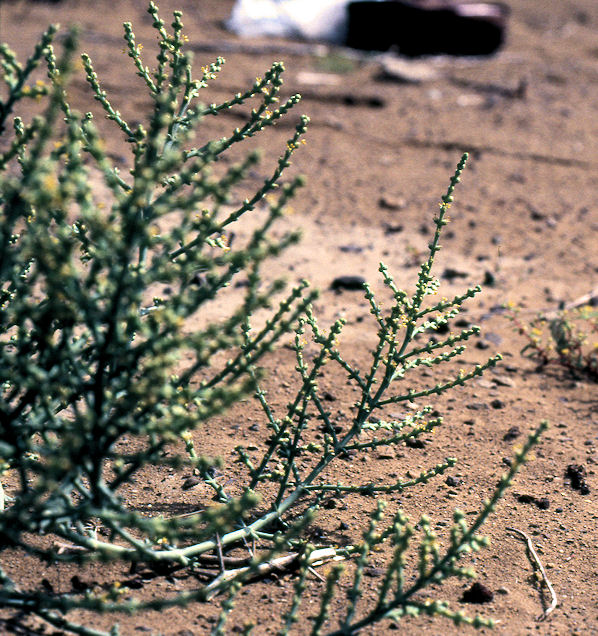
Abb.:
सर्जिकाक्षारः
। Salsola stocksii (Synonym Haloxylon stocksii) -
Salzkraut, Sodakraut, eine der Pflanzen aus der Natriumkarbonat gewonnen
wird, Karachi -
کراچی, Pakistan
[Bildquelle: Gabriele Kothe-Heinrich / Wikipedia. -- GNU FDLicense]
"Barilla, kelp, salsola soda, and natron are all carbonates of soda. Barilla is prepared by burning sea-weed and the plants that grow in the marine lagoons or salt-water lakes of most of the seaboards of South-Eastern Asia. In the Archipelago, quantities are produced by the settled populations or by migratory fishing races, and it IS largely brought to India from the Persian Gulf. In India, barilla is obtained from Salicornia Arabica, W., of Sunderbuns and the Coromandel coast, and from S. Indica, W., of Malabar. The genus Mesembryanthemum is rich in alkaline carbonates, and usually frequents the seashore. Dr. Roxburgh was of opinion that the two species of Salicornia and one of Salsola, which are extremely abundant on the Coromandel coast might be made to yield barilla sufficient to make soap and glass for the whole world. There are now more economical processes for procuring this substance from dhobi 8 earth (native carbonate of soda), and from sea salt But Dr. Helenus Scott received the gold medal of the Society of Arts, for sending from Bombay the mineral alkali, the Saji Matti of Bengid, the Applacaram of the Tamil people, which occurs in immense quantities in many parts of Bengal, especially in the districts of Monghir, Pumea, and Cawnpur. It contains from 40 to 50 per cent of carbonate of soda, with organic matters, clay, sand, and oxide of iron. The salts can be extracted by washing the mineral without incineration, but the organic matter is dissolved at the same time, and gives a deep brown solution from which pure crystals cannot be obtained. The firing destroys this substance, and then the solution is colourless ; but care must be taken not to push the heat beyond low redness, for the alkali at a higher temperature combines with the sand and clay, and the whole runs into a green glass, insoluble in water. The earth of a large tract of unproductive land in the Puttoocottah and Trevandy taluqs of Tanjore is greatly impregnated with impure carbonate of soda, and a small export trade goes on of dhobi's earth. In the years 1826 to 1830, the late Mr. Hart and Dr. Macleod worked it on the large scale, and about 1000 tons of barilla, containing 26 per cent, of pure alkali, and equal to the best Spanish, was the estimated produce. In Europe, this salt is prepared either by burning sea-weeds and lixiviating the ashes, the product being termed kelp and barilla, or by decomposing common salt by sulphuric acid, and then roasting the resulting sulphate with chalk, sawdust, and fragments of iron. The mass when washed gives the carbonate of soda.
The celebrated lake of Loonar produces six principal varieties of natron salts, to which the natives give the following names : —
- Dulla ;
- Numuck Dulla ;
- Khuppul ;
- Pappree ;
- Bhooskee ; and
- Mahd Khar.
Dulla and Numuck Dulla are used for dyeing silks, fixing colours,—also as medicines, and in the manufacture of bangles.
Of Khuppul, there are two kinds, one of greater value than the other, and this salt is used in fixing the red dyes of cloth.
Pappree is used in the manufacture of bangles, of which there are two manufactories near the lake. When these are in full operation, bangles are manufactured in large quantities, each man being able to manufacture from 600 to 700 daily. The eyesight of these men fails soon, owing to the entire want of protection from the glare of the furnaces."
[Quelle: Balfour, Edward <1813-1889>: Cyclopædia of India and of eastern and southern Asia, commercial, industrial and scientific: products of the mineral, vegetable and animal kingdoms, useful arts and manufactures / ed. by Edward Balfour. -- 3rd ed. -- London: Quaritch. -- Vol. 1. -- 1885. -- S. 281f.]
"DHOBI'S EARTH is a native carbonate of soda, called sajji matti in Hindustani, and applacaram in Tamil and Telugu. It is a whitish-grey, sandy efflorescence, which often covers miles of country where decayed white granite forms the surface soil. This earth begins to accumulate in the dry weather ; immediately after the rains, it can be scraped off the surface to the depth of two or three inches, and by repeated boiling and the addition of a little quicklime the alkali is obtained of considerable strength. With a little care, very clean carbonate of soda can be obtained, fit for the manufacture of toilet soap, white glass, and glazes for pottery. The Nellore, Cuddapah, Masulipatam, and Chingleput districts yield this earth in great quantities ; and it is also found largely at Puducottah, Hyderabad, Bellary, and Mysore. The richest in alkali is from the territories of the Nizam, the quantity of anhydrous carbonate being about 67 per cent. Repeated attempts have been made to prepare barilla from it for exportation, and very fair specimens have been exported at different times, but the moderate price of the carbonate of soda of England, prepared from sea salt, will always prevent this from being a remunerative article of export. The coloured frits for bangle glass, in making which it is used, have lately, however, become an article of export from the Madras Presidency. It exists in immense quantities in many parts of India, in Bengal especially, in the districts of Monghir, Purniah, and Cawnpur. It contains from 40 to 50 per cent, of carbonate of soda, traces of sulphate of soda, organic matter, clay, sand, and oxide of iron. The salt can be extracted by washing the mineral without incineration, but the organic matter is dissolved at the same time, and gives a deep brown solution, from which pure crystals cannot be obtained. Firing destroys this substance, and then the solution is colourless. But care must be taken not to push the heat beyond low redness, for the alkali at a higher temperature combines with the sand and clay, and the whole runs into green glass, insoluble in water."
[Quelle: Balfour, Edward <1813-1889>: Cyclopædia of India and of eastern and southern Asia, commercial, industrial and scientific: products of the mineral, vegetable and animal kingdoms, useful arts and manufactures / ed. by Edward Balfour. -- 3rd ed. -- London: Quaritch. -- Vol. 1. -- 1885. -- S. 936f.]
"CARBONATE OF SODA. Sans. सर्जिकाक्षार Sarjikākṣāra. Vern. Sājji.
Sājji or barilla is produced from several species of salt-worts growing in brackish soil in the Punjab and North-West Provinces. The process of manufacturing Sājji is described in full detail in the "Report on Punjab Products". The plants are cut down during the cold months, dried and burnt in a pit of a hemispherical shape, about six feet in circumference and three feet deep. At the bottom of this pit, one or more inverted gharās or earthen vessels having small holes pierced in their upper portion are buried. The holes are kept closed at the commencement of the operations. Into the pit is thrown a small quantity of the plants and burnt, fresh plants being gradually added to keep up a constant fire, and this is continued till the pit fills up. During this process a liquid matter exudes from the plants. As soon as this is observed the orifices in the gharās are opened and the liquid runs down into them below the fire. After all the liquid has run down, the ashes are stirred up with a stick and covered over with earth. The alkali found in the earthen vessels is Sājji of the first quality, called Sājji lotā because it is found in the lotā or pot. The residuary mass in the pit is crude dirty potash.
Sarjikākṣāra or Sājji, as used in medicine, occurs in porous granular masses of a greyish white colour, and with a strong alkaline taste of soda. Chemically, it consists of carbonate of soda with certain impurities, such as organic matter, sulphate of soda, potash etc. The properties of Sarjikā are said to be like but somewhat inferior to those of yavākṣāra. It is chiefly used in combination with other medicines of its class in the treatment of acidity, dyspepsia, and enlargements of the abdominal viscera. Externally it is used as a caustic. Sājji or barilla, should not be confounded with sājimati or fuller's earth. The latter is earth impregnated with soda and not a barilla. Sājimati occurs in great abundance on the surface of the soil in many parts of India, and is chiefly used in washing cloth.
[...]
A paste made of equal parts of yavākṣāra and Sarjikākṣāra with water is applied to abscesses, for the purpose of opening them."
[Quelle: Dutt, Uday Chand: The materia medica of the Hindus / Uday Chand Dutt. With a glossary of Indian plants by George King. -- 2. ed. with additions and alterations / by Binod Lall Sen & Ashutosh Sen. -- Calcutta, 1900. - XVIII, 356 S. -- S. 88f.]
| 110a./b. sauvarcalaṃ syād rucakaṃ tvakkṣīrā vaṃśarocanā सौवर्चलं स्याद् रुचकं त्वक्क्षीरा वंशरोचना ।११० क। [Bezeichnungen für Sonchal-Salz:]
|
Colebrooke (1807): "Some disjoin the last terms, and make them names of Borax."
सौवर्चल - sauvarcala n.: Sauvarcala
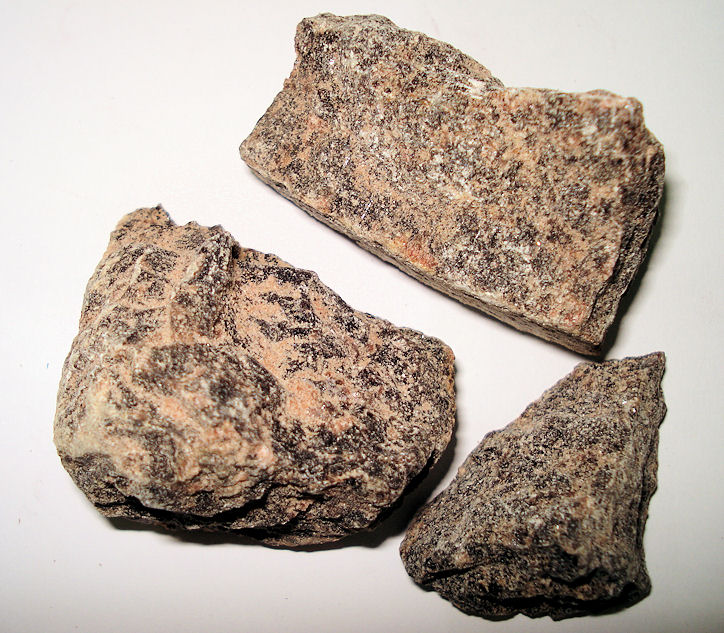
Abb.: सौवर्चलम् । Sonchal Salz
[Bildquelle: Miansari66 / Wikipedia. -- Public domain]
रुचक - rucaka n.: "Leuchtendes", Sonchal-Salz

Abb.: रुचकम् । Sonchal Salz, Markt, Delhi
[Bildquelle: Aleks. --
http://www.flickr.com/photos/toastkid/5257047284/. -- Zugriff am
2011-10-05. --
Creative Commons Lizenz (Namensnennung, keine kommerzielle Nutzung,
share alike)]
"SALT, BLACK.
Kala naniak, Hind. | Sonchal namak, Hind.
To make this medicinal substance, take 1 maund of Sambhar or Dindwa salt, ½ seer of the fruit of Terminalia bellerica, ½ seer of the fruit of Terminalia chebula, ½ seer of Aonla or Emblica officinalis, ½ seer of black sajji or impure carbonate of soda ; all these are put into an earthen pot over a fire, and kept there till scorched ; when about 35 out of 41 seers remain, the pot is taken off, and the black salt is made. About 2 maunds of wood are used. The price is Rs. 3 per maund. It is used as medicine in India and China. In China it seems to contain a little sulphuret of iron, and is given in enlargements of the spleen and liver."
[Quelle: Balfour, Edward <1813-1889>: Cyclopædia of India and of eastern and southern Asia, commercial, industrial and scientific: products of the mineral, vegetable and animal kingdoms, useful arts and manufactures / ed. by Edward Balfour. -- 3rd ed. -- London: Quaritch. -- Vol. 3. -- 1885. -- S. 507]
"CHLORIDE OF SODIUM. Sans. लवण, Lavaṇa.
SUSRUTA describes the following varieties of salts, viz.,
- Sāindhava,
- Sāmudra,
- Viṭ or Viḍ,
- Sauvarcala,
- Romaka,
- Audbhida
- Guṭikā,
- Pāṃśuja, also called Uṣasuta.
The first five in the above list generally pass by the name of pañca lavaṇa or the five salts, and are often used in combination. The other varieties are rarely used in medicine.
[...]
सश्वर्चल Sauvarcala called sonchal or Kālānimak in Hindustani is said to be aromatic, agreeable and digestive, and useful in the same sort of cases as viṭlavaṇa. It is described in the Report on Punjab Products as "a dark colored salt said to be made by dissolving common salt in a solution of "sajimati" (crude soda) and evaporating it ; this salt contains chloride of sodium, sulphate of soda, caustic soda and a little sulphate of sodium, but no carbonate of soda." Sonchal salt is not available in the drug shops of Calcutta. Some Bengali physicians give this name to a crystalline form of rock salt, but up-country physicians always translate sauvarcala as sonchal or kālānimak. The latter interpretation appears also to obtain in the Punjab where a specimen of sonchal salt from Ram Sing, a noted druggist, is said in the Report on Punjab Products, "to be a salt of the same kind as kālānimak.""
[Quelle: Dutt, Uday Chand: The materia medica of the Hindus / Uday Chand Dutt. With a glossary of Indian plants by George King. -- 2. ed. with additions and alterations / by Binod Lall Sen & Ashutosh Sen. -- Calcutta, 1900. - XVIII, 356 S. -- S. 84f.]
"BORAX. Sans. तङ्कन Taṅkana. Vern. Sohāgā.
BORAX was known to the ancient Hindus from a very remote period, and is mentioned by Susruta. It is brought from Tibet across the Himalaya, and from Nepal, and is used in medicine as well as in the arts. It is purified for medicinal use by being steeped for a night in kāñjika, and dried in the sun. Borax is said to be useful in loss of appetite, painful dyspepsia, cough, asthma, skin diseases and diarrhoea. It is also used for procuring abortion and promoting uterine contractions. Borax enters into the composition of numerous formulae for dyspepsia. [...]
Borax enters into the composition of several prescriptions for diarrhoea, along with opium [...]
A mixture of equal parts of borax, long pepper and baberung seeds is given for five days, at the menstrual periods for the purpose of preventing conception. It is also used for procuring abortion and inducing labour pains. Borax rubbed into a paste with the root of Vallaris dichotoma ( bhadravalli ) is applied to diseased nails."
[Quelle: Dutt, Uday Chand: The materia medica of the Hindus / Uday Chand Dutt. With a glossary of Indian plants by George King. -- 2. ed. with additions and alterations / by Binod Lall Sen & Ashutosh Sen. -- Calcutta, 1900. - XVIII, 356 S. -- S. 81f.]
| 110a./b. sauvarcalaṃ syād rucakaṃ
tvakkṣīrā vaṃśarocanā सौवर्चलं स्याद् रुचकं त्वक्क्षीरा वंशरोचना ।११० क। [Bezeichnungen für Tabaxir:]
|
Colebrooke (1807): "Manna of bamboos."
त्वक्क्षीरा - tvakksīrā f.: "Rindenmilch", तबशीर, Tabashir, Tabaxir
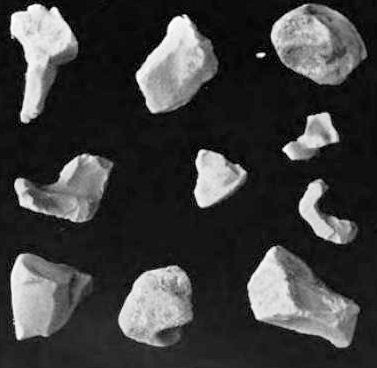
Abb.: त्वक्क्षीरा । Tabaxir
[Bildquelle: George Frederick Kunz (1856 – 1932) / Wikipedia. -- Public
domain
वंशरोचना - vaṃśarocanā f.: "Bambus-Licht",
बंसलोचन, Tabashir, Tabaxir
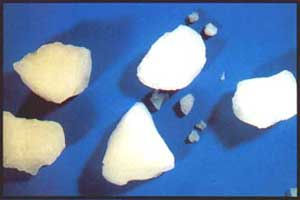
Abb.: वंशरोचना । Tabaxir
[Bildquelle:
http://www.gpo.or.th/various_pharmacy/tabashir.html. -- Zugriff am
2011-10-05]
"Tabashir. A siliceous concretion found in the joints of the female bamboo. It is partly soluble in water, bluish white, concrete, adhesive to the tongue. It is composed of silica, 90.5 ; potash, 1.1 ; peroxide of iron, 6.9 ; alumina, 0.4 per cent. The Persians deem it tonic and aphrodisiac, the Arabs suppose it to be astringent ; but from its composition we are warranted in supposing it to be entirely inert. It resists acids, is indestructible by fire, and forms, on being fused with alkalies, a sort of glass. It is much esteemed by the Hindus, Persians, and Arabs as a powerful tonic, and is said by them to have great efficacy in internal bruises. It readily imbibes all the volatile and fat oils, which produce an opacity. If the oils be tinted with acetate of copper, anchusa root, beech-nut, sulphuric acid, or malic acid, the tabashir assumes respectively the colours of the emerald, ruby, chrysoberyl, pink topaz, and Brazilian topaz. Mr. W. Lange has ascertained that the silicium in the sap of plants exists exclusively as a hydrate of silicic acid in very dilute solution. A similar substance has been found in jungle grass. In Ajmir it is used as an aphrodisiac, and in general debility. One massa is the dose, and it is sold at two tolas for one rupee."
[Quelle: Balfour, Edward <1813-1889>: Cyclopædia of India and of eastern and southern Asia, commercial, industrial and scientific: products of the mineral, vegetable and animal kingdoms, useful arts and manufactures / ed. by Edward Balfour. -- 3rd ed. -- London: Quaritch. -- Vol. 3. -- 1885. -- S. 797.]
"Bamboo manna is the Vansa-lochana of the Indian physicians ; in the Nirghantas it bears many synonyms, such as Vansa-rochana, Tvak-kshira "bark-milk," Vansa-karpura "bamboo camphor," Vansa-sarkara " bamboo sugar," Vansahva " bamboo sacrifice," Subhra, and Sita "white," &c. It is considered to be strengthening, tonic, cold, and sweet; to alleviate thirst, and to avert phthisis, fever, asthma, cough, biliousness, skin diseases, and Vayu (morbid affections of the windy humor). As an example of the way in which it is prescribed, the following formula for making the Sitopaladi-churna will he found in Sarangadhara :—Bamboo manna 8 parts, long pepper 4, cardamoms 2, cinnamon 1, sugar 16. Powder and mix. Dose about 60 grains, to be given with honey and ghi in phthisis and cachexia.
The belief in the strengthening properties of bamboo manna appears to have originated among the aboriginal tribes of India, as on the West Coast it is the first solid food which the Thana Kolis give their children. The same belief seems to have prevailed in Borneo, as Marco Polo relates that pieces of this substance were let in under the skin by the natives to make the body wound-proof.
We hold with Salmasins that bamboo manna was the substance known to the Greeks as σακχαρ σακχαρον, and described by them as a white, concreted or crystalline substance like common salt, because there was no kind of sugar prepared from the sugar-cane, answering to this description, known in India in the time of Dioscorides. The name Sarkara, which signifies "grit, pebbles, sand," was applied by Hindu writers at that time to several substances, viz., Guda or molasses in a dry granular state, the only kind of cane-sugar then in use in India; Yavasa-sarkara, the concrete manna of Alhagi; and Vansa sarkara, the concretion found in the bamboo. The Sanskrit name Khanda was also applied to Guda, which is the substance known in the vernaculars as Gur or Gul, and is still the kind of sugar most used by the Hindus. Pale crystalline sugar, the Chini of the bazars, does not appear to have been known until some 400 years after the date of Dioscorides.
Under the name of Tabashir, a corruption of the Sanskrit Tvak-kshira, bamboo manna was known to the early Arab travellers in the East; the port of Thana, on the West Coast of India, was famous for its Tabashir in the time of Idrisi (1135) and supplied it to all marts. Ibn Sina describes Tabashir as astringent and stomachic, useful in erysipelas and to alky thirst in bilious dyspepsia, cardiacal, and strengthening. As a local application it is used to relieve the heat and irritation caused by aphthous eruptions along with pounded rose leaves. Later Mahomedan writers upon the Materia Medica of the East have added nothing of importance to Ibn Sina's account of the drug. Flückiger (Zur Geschichte des Tabaschir, Zeit. des allg. österr. Apoth. Ver. Nr. 14 u. 15,1887) mentions a list of Indian goods on which transit duty was levied at Aden in 1270 ; in it Tabashir is mentioned together with tamarinds and camphor. He also draws attention to a remarkable connection between Tabashir and ivory ashes, generally known by the name of Spodium. Idrisi, in the middle of the 12th century, points out that the latter was used to adulterate the former, while others of a different opinion assign a greater value to Spodium. Garcia d'Orta (Colloquios 51) mentions both Tabashir and Spodium, which he considers to be Pompholyx or Turtia (white of zinc ? calamine ?), and states that in Persia and Arabia Tabashir was generally paid for by its weight in silver ("o preço ordinario na Persia e Arabia é a peso de prata "); he also describes black or grey Tabashir, which was of less value and was obtained by burning the bamboo cane. Flückiger remarks that it is most likely that the name " Spodium da canna " was given to this black Tabashir or perhaps to the ashes of the cane, and that it might be owing to this circumstance that in later times the flame Spodium came to be applied to animal charcoal (boneblack). The idea of black seems not to have been connected with the original Greek name σποδος (ashes). Flückiger also draws attention to the Latin translation of a Persian Karabadin or Pharmacopoeia by the Carmelite Friar P. Angelus, published in Paris in 1681, in which Tabashir is spoken of as pseudospodium, anti-spodium, and spodium arabicum. Rheede as well as Rumphius notice Tabashir, but it does not appear to have attracted much attention in Europe until Dr. Patrick Russell drew the attention of the Royal Society to it, and induced James Louis Macie to make an analysis, which showed that it consisted principally of silica.
Further information on Tabashir may be obtained from Prof. Flückiger's papers above mentioned, and a paper by Dr. Brandis in the Indian Forester, March, Vol. XIII.
Description.—Tabashir consists of irregularly-shaped fragments of an opaque white or bluish opalescent colour, the larger pieces are about an inch in diameter, concavo-convex, and have evidently derived their form from the joint of the bamboo in which the deposit has collected. The raw article is blackened and dirty, having apparently been obtained by burning the bamboos, or on account of the presence of insects ; to make it fit for use it is calcined, when it becomes perfectly clean."
[Quelle: Pharmacographia indica : a history of the principal drugs of vegetable origin met with in British India / by William Dymock [1834-1892], C. J. H. Warden and David Hooper [1858-1947]. -- Bd. 3. -- London, 1893. -- S. 587ff.]
Moringaceae - Bennussgewächse
| 110c./d. śigrujaṃ śvetamāricaṃ moraṭaṃ mūlam aikṣavam शिग्रुजं श्वेतमारिचं मोरटं मूलम् ऐक्षवम् ।११० ख। [Bezeichnungen für Samen von Moringa oleifera Lam. 1783 - Meerettichbaum - Ben Oil:]
|
Colebrooke (1807): "Seed of morunga. Of Hyperanthera or Guilandina morunga."
Moringa pterygosperma Gaertn = Moringa oleifera Lam. 1783
शिग्रुज - śigruja n.: Samen von śigru m.: Moringa oleifera Lam. 1783 - Meerettichbaum - Ben Oil
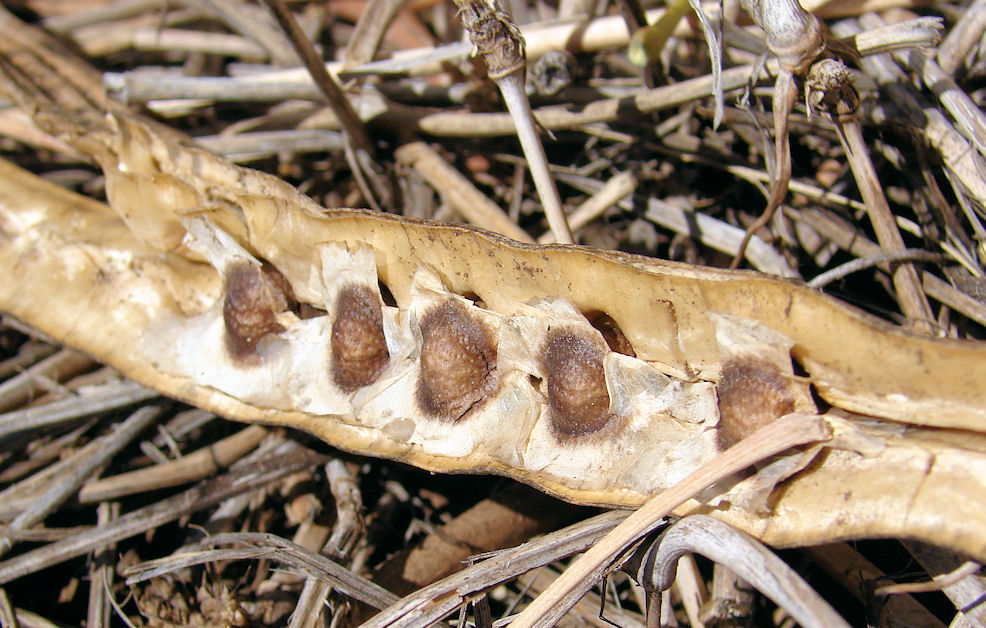
Abb.: शिग्रुजानि । Samen von śigru m.: Moringa oleifera Lam. 1783 -
Meerettichbaum - Ben Oil
[Bildquelle: Forest & Kim Starr. --
http://www.hear.org/starr/images/images/plants/full/starr-070207-4292.jpg. -- Zugriff
am 2011-10-05. --
Creative Commons Lizenz (Namensnennung)]
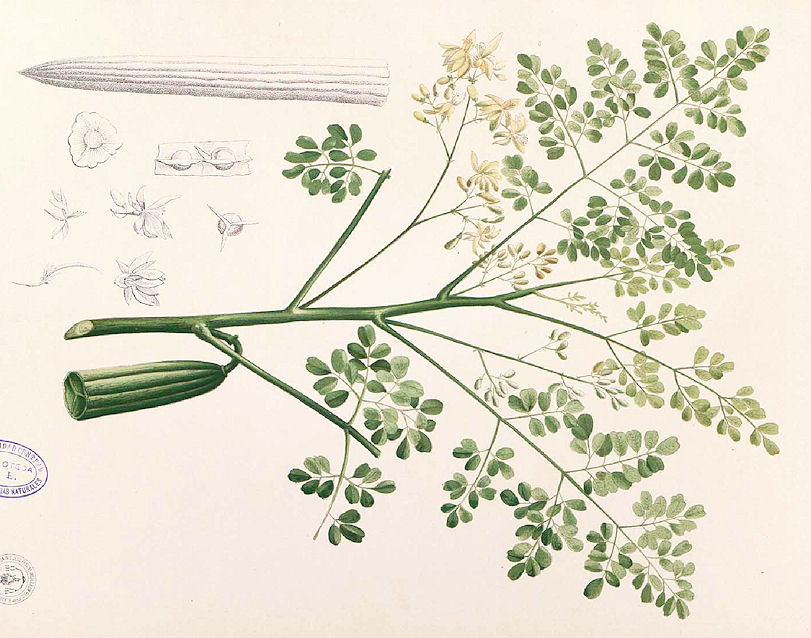
Abb.: शिग्रुः । Moringa oleifera Lam. 1783 - Meerettichbaum - Ben Oil
[Bildquelle: Flora de Filipinas, 1880 / Wikimedia. -- Public domain]
श्वेतमारिच - śvetamārica n.: "weißes Pfefferprodukt", Samen von Moringa oleifera Lam. 1783 - Meerettichbaum - Ben Oil
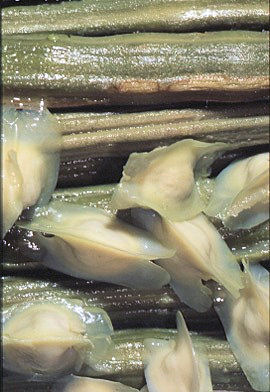
Abb.: श्वेतमारिचानि । Samen von Moringa oleifera Lam. 1783 -
Meerettichbaum - Ben Oil
[Bildquelle: Mark E. Olsen / Wikimedia. --
Creative
Commons Lizenz (Namensnennung)]
"MORINGA PTERYGOSPERMA, Gdrin.
Fig.—Wight Ill. I. 186, t. 77 j Bedd. Fl. Syl, t 80. The Horse-radish tree (Eng.)
Hab.—India. The fruit, bark, gum, seeds and root.
[...]
History, Uses, &C.—The root of this very common-tree, the Sobhanjana, Murungi and Danshamula (pungent root) of Sanskrit writers, is described by the Hindus as acrid, pungent, stimulant and diuretic, and is applied externally as a rubefacient.
The seeds are said to be stimulant and are called Sveta maricha (white pepper). The Bhavaprakasa mentions two varieties of the tree, viz., white and red.*
* Probably Moringa concanensis Nimmo, which has red flowers.
The white is said to be the stronger rubefacient, but the red is preferred for internal use; it is given in ascites arising from enlargement of the liver and spleen. In internal and deep-seated inflammation and abscess (vidradhi), a decoction of the root bark is recommended to be given with the addition of asafoetida and rock salt. The root bark is besides used externally as a plaster, and the inflamed part fomented with its decoction. A decoction of the root bark is considered useful in calculous affections.
The seeds are an ingredient in some stimulant applications.
The gum of the tree, mixed with sesamum oil, is recommended to be poured into the ears for the relief of otalgia; it is also rubbed with milk and applied in headache to the temples. Mahometan writers describe Sahjna flowers as hot and dry, and consider that they expel cold humours, disperse swellings, act as a tonic and diuretic, and increase the flow of bile. The juice of the root with milk is diuretic, antilithic and digestive, and is useful in asthma. A poultice made with the root reduces swellings, but is very irritating and painful to the skin. The pods are a wholesome vegetable, and act as a preventive against intestinal worms (vide Makbzan, article Sahjna). Ainslie mentions the use of the Morunghy root by Europeans as a substitute for Horseradish. He also says that the native doctors prescribe it as a stimulant in paralytic affections and intermittent fever in doses of about one scruple ; that they also employ it in epilepsy and hysteria, and consider it a valuable rubefacient in palsy and chronic rheumatism. He wrongly supposes the seeds to be the Hab-el-ban of the Arabians. Rumphius and Loureiro state that the bark is emmenagogue and even abortifacient. In Bengal half ounce doses of the bark are said to be used to procure abortion. In Madras the following prescription is said to be a good remedy for scorpion stings:—Moringa bark and nut of each 4 ozs., tobacco 2 ozs., gunpowder 2 drachms. Make into a smooth paste, roll into a pencil and dry. When required rub it with a little water over the sting.
According to Fleming, the oil of the seeds is used as an external application for rheumatism in Bengal.
In India the root is generally accepted by Europeans as a perfect substitute fur Horse-radish. The unripe pods are used as a vegetable ; they may be boiled and served with melted butter, or cut in pieces and mixed with curries. The flowers are eaten in curries, and also fried with butter. The young leaves are boiled with onions and spices and used in the same manner. A decoction of the root bark is used as a fomentation to relieve spasm. In the Concan the bark of the wild tree is ground with Plumbago root, pigeon's dung, and chicken's dung and applied to destroy Guinea-worms. Four tolas of the juice of the leaves of the cultivated tree are given as an emetic. The gum is said to be used to produce abortion, but it is difficult to obtain any reliable evidence upon a point of this nature ; it would be quite possible to use it as a tent to dilate the os uteri, as it is very tough, and swells rapidly when moistened. In many parts of India the right of collecting the pods upon Government lands, for sale as a vegetable, is leased; they are never allowed to ripen, and the oil is not expressed. The Bengal Pharmacopoeia furnishes formulas for a compound spirit and compound infusion. In the Pharmacopoeia of India the plant is placed in the secondary list, and its principal uses are briefly noticed.
Description.—The fruit is light brown when ripe, a foot or more in length, triangular, ribbed, and composed of three valves containing a soft white pith, and a single row of from 12—18 seeds, which are dark brown, roundish, the size of a pea, and. furnished with three membranaceous wings. The kernel is white, oily and bitter. The gum, when it first exudes is opaque and white ; from exposure to the air it soon becomes pink, and finally of a dull red colour on the surface, the interior remaining white. It occurs in pieces of considerable size, generally more or less vermicular in form, and appears to be only produced upon trees which have been injured by insects. The taste is bland and mucilaginous. In dry air the gum becomes very friable, but in a damp climate it is tough and holds 20 per cent, of its weight of water. The bark of the root has a reticulated light brown external surface ; it is thick, soft, and internally white, and has a pungent odour and taste, exactly like horse-radish. The wood of the root is soft, porous, and yellowish, and has the same properties in a less degree."
[Quelle: Pharmacographia indica : a history of the principal drugs of vegetable origin met with in British India / by William Dymock [1834-1892], C. J. H. Warden and David Hooper [1858-1947]. -- Bd. 1. -- London, 1890. -- S. 396ff.]
| 110c./d. śigrujaṃ śvetamāricaṃ
moraṭaṃ mūlam aikṣavam शिग्रुजं श्वेतमारिचं मोरटं मूलम् ऐक्षवम् ।११० ख। Die Wurzel von Zuckerrohr heißt मोरट - moraṭa n.: Wurzel von Zuckerrohr (Saccharum officinarum L. 1753) |
Colebrooke (1807): "Root of sugarcane."
Vermutlich sind Stecklinge gemeint.
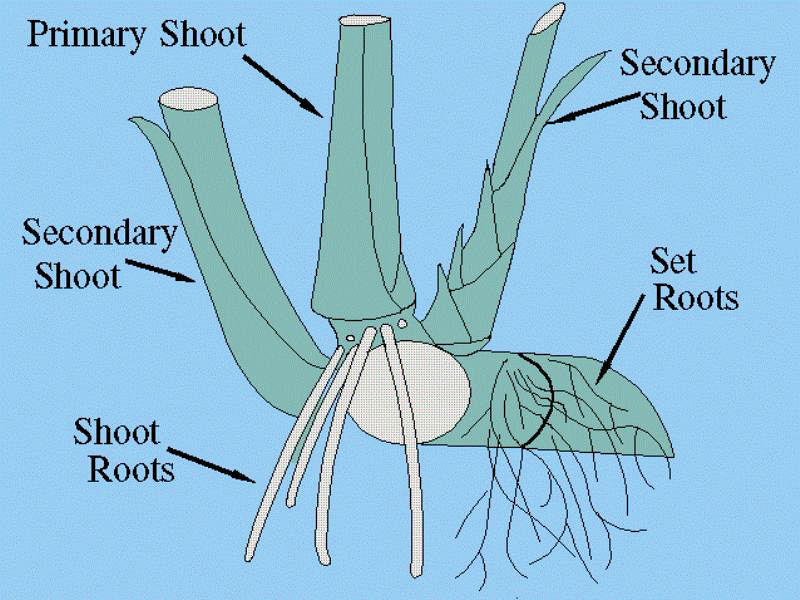
Abb.: मोरटम् । Wurzelsystem des Zuckerrohrs
[Bildquelle:
http://agropedia.iitk.ac.in/?q=content/root-morphology-sugarcane. --
Zugriff am 2011-10-05. -- Fair use]
| 111a./b. granthikaṃ pippalīmūlaṃ
caṭikāśira ity api ग्रन्थिकं पिप्पलीमूलं चटिकाशिर इत्य् अपि ।१११ क। [Bezeichnungen für die Wurzel von Piper longum L. 1753 - Langer Pfeffer - Long Pepper:]
|
Colebrooke (1807): "Root of long pepper."
ग्रन्थिक - granthika n.: Knotiges, Wurzel von Piper longum L. 1753 - Langer Pfeffer - Long Pepper
पिप्पलीमूल - pippalīmūla n.: Wurzel von pippalī f.: Piper longum L. 1753 - Langer Pfeffer - Long Pepper
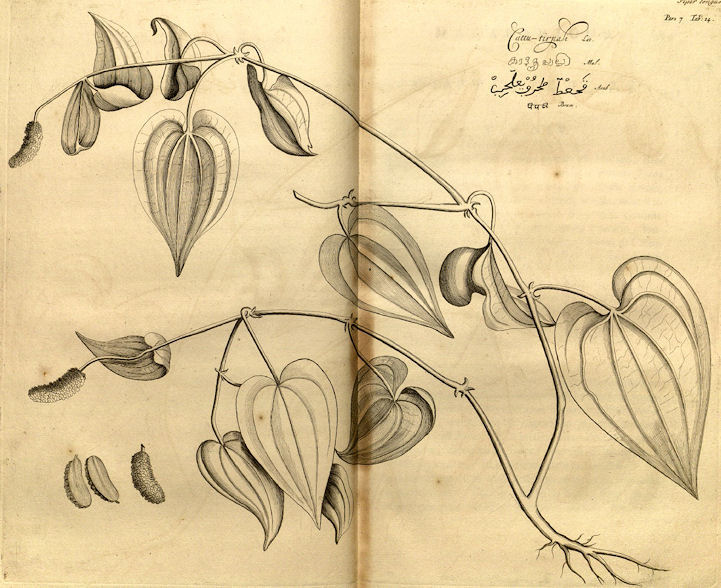
Abb.: पिप्पलीमूलम् । Piper longum L. 1753 - Langer Pfeffer - Long
Pepper
[Bildquelle: Hortus malabaricus VII. Fig. 14, 1686]
चटिकाशिरस् - caṭikāśiras n.: "Spätzinnenkopf", Wurzel von Piper longum L. 1753 - Langer Pfeffer - Long Pepper
"Chavica Boxburghii (Miq.) Long Pepper [...]
Description.—Stem somewhat shrubby, the sterile ones decumbent, the floriferous ones ascending, [...]
Wight Icon. t. 1928.
Piper longum, Linn.—Roxb. Fl. Ind. i. 154—Rheede, vii. t. 14.
Banks of watercourses. Circar mountains. South Concans. Bengal
Medical Uses.—This plant is extensively cultivated; the female catkins dried form the long Pepper of the shops. " I have never," says Wight, "met with it except in gardens, and then only as single plants." It is readily propagated by cuttings. The stems are annual, but the roots live several years; and when cultivated, usually yield three or four crops, after which they seem to become exhausted, and require to be renewed by fresh planting. The berries of this species of Pepper are lodged in a pulpy matter like those of P. nigrum. They are at first green, becoming red when ripe. Being hotter when unripe, they are then gathered and dried in the sun, when they change to a dark-grey colour. The spikes are imported entire. The taste of the berries is pungent, though rather faint. On the Coromandel coast the natives prescribe the berries in an infusion mixed with honey for catarrhal affections. The roots are given by natives in palsy, tetanus, and apoplexy. These and the thickest parts of the stem are cut into small pieces and dried, and much used for medical purposes. The berries have nearly the same chemical composition and properties as the black Pepper, and are said to contain pipeline.— (Wight. Ainslie. Lindley.) The root is in great repute among the natives. It is called Peepla-mool in the Taleef-Shereef, where it is described as bitter, stomachic, and producing digestion. In Travancore an infusion of the root is prescribed after parturition, with the view of causing expulsion of the placenta.—Pharm. of India."
[Quelle: Drury, Heber <1819 - 1872>: The useful plants of India : with notices of their chief value in commerce, medicine, and the arts. -- 2d ed. with additions and corrections. London : Allen, 1873. -- xvi, 512 p. ; 22 cm. -- s.v.]
"PIPER LONGUM, Linn. Fig.—Bentl. and Trim., t. 244; Miq. III. Pip., t. 30; Hayne, Arnz. Gewächs. xiv., t. 20; Wight Ic., t. 1928; Rheede, Hort. Mal. vii. t. 14.
Hab.—Hotter provinces of India.
[...]
History, Uses, &c.—As we have already stated, we think it highly probable that long pepper was the kind of pepper first known to the ancient inhabitants of Western Asia and Europe. (See P. nigrum.) In Sanskrit works on medicine, P. longum is described under the name of Pippali, and bears the synonyms of Chapala, Pala, Magadhi "growing in South Bihar," Kana, Shaundi, &c. It is considered to be digestive, sweet, cold, bitter, emollient and light; useful in rheumatism, asthma, cough, abdominal enlargements, fever, leprosy, gonorrhoea, piles and spleen. Old long pepper is to be preferred to fresh. A mixture of long pepper, long pepper root, black pepper and ginger in equal parts, is prescribed by several writers as a useful combination for catarrh and hoarseness. As an alterative tonic, long pepper is recommended for use in a peculiar manner. An infusion of three long peppers is to be taken with honey on the first day, then for ten successive days the dose is to be increased by three peppers every day, so that on the tenth day the patient will take thirty at one dose. Then the dose is to be gradually reduced by three daily, and finally the medicine is to be omitted. Thus administered, it is said to act as a valuable alterative tonic in. paraplegia, chronic cough, enlargements. of the spleen and other abdominal viscera. Long pepper and black pepper enter into the composition of several irritating snuffs; boiled with ginger, mustard oil, buttermilk and curds, it forms a liniment used in sciatica and paralysis. In the Concan the roasted aments are beaten up with honey and given in rheumatism ; they are also given powdered with black pepper and rock salt (two parts of long pepper, three of black, and one of salt) in half tola doses for colic. Mahometan writers,, under the name of Darfilfil, describe long pepper as a resolvent of cold humours; they say it removes obstructions of the liver and spleen, and promotes digestion by its tonic properties; moreover, it is aphrodisiacal, diuretic, and emmenagogue. Both it and the root (Filfil-muiyeh) are much prescribed in palsy, gout, lumbago, and other diseases of a similar nature. A collyrium of long pepper is recommended for night blindness; made into a liniment it is applied to the bites of venomous reptiles. We learn from Roxburgh (Flora Indica, I., p. 155) "that it is in Bengal only that Piper longum is cultivated for its pepper; When the ament is full-grown, it is gathered and daily exposed to the sun till perfectly dry; after which it is packed in bags for sale. The roots and thickest part of the creeping stems, when cut into small pieces and dried, form a considerable article of commerce all over India, under the name of Pippali-mula, for which purpose it is particularly cultivated in many of the valleys amongst the Sircar mountains; This sort is. more esteemed, and bears a higher price than that of Bengal, where by far the largest portion is cultivated. It, as well as the pepper, is chiefly employed medicinally, and the consumption of both these drugs is very great." Piper longum was formerly cultivated at Poway, near Bombay; it appears to grow well in gardens in Bombay, but requires plenty of manure.
Pippali-mula, with the synonyms Kana-mula, Katu-granthi, Ushana-granthika, Chataka and Chataka-shira, is described in the Nighantas as having the same properties as long pepper. P. Chaba, which produces the long pepper of European commerce, is the Chavi, Chavika and Chavya of Sanskrit writers. It is considered to have the same properties as P. longum. The aments are sold in the bazars as Mothi pippali, and the stem as Chab, Chai or Chavak.
The oblong black pepper of Theophrastus (H. P., ix., 22) was probably long pepper. Dioscorides, in his article upon the three peppers, mentions a pepper root, and says it resembles Costus, has a hot taste, and causes salivation when chewed. This drug was probably Galangal, which is known as Pan-ki-jar or root of Piper Betle, because its odour somewhat resembles that of Betle leaves."
[Quelle: Pharmacographia indica : a history of the principal drugs of vegetable origin met with in British India / by William Dymock [1834-1892], C. J. H. Warden and David Hooper [1858-1947]. -- Bd. 3. -- London, 1893. -- S. 176ff.]
| 111c./d. golomī bhūtakeśo nā patrāṅgaṃ raktacandanam गोलोमी भूतकेशो ना पत्राङ्गं रक्तचन्दनम् ।१११ ख। [Bezeichnungen für das Rhizom von Acorus calamus L. - Kalmus - Sweet Flag:]
|
Colebrooke (1807): "Root of sweet-flag."
गोलोमी - golomī f.: Acorus calamus L. - Kalmus - Sweet Flag

Abb.: गोलोमी । Acorus calamus L. - Kalmus - Sweet Flag
भूतकेश - bhūtakeśa m.: Gespenster-Haar, Rhizom von Acorus calamus L. - Kalmus - Sweet Flag
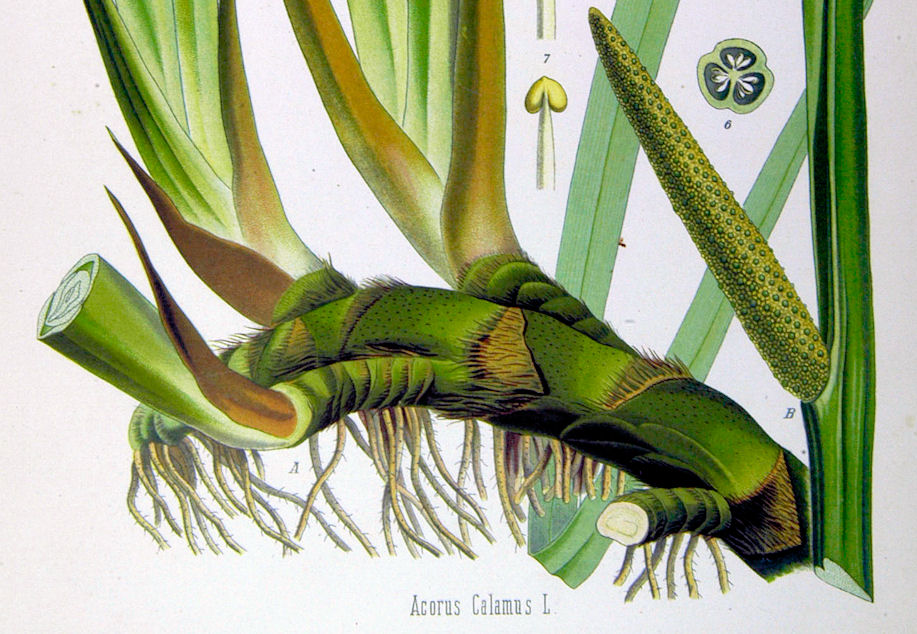
Abb.: भूतकेशः । Rhizom von Acorus
calamus L. - Kalmus - Sweet Flag
[Bildquelle: Köhler, 1883-1914]
"Acorus calamus (Linn.) N. O. Orontiacaeae. Sweet-flag, Eng. Bach, Hind. Vach, Duk. Vashambu, Tam. Vasa, Vadaja, Tel. Vashampa, Mal. Bach, Saphed-bach, Beng.
Description. — Perennial, semi-aquatic; rhizome thick, with long roots; leaves erect, 2-3 feet, sword-shaped; stalk leaf-like, but thicker below the spadix; spadix a foot above the root, spreading, 2-3 inches long, covered with a mass of numerous thick-set pale-green flowers, fragrant when bruised; petals six; capsules 3-celled. Fl. May—June.—Roxb. Flor. Ind. ii. 169.—A. odoratus, Linn.—Rheede, xi. t. 60.—Damp marshy places. Malabar.
Medical Uses. — An aromatic bitter principle exists in the rhizomes, for which reason they are regarded as useful additions to tonic and purgative medicines, being much given to children in cases of dyspepsia, especially when attended with looseness of bowels. Beneficially employed also in chronic catarrh and asthmatic complaints. Dr Pereira has remarked that the rhizomes might be substituted for more expensive spices or aromatics. The flavour is greatly improved by drying. In Constantinople they are made into a confection, which is considered a good stomachic, and is eaten freely during the prevalence of epidemic disease. They are supposed, moreover, to be an antidote for several poisons.—(Pereira. Thomson. Ainslie.) In low fevers they are considered an excellent stimulant diaphoretic, and also very serviceable in atonic and choleraic diarrhoea, and as a useful external application in chronic rheumatism, the powdered rhizome being rubbed up with Cashew spirit. Dr A. T. Thomson notices the root-stock favourably as an antiperiodic, and Dr Royle employed it successfully in intermittent fevers. It is also highly useful for destroying and keeping away insects.—Pharm. of India.
Economic Uses.—The leaves contain an essential oil, to which they owe their fragrance, and which in England is used by the perfumers, mixed with the farina of the rhizomes, in the manufacture of hair-powders. They are also used for tanning leather and perfuming various substances.—Ainslie."
[Quelle: Drury, Heber <1819 - 1872>: The useful plants of India : with notices of their chief value in commerce, medicine, and the arts. -- 2d ed. with additions and corrections. London : Allen, 1873. -- xvi, 512 p. ; 22 cm. -- s.v.]
| 111c./d. golomī bhūtakeśo nā
patrāṅgaṃ raktacandanam गोलोमी भूतकेशो ना पत्राङ्गं रक्तचन्दनम् ।१११ ख। [Bezeichnungen für Pterocarpus santalinus L. f. 1781 - Rotes Sandelholz - Red Sandal Wood:]
|
Colebrooke (1807): "Red-wood."
पत्राङ्ग - patrāṅga n.: "Feder-Gliedriges", Flügelfrucht, Pterocarpus santalinus L. f. 1781 - Rotes Sandelholz - Red Sandal Wood
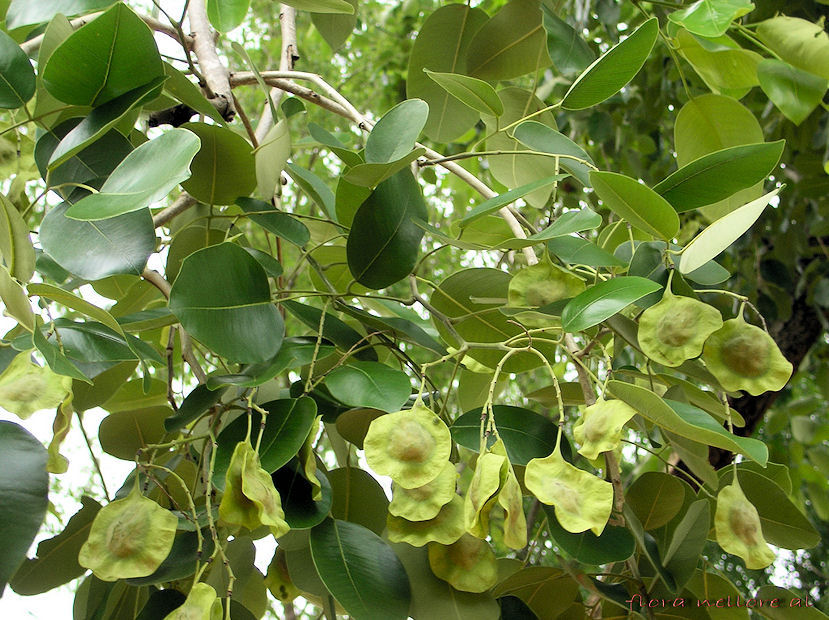
Abb.: पत्राङ्गम् । Pterocarpus santalinus L. f. 1781 - Rote
Flügelfrucht - Sandalwood Paduak, Penchala Kona, Nellore District -
శ్రీ అమరజీవి పొట్టి శ్రీరాములు నెల్లూరు జిల్లా,
Andhra Pradesh
[Bildquelle: Lalithamba. --
http://www.flickr.com/photos/45835639@N04/4665047219/. -- Zugriff am
2011-03-04. --
Creative
Commons Lizenz (Namensnennung)]
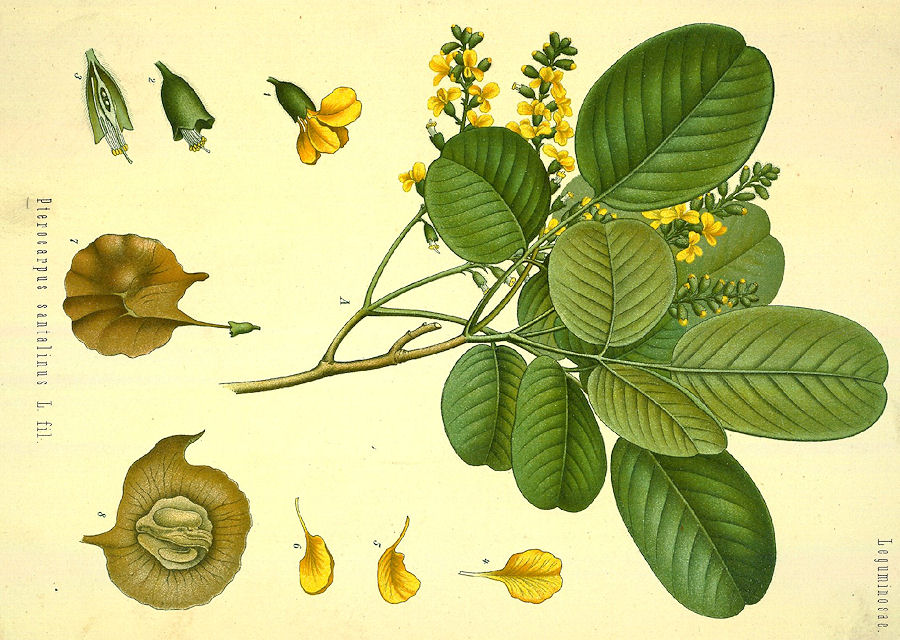
Abb.: पत्राङ्गम् । Pterocarpus santalinus L. f. 1781 - Rote
Flügelfrucht - Sandalwood Paduak
[Bildquelle: Köhler, 1883-1914]
रक्तचन्दन - raktacandana n.: Rotes Sandelholz

"Pterocarpus santalinus.
[...]
It is abundant on the low hills about the Cuddapah and North Arcot forests and the southern part of the Kurnool district, and Colonel Beddome has seen a few trees in the Godavery forests, but he never met with it elsewhere in the Madras Presidency, and it is not, he believes, found anywhere else in India. The wood is of a fine grain and bright garnet colour, which deepens on exposure to the air. It is beautifully streaked, very hard and heavy, and takes a fine polish ; it is much used and highly prized by the natives for building purposes, and for turnery in Madras and the districts in which it grows ; it is also largely exported from Madras as a dye-wood, and used as ballast ; it is not often found over 3½ or 4 feet in girth and about 20 to 28 feet in height ; the largest trees reach 4½ feet in girth, but are then much heart-shaken or hollow. The logs are often notched at both ends, or cut with a hole as for a rope, and are much worn externally from being dragged along the ground ; other wood, as also indeed ivory tusks, are sometimes perforated for the like purpose. A bandy-load of selected logs will sell for as much as Rs. 200, i.e. twenty logs at 10 rupees each ; the roots and stumps are used for dyeing purposes, and sell at 6 to 9 rupees the 1000 lbs. The cattle during the dry season are much fed upon the leaves of this tree, and young saplings are often bodily cut down by thousands by the cowherds. In the four years 1852-53 to 1855-56, there was exported from Madras 179,815 cwt., value Rs. 2,20,983, the destination chiefly being the United Kingdom, Indian French ports, Pegu, and Bengal. It is principally shipped to England from Calcutta in billets from 2 to 10 inches diameter, generally without sap, and sometimes in roots and split pieces. This will explain much of the shipments from Madras to Calcutta. Its timber is chiefly used by dyers and colour manufacturers, also to colour medicine preparations. Its colouring matter is called santalin, and forms a beautiful colour, but precipitates with many metallic solutions. It is employed to dye lasting reddish-brown colours on wool ; it yields its colouring matter to ether and alcohol, but not to water. With different mordants it yields various shades of red, but these are said not to be permanent. Indian practitioners sometimes recommend it in powder in conjunction with certain herbs, and mixed with gingelly oil, as an external application and purifier of the skin after bathing. Its red colouring matter also acts as a diaphoretic, like gentian. It is applied to the forehead in headache, and also as a cosmetic."
[Quelle: Balfour, Edward <1813-1889>: Cyclopædia of India and of eastern and southern Asia, commercial, industrial and scientific: products of the mineral, vegetable and animal kingdoms, useful arts and manufactures / ed. by Edward Balfour. -- 3rd ed. -- London: Quaritch. -- Vol. 3. -- 1885. -- S. 302]
"PTEROCARPUS SANTALINUS, Linn, fil.
Fig.—Bedd. Fl. Sylv., t. 22; Bentl. and Trim., t. 82.
Red Sanders
Hab.—Western Peninsula.
[...]
History, Uses, &c.—According to Sanskrit writers there are three kinds of sandalwood, Srikhanda or white, Pitachandana or yellow, and Raktachandana or red. The first two are the dark and light-coloured wood of Santalum album. Upon the subject of red sandalwood, Dutt (Materia Medica of the Hindus, p. 154,) has the following remark:—"It has been a question how the wood of Pterocarpus santalinus, which is nearly inodorous, came to be called by the name of Raktachandana in Sanskrit and the vernaculars of India. I am inclined to think that it is owing to the similarity in the uses to which the Hindus put both these articles. Both sandalwood and red sandalwood are rubbed on a piece of stone with water, and the emulsions used after bathing and in religious services." Hindu physicians consider red sandalwood to be astringent and tonic; they use it as a cooling application to inflamed parts and to the head in headache; as an external application it is supposed to be more powerful than white sandalwood, given internally to be less, so the two are often combined, and are considered to have similar properties. Mahometan writers follow the Hindus in describing the three kinds of sandalwood and their uses. The author of the Shafa-el-askam says that in bilious fluxes white sandal is used, when blood is being passed red sandal, and when the stools contain both bile and blood the two woods are combined. This treatment must be based upon the doctrine of signatures. Red sanders wood is well known in Europe as an ingredient in French polish."
[Quelle: Pharmacographia indica : a history of the principal drugs of vegetable origin met with in British India / by William Dymock [1834-1892], C. J. H. Warden and David Hooper [1858-1947]. -- Bd. 3. -- London, 1893. -- S. 462.]
"Pterocarpus santalinus (Linn.) Red Sandal-wood
[...]
Description. — Tree, 60 feet or more; [...]
W. & A. Prod. i. 266.—Roxb. Fl. Ind. iii. 234.
Coromandel. Cuddapah. North Arcot. Godavery forests.
Medical Uses.—The wood is dark red with black veins, close, capable of good polish, and sinking in water. It is known in commerce as the Red Sandal-wood which is used chiefly by dyers and colour manufacturers. Also employed to colour several officinal preparations, such as the compound tincture of lavender. This deep-red colouring matter is apparently of a resinous nature. It forms beautifully-coloured precipitates with many metallic solutions. It also yields a kind of dragon's-blood. The wood powdered and mixed with oil is used for bathing and purifying the skin. Also given internally in haemorrhages in powders ground up with milk; and externally, is mixed with honey in case of scabies. Also in certain cases of ophthalmia and sore eyes, beaten up into a paste and applied to the eyes.—Roxb. Ainslie. Lindley."
[Quelle: Drury, Heber <1819 - 1872>: The useful plants of India : with notices of their chief value in commerce, medicine, and the arts. -- 2d ed. with additions and corrections. London : Allen, 1873. -- xvi, 512 p. ; 22 cm. -- s.v.]
| 112a./b. trikaṭu tryūṣaṇaṃ vyoṣaṃ triphalā tu phalatrikam त्रिकटु त्र्यूषणं व्योषं त्रिफला तु फलत्रिकम् ।११२ क। [Bezeichnungen für die Gewürzdreifaltigkeit von
|
Colebrooke (1807): "Three spices. Black pepper, dry ginger, and long pepper."
त्रिकटु - trikaṭu n.: die drei Scharfen
त्र्यूषण - tryūṣaṇa n.: die drei Hitzigen
व्योष - vyoṣa n.: das Glühende
śuṇṭhī f.: Zingiber officinale Roscoe 1807 - Ingwer - Ginger
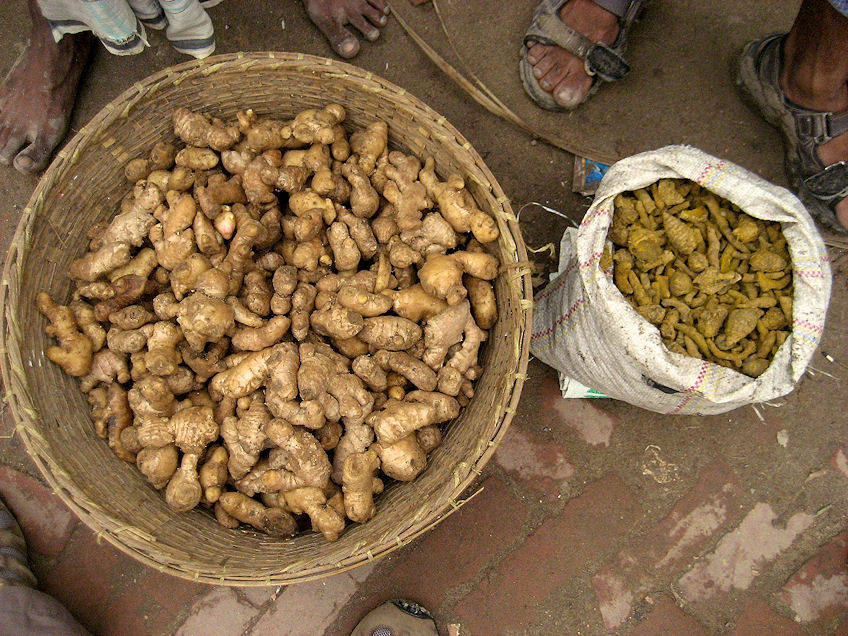
Abb.: शुण्ठी । Zingiber officinale Roscoe 1807 - Ingwer - Ginger,
Bangladesh
[Bildquelle: Terry Sunderland / CIFOR. --
http://www.flickr.com/photos/cifor/5939259556/. -- Zugriff am
2011-10-05. --
Creative Commons Lizenz (Namensnennung, keine kommerzielle Nutzung,
keine Bearbeitung)]
"ZINGIBER OFFICINALE, Roscoe. Sans. Ārdraka, Sringavera. Vern. Ādā, Beng. Ādrak, Hind. Ginger is described as acrid, heating, carminative and useful in dyspepsia, affections of the throat, head and chest, piles, rheumatism, urticaria, dropsy, etc. It is much used as a carminative adjunct along with black pepper and long pepper under the name of trikatu or the three acrids. The dried root is called Nāgara, Sunti and Mahaushadha in Sanskrit. In addition to possessing the properties of ginger it is said to be laxative.
Ginger with salt taken before meals, is highly praised as a carminative. It is said to purify the tongue and throat, increase the appetite and produce an agreeable sensation. Ginger forms the active ingredient of several medicines for dyspepsia and haemorrhoids.
Samasarkara churna. Take of cardamoms one part, cinnamon
two parts, flowers of Mesua ferrea ( nāgakesara) three parts, black pepper four parts, long pepper five parts, dried ginger six parts, sugar in quantity equal to all the other ingredients ; powder and mix. Dose, about a drachm in dyspepsia, loss of appetite and piles.
Saubhāgya sunti. Take of clarified butter, sixteen tolās, milk four seers, sugar six seers and a quarter, dry ginger one seer; boil them together so as to make an electuary. Then add coriander twenty-four tolas, fennel seeds forty tolas, bāberang seeds, cumin seeds, nigella seeds, long pepper, black pepper, ginger, tubers of Cyperus rotundus, leaves called tejapatra, flowers of Mesua ferrea (nāgakesara), cinnamon and cardamoms each eight tolas in fine powder, and stir with a ladle till cold. This confection is much used as a carminative tonic in dyspepsia and in disorders of the alimentary canal in females after confinement.
Sunti ghrita. This is a preparation of ginger made with a decoction and paste of the root, clarified butter and kānjika in the usual proportions. It is said to be useful in rheumatism. Ārdraka khanda. This is a confection made with ginger, clarified butter, milk and sugar with the addition of a number of aromatics in small quantities. It is used in urticaria.
In cephalalgia and other affections of the head, ginger juice
mixed with milk is used as a snuff.1 The fresh juice of ginger taken with honey relieves catarrh, cough and loss of appetite.
Saindhavādya taila. Take of dry ginger forty tolas, rock-salt, long pepper root and plumbago root, sixteen tolās each, marking nuts twenty in number, fermented rice water sixteen seers, sesamum oil four seers, boil them together and prepare an oil in the usual way. This oil is rubbed externally in sciatica and other forms of rheumatism.
[Quelle: Dutt, Uday Chand: The materia medica of the Hindus / Uday Chand Dutt. With a glossary of Indian plants by George King. -- 2. ed. with additions and alterations / by Binod Lall Sen & Ashutosh Sen. -- Calcutta, 1900. - XVIII, 356 S. -- S. 169ff.]
pippalī f.:
Piper longum L. 1753 - Langer Pfeffer - Long Pepper
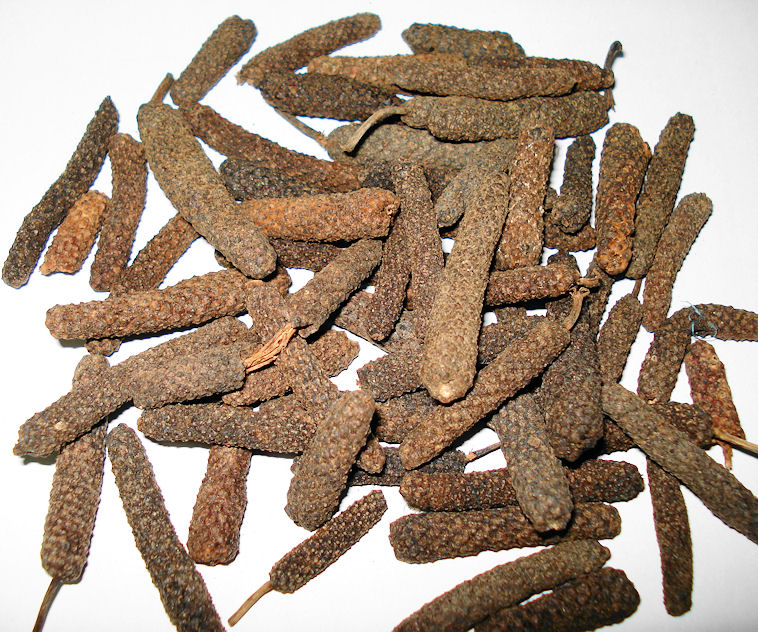
Abb.: पिप्पली । Piper longum L. 1753 - Langer Pfeffer - Long Pepper
[Bildquelle: Miansari66 / Wikimedia. -- Public domain]
marica n.: Piper nigrum L. 1753 - Echter Pfeffer - Pepper

Abb.: मरिचम् । Piper nigrum L. 1753 - Echter Pfeffer - Pepper
[Bildquelle: Miansari66 / Wikimedia. -- Public domain]
Garam masala - गरम मसाला - "heißes Gewürz"
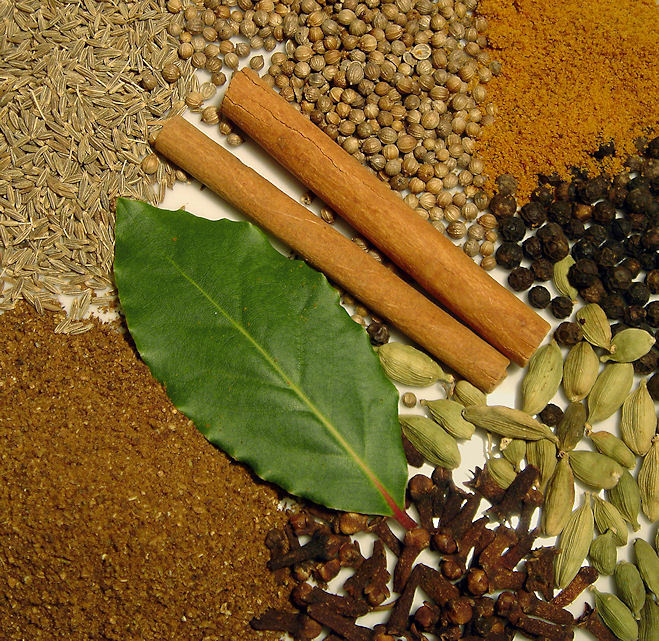
Abb.: Typische Gewürze für Garam masala - गरम मसाला - "heißes Gewürz" – im
Uhrzeigersinn von oben links:
Kreuzkümmel
Koriander
gemahlene Muskatblüte
schwarzer Pfeffer
Kardamomkapseln
Gewürznelken
gemahlene, fertige Mischung
In der Mitte:
Zimtstangen
Lorbeerblatt
[Bildquelle: Holger Casselmann / Wikipedia. -- GNU FDLizenz]
| 112a./b. trikaṭu tryūṣaṇaṃ vyoṣaṃ
triphalā tu phalatrikam त्रिकटु त्र्यूषणं व्योषं त्रिफला तु फलत्रिकम् ।११२ क। [Bezeichnungen für die Mischung der drei Myrobalanen:]
|
Colebrooke (1807): "Three myrobalans."
पथ्या-विभीति-धात्रिणां फलैः स्यात् त्रिफला समैः ।४२ क।
- "Pathyā [Terminalia chebula (Gaertn.) Retz. 1789 - Chebulische Myrobalane - Indian Myrobalan],
- vibhīta [Terminalia bellirica (Gaertn.) Roxb. 1805 - Belerische Myrobalane - Myrobalan] and
- dhātrī [Phyllanthus emblica L. 1753 - Ambla - Emblic Myrobalan]
mixed in equal quantitity is known as triphalā."
[Bhāvaprakāśa Bd. 1, S. 164.]
त्रिफला - triphalā f.: Dreifrucht
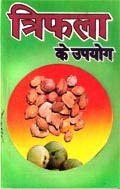
Abb.: त्रिफला ।
[Bildquelle:
http://swasthya-sukh.blogspot.com/2010/11/blog-post.html. -- Zugriff am
2011-10-06. -- Fair use]
फलत्रिक - phalatrika f.: Frucht-Dreiheit
pathyā f. - Terminalia chebula
(Gaertn.) Retz. 1789 - Chebulische Myrobalane - Indian Myrobalan
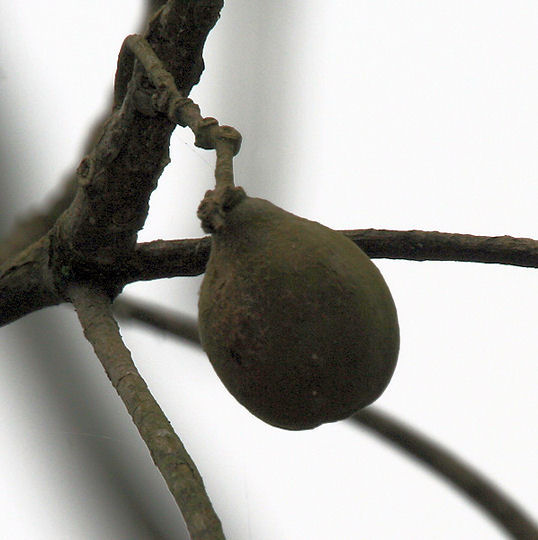
Abb.: पथ्या । Terminalia chebula (Gaertn.) Retz. - Chebulische
Myrobalane - Chebulic Myrobalan,
vibhīta m. - Terminalia bellirica (Gaertn.) Roxb. 1805 - Belerische Myrobalane - Myrobalan
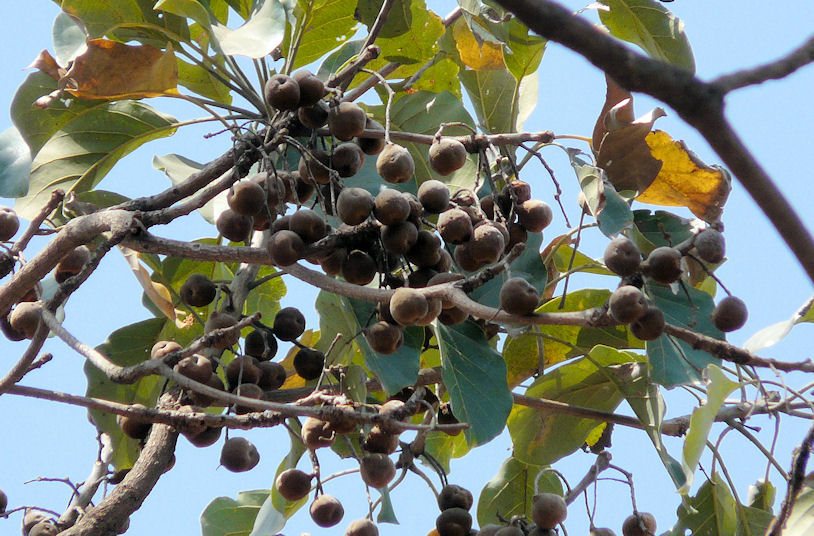
Abb.: विभीतः । Terminalia bellirica (Gaertn.) Roxb. - Belerische
Myrobalane - Beleric Myrobalan, Maharashtra
[Bildquelle: dinesh_valke. --
http://www.flickr.com/photos/dinesh_valke/3395011314/. -- Zugriff am
2010-10-13. --
Creative
Commons Lizenz (Namensnennung, keine kommerzielle Nutzung, share alike)]
dhātrī f. - Phyllanthus emblica L. 1753 - Ambla - Emblic Myrobalan

Abb.: धात्री । Phyllanthus emblica L. 1753 - Amblabaum - Emblic
Myrobalan
[Bildquelle: Chong Fat / Wikimedia. -- GNU FDLicens]
"MYROBALANS of commerce, yielded by the Terminalia chebula and Terminalia bellerica, are called also gall-nuts. They are oval fruits of a dingy yellow colour, containing much tannin; hence they are useful to the tanner as well as to the dyer. With alum, this fruit yields a good durable yellow ; and with salts of iron, a black colour, little inferior to that produced by oak-galls. The trees grow throughout India, Further India, and in parts of the Archipelago. Their dried fruits, the myrobalans, are largely exported from India, but in varying quantities [...]
When ripe, the fruit is pear-shaped, deeply wrinkled, of a brownish - yellow colour, and weighs from 70 to 100 grains. The husk contains the whole of the astringent matter, some mucilage, and a brownish-yellow colouring substance, which is used in India for dyeing yellow. The husk is usually separated by bruising the nut, which it encloses. The tannin of myrobalans differs slightly from that of galls. Gallic acid is present in rather large proportion.
Belleric myrobalan.
[...]
The belleric myrobalan is the fruit of the Terminalia bellerica ; in its dried state, is little larger than a gall-nut, but not so regular in shape, of a dirty brown colour and astringent taste. It is supposed to be similar in its properties to the chebulic myrobalan, but in a much weaker degree. It is much used in India as the basis of several colours, and also in medicine. It is sometimes used by the natives, in its dried state, in cases requiring slight astringents.
Chebulic myrobalan.
[...]
This is the fruit of the Terminalia chebula. In its dried state it is about the size of a large Spanish olive, of an oblong ovate shape, yellow-brown colour, and is marked with edges and furrows alternately. The tree is common in the Mysore country, Bengal, and in some parts of the Bombay Presidency. This fruit is very astringent, and is extensively used by the natives of India in their arts and manufactures. It is more astringent than the Aleppo galls. This myrobalan, well rubbed in conjunction with galls and catechu, is considered by the Vyteans as an excellent external application in the apthous affections of children and adults.
Six kinds of chebnlic myrobalans, all known as Helileh, are used in India,—
- Helilah-Zira, the fruit is dried when just formed, and the size of a cumin seed or zira.
- Helilah-i-Jawi, the fruit dried when the size of a jao or barley-corn.
- Helilah-i-Zingi, the fruit dried when of a larger size, arid black like a negro.
- Helilah-i-Chini, larger than Helilah-i-Zingi, and greenish.
- Helilah-i-Asfar, the fruit near maturity, and yellow (Asfar).
- Helilah-i-Kabuli, the fruit at full maturity.
Mature Kabul myrobalans sell for a rupee a piece in the Bombay market, under the name of Sarwar-i- Hindi."
[Quelle: Balfour, Edward <1813-1889>: Cyclopædia of India and of eastern and southern Asia, commercial, industrial and scientific: products of the mineral, vegetable and animal kingdoms, useful arts and manufactures / ed. by Edward Balfour. -- 3rd ed. -- London: Quaritch. -- Vol. 2. -- 1885. -- S. 1031f.]
"Terminalia Chebula (Roxb.) Description.--Tree, 40-50 feet; [...]
Fl. March-April.
W. & A. Prod. i. 313.--Roxb. Fl. Ind. ii. 433.--Cor. ii. t. 197.
Terminalia reticulata, Roth.
Peninsula. Bengal.
Medical Uses.—The Kadukai (gall-nuts) well rubbed with an equal proportion of catechu is used in aphthous complaints, and considered a valuable remedy. The unripe dried fruits, which are the Indian or black myrobolan (Kooroovillah-kadukai, Tam. and Mal.) of old writers, and which are sold in the Northern Provinces in Bengal, are recommended as purgative by the natives.—(Ainslie.) The gall-like excrescences found on the leaves, caused by the deposited ova of some insect* are held in great repute as an astringent by the natives. They are very efficacious remedies in infantile diarrhoea, the dose for a child under a year old being one grain every three hours. It has been administered in many instances with the greatest benefit.—(Pharm. of India.) The price and supposed efficacy of the fruit increase with the size; one weighing six tolahs would cost about 20 rupees. It acts internally as aperient, externally as an astringent applicati6n to ulcers and skin diseases.—Powel's Punj. Prod.
Economic Uses.—The outer coat of the fruit of this tree mixed with sulphate of iron makes a very durable ink. The galls are found on the leaves, and are produced by insects puncturing the tender leaves. With them and alum the best and most durable yellow is dyed, and in conjunction with ferruginous mud, black is procured from them. The fruit is very astringent, and on that account much used by the Hindoos in their arts and manufactures. The timber is good, of a yellowish-brown colour. It is used for agricultural purposes and for building. It attains its full size in thirty years.—Roxb."
[Quelle: Drury, Heber <1819 - 1872>: The useful plants of India : with notices of their chief value in commerce, medicine, and the arts. -- 2d ed. with additions and corrections. London : Allen, 1873. -- xvi, 512 p. ; 22 cm. -- s.v.]
"TERMINALIA CHEBULA, Retz. [...]
History Uses, &c.—There are several varieties of this tree, some of which have probably been produced by cultivation. T. citrina, Roxb., is considered by some to be a separate species. Dutt (Hindu Materia Medica) informs us that Chebulic myrobalans, in Sanskrit: Haritaki, Abhaya, and Pathya, were highly extolled by the ancient Hindus as a powerful alterative and tonic. They have received the names of Pranada or lifegiver, Sudha or nectar, Bhishakpriya or Physician's favourite and so forth. A mythological origin has also been attributed to the tree. "It is said that when Indra was drinking amrita, in heaven a drop of the fluid fell on the earth and produced the plant." On this account it is called Shakra-srishta " created by Indra."
Indian writers describe seven varieties of Haritaki, which however are nothing more than the same fruit in different stages of maturity. Very large fruit are considered particularly valuable, and fetch a fancy price. Chebulic myrobalans are considered to be laxative, stomachic, tonic, and alterative. They are prescribed alone or in combination with Emblic and Beleric myrobalans in a vast number of diseases, chiefly those affecting the chest and abdomen. The three myrobalans together are called triphala or the three-fruits in Sanskrit. Various original receipts for their administration will be found in Dutt's Hindu Materia Medica.
Myrobalans were known to the early Arabian writers, and through them to the Greek writer Actuarius, who mentions five kinds. Nicolas Myrepsicus also notices them. The author of the Makhzan-el-Adwiya, on the subject of chebulic myrobalans, says that the very young fruit, about the size of cumin seeds, are called Halileh-i-zira ; when about the size of a grain of barley, Halileh-i-jawi; when of the size of a raisin, Halileh-i-zangi or Halileh-i-hindi ; when half arrived at maturity and yellowish, Halileh-i-chini ; when still further advanced, Halileh-i-asfar; and lastly, when quite mature, Halileh-i-kabuli. Of these six varieties of chebulic myrobalans, the second, third, and last only are in general use for medicinal purposes, the fourth and fifth, also known as Rangsri har or hirade, are chiefly used by tanners. The Mahometans, like the Hindus, attribute a great many fanciful properties to the drug; shortly, we may say, that the ripe fruit is chiefly used as a purgative, and is considered to remove bile, phlegm, and adust bile; it should be combined with aromatics, such as fennel seeds, caraways, &c. The Arabs say,—"Halileh is in the stomach like an intelligent housewife, who is a good manager of the house." The unripe fruit (Halileh-i-hindi or Himaja) is most valued on account of its astringent and aperient properties, and is a useful medicine in dysentery and diarrhoea ; if should also be given with aromatics. Locally it is applied as an astringent. The first and second kind are supposed to have the same properties as the third in a less degree, and the forth and fifth the same as the sixth in a less degree.
The best way of administering myrobalans as a purgative is to make an infusion or decoction of from 2 to 4 drachms of fruit pulp with the addition of a pinch of caraway seeds and a little honey or sugar.
Ainslie notices their use as an application to aphthae. In the Pharmacopoeia of India, Dr. Waring mentions his having found six of the mature fruit an efficient and safe purgative, producing four or five copious stools, unattended by griping, nausea or other ill effects ; probably those used by him were not of the largest kind. Dr. Hove in his account of a visit to the Myrobalan Plantation at Bungar in the Concan in 1787, states that he found one fruit a sufficient purgative, though the manager of the plantation told him that two were generally used. Twining (Diseases of Bengal, Vol. I., p. 407,) speaks very favourably of the immature fruit (Halileh-i-zangi) as a tonic and aperient in enlargements of the abdominal viscera. We have found them a useful medicine in diarrhoea and dysentery, given in doses of a drachm twice a day. Recently, M. P. Apery has brought to the notice of the profession in Europe the value of these black myrobalans in dysentery, choleraic diarrhoea, and chronic diarrhoea; he administers them in pills of 25 centigrams each, the dose being from 4 to 12 pills or even more in the 24 hours. (Journ. de Pharm. et de Chim. Feb. 1st, 188S.)
Roxburgh states that the tender leaves, while scarce unfolded, are said to be punctured by an an insect, and its eggs deposited therein, which by the extravasation of the sap, become enlarged into hollow galls of various shapes and sizes, but rarely exceeding an inch in diameter. They are powerfully astringent, and make as good ink as oak galls. They also yield the chintz painters on the coast of Coromandel their best and most durable yellow. They are called by the Tamils Kadu-cai-pu, and by the Telingas Aldicai, (Fl. Ind. II., 435.) In the Pharmacopceia of India they are noticed on the authority of the Rev. J. Kearns of Tinnevelly as a valuable astringent in diarrhoea. The Himalayan tribes eat the kernels of this myrobalan, and use the fruit as a remedy for sore throat under the name of Khoki."
[Quelle: Pharmacographia indica : a history of the principal drugs of vegetable origin met with in British India / by William Dymock [1834-1892], C. J. H. Warden and David Hooper [1858-1947]. -- Bd. 2. -- London, 1891. -- S. 1-3.]
"Terminalia Bellerica (Roxb.) Belleric Myrobalen.
Description.--Tree, 100 feet; [...]
Fl. March-April.
W. & A. Prod. i. 313.--Wight Ill. i. t. 91.--Roxb. Fl. Ind. ii. 431.--Cor. ii. t. 198.--Rheede iv. t. 10.
Peninsula. Bengal.
Medical Uses.—A quantity of insipid gum, resembling Gum- Arabic, issues from the trunk when wounded; soluble in water, but inflammable, and will burn like a candle. The kernel of the nut is said to intoxicate if eaten in any great quantity. Mixed with honey it is used in ophthalmia. The fruit in its dried state is larger than a gall-nut, but not so regular in shape. It is astringent in taste, and is tonic and attenuant.—(Ainslie. Roxb.) It is also used in dropsy, diarrhoea, piles, and leprosy, as well as for coughs. In large doses it becomes a narcotic poison. The produce of a single tree will sometimes sell for 2000 rupees. The fruit ripens about October, and consists of a nut enclosed in a thin exterior rind. It is used as an aperient, and also forms a dingy yellow dye. The fruit is exported by traders from the plains, who generally contract for each tree according to the produce it bears. A single nut sometimes sells for a rupee.—(Barnes in Powel's Punj. Prod.) These fruits are procurable at a nominal cost throughout India; and when other aperients are not available, may safely be resorted to. Their astringency renders them valuable in the arts, as well as a substitute for galls for lotions, injections, and so on. Twining (Diseases of Bengal) gives a case of enlargement of the spleen where this medicine was used with the best effects.—Pharm. of India.
Economic Uses.—The wood is white and durable, good for working purposes, large chests, and shipbuilding.—Roxb."
[Quelle: Drury, Heber <1819 - 1872>: The useful plants of India : with notices of their chief value in commerce, medicine, and the arts. -- 2d ed. with additions and corrections. London : Allen, 1873. -- xvi, 512 p. ; 22 cm. -- s.v.]
"TERMINALIA BELERICA, Roxb. [...]
History, Uses, &C.—This tree, in Sanskrit Vibhita and Vibhitaka (fearless), is avoided by the Hindus of Northern India, who will not sit in its shade, as it is supposed to be inhabited by demons. Two varieties of T. belerica arc found in India, one with nearly globular fruit. 1/2 to 3/4 inch in diameter, the other with ovate and much larger fruit. The pulp of the fruit (Beleric myrobalan) is considered by Hindu physicians to be astringent and laxative, and is prescribed with salt and long pepper in affections of the throat and chest. As a constituent of the triphala (three fruits), i.e., emblic, beleric and chebulic myrobalans, it is fed in a great number of diseases, and the kernel is sometimes used as an external application to inflamed parts. On account of its medicinal properties the tree bears the Sanskrit synonym of Anila-ghnaka, or "wind-killing". According to the Nighantas the kernels are narcotic.
Mahometan writers describe Balilaj (the beleric myrobalan) as astringent, tonic, digestive, attenuant, and aperient, and useful as an astringent application to the eyes. As long as the doctrines of the Arabian school prevailed, myrobalans were used medicinally in Europe, havin being introduced by the Arabs from India.
The μυροβαλανοσ of the classical Greek and Latin writers was a fruit from which the perfumers obtained oil for their unguents. According to Theophrastus, the outer cortical portion was pounded to extract the oil, as that part only was sweet smelling. It is uncertain what this fruit was, but it appears to have been something similar to that of the African oil palm (Elaeis guineensis), the outer fleshy coating of which yields an oil of the consistence of butter, having a rather pleasant violet-like odour when fresh. The later Greek physicians apply the terms μυροβαλανοσ and μυρεψικοσ to Indian myrobalans.
T. belerica produces a quantity of gum of the Bassora type, which is collected and mixed with soluble gums for sale as country gum.
[...]
Commerce.—Myrobalans are one of the principal forest products of India; they are collected in large quantities on Government account, and yearly auctions are held by the Forest Conservancy Department. Both chebulic and beleric myrobalans are largely exported for tanning and dyeing. The exports from the whole of India were .—In 1885-86, 706,000 cwts., valued at 30 lakhs of rupees ; in 1886-87, 597,000 cwts., valued at 23 lakhs of rupees ; in 1887-88, 678,000 cwts., valued at 25 lakhs of rupees."
[Quelle: Pharmacographia indica : a history of the principal drugs of vegetable origin met with in British India / by William Dymock [1834-1892], C. J. H. Warden and David Hooper [1858-1947]. -- Bd. 2. -- London, 1891. -- S. 5f.]
"Emblica officinalis (Gaertn.) N. O. Euphorbiaceae. Description.--Tree; [...]
Fl. April-Nov.--Wight Icon. t. 1896.
Phyllanthus emblica, Linn.--Roxb. Fl. Ind. iii. 671.--Rheede i. t. 38.
Coromandel. Malabar. Deccan. Bengal.
Medical Uses.—The seeds are given internally as a cooling remedy in bilious affections and nausea, and in infusion make a good drink in fevers. They are also used in diabetes. Infusion of the leaves is applied to sore eyes. Bark of the root mixed with honey is applied to aphthous inflammations of the mouth. The bark of the tree itself is astringent, and is used for tanning purposes. It is medicinally used in diarrhea. The fruit is occasionally pickled, or preserved in sugar. When dry it is said to be gently laxative. In the latter state the decoction is employed in fevers, and mixed with sugar and drunk in vertigo. The young leaves mixed with sour milk are given by the natives in dysentery. In Travancore the natives put the young branches into the wells to impart a pleasant flavour to the water, especially if it be impure from the accumulation of vegetable matter or other causes.—(Ainslie. Rheede.) Antiscorbutic virtues have been attributed to the fruits, which are known as the Emblic Myrobalans. The flowers are employed by the Hindoo doctors for their supposed refrigerant and aperient qualities. The bark partakes of the astringency of the fruit. Dr A. Boss prepared, by decoction and evaporation, from the root, an astringent extract equal to catechu both for medicine and the arts.—Pharm. of India.
Economic Uses.—This tree yields a valuable timber."
[Quelle: Drury, Heber <1819 - 1872>: The useful plants of India : with notices of their chief value in commerce, medicine, and the arts. -- 2d ed. with additions and corrections. London : Allen, 1873. -- xvi, 512 p. ; 22 cm. -- s.v.]
"PHYLLANTHUS EMBLICA, Linn. Emblic myrobalan
[...]
History, Uses, &c.--The fruit of this tree is the Dhātriphala, Amritaphala, Amalaka or Sriphala of the Nighantas, and is described as having all the properties of the chebulic myrobalan. It is used both fresh and dried; in the former condition it is considered to be refrigerant, diuretic and laxative; in the latter, astringent. It is pickled by the natives, and, on account of a peculiar flavour which it imparts, some of the forest tribes eat it before drinking water. A sherbet of the fruit, sweetened, with sugar or honey, is a favourite cooling drink for sick people; it is said to be diuretic. A country-side prescription for biliousness in the Concan is Avala, 4 massas, to be soaked all night in water, and in the morning to be pounded and mixed with a quarter seer of milk and flavoured with sugar and cumin. Emblic myrobalans are an ingredient in many compound preparations described in Sanskrit works. A selection of these prescriptions will be found in Dutt's Hindu Materia Medica; the following, translated from Chakradatta, may be taken as an example:-
"Dhātri lauha. -Take of powdered Emblic myrobalans 64 tolās, prepared iron 32 tolās, liquorice powder 16 tolās, mix them together, and soak in the juice of Tinospora cordifolia seven times successively. This preparation is given in jaundice, anaemia and dyspepsia, in doses of from 20 to 40 grains."
Mahometan physicians esteem this myrobalan equally with the Hindus; they describe it as astringent, refrigerant, cardiacal, and a purifier of the humours of the body. It is much prescribed by them in fluxes, and is also applied externally on account of its cooling and astringent properties. The Arabic name is Amlaj, and the Persian Amala. Ainslie states that the flowers, which have an odour resembling that of lemon peel, are supposed by the Vytians to have virtues of a cooling and aperient nature, and are prescribed in conjunction with other articles in the form of an electuary. (Mat. Ind., ii., p. 244.) In the Pharmacopoeia of India it is stated, upon the authority of Dr. Ae. Ross, that the root by decoction and evaporation yields an astringent extract equal to catechu, both for medicinal purposes and in the arts; the chips of the wood or small branches thrown into impure or muddy water, according to the same authority, clear it effectually. In the Concan the juice of the fresh bark, with honey and turmeric, is given in gonorrhoea.
[...]
Commerce. -Two kinds of Avala are found in commerce, one entire, and the other cut up, and the nut removed. The fruit is collected in many parts of India. Value, about Rs. 32 per candy of 7 cwts."
[Quelle: Pharmacographia indica : a history of the principal drugs of vegetable origin met with in British India / by William Dymock [1834-1892], C. J. H. Warden and David Hooper [1858-1947]. -- Bd. 3. -- London, 1893. -- S. 261ff.]
| | iti vaiśyavargaḥ 9, atra mūlaślokāḥ 111 इति वैश्यवर्गः ९, अत्र मूलश्लोकाः १११ ॥ Ende des Abschnitts über die Vaiśyas. Er enthält 111 Verse. |